A Review of the Serrated-Flow Phenomenon and Its Role in the Deformation Behavior of High-Entropy Alloys
Abstract
1. Introduction
1.1. High-Entropy Alloys
1.2. The Serrated-Flow Phenomenon
1.3. Mechanisms of Serrated Flow
1.4. Types of Serrated Flow
1.5. Factors Affecting Serrated Flow
2. Modeling and Analytical Techniques
2.1. Complexity Modeling and Analysis
2.1.1. Approximate Entropy Algorithm
2.1.2. Refined Composite Multiscale Entropy Methods
2.2. Multifractal Modeling and Analysis
2.3. Mean-Field Theory and the Mean-Field Interaction Model
2.4. Chaos Analysis
3. Serration Studies in HEAs
3.1. Al0.5CoCrCuFeNi HEA
3.2. Al0.1CoCrFeNi HEA
3.3. Al0.3CoCrFeNi HEA
3.4. Al0.5CoCrFeNi HEA
3.5. Al0.7CoCrFeNi HEA
3.6. AlxNbTiMoV HEA
3.7. Al5Cr12Fe35Mn28Ni20 HEA
3.8. Ag0.5CoCrCuFeNi HEA
3.9. CoCrFeMnNi HEA (Cantor Alloy)
3.10. CoCuFeNiTi HEA
3.11. CoCuFeMnNi HEA
3.12. CoCrFeNi HEA
3.13. HfNbTaTiZr HEA
4. Summary and Future Directions
- At cryogenic temperatures (4.2–77 K, or from –269 to 196 °C), twinning is the primary mechanism of the serrated flow by hindering dislocation motion at twin boundaries.
- In most cases, serrations have been reported to occur at temperatures ranging from RT to 1100 °C and are a consequence of the pinning and unpinning of dislocations by solute atoms.
- The extent of the serrations in this temperature regime (RT to 1100 °C) initially increases with temperature due to the increased migration speed of pinning solutes until it reaches a maximum. After reaching the maximum, the extent of serrations decreases with temperature due to the increasing thermal vibration of solutes that reduces their ability to pin dislocations.
- At temperatures between the cryogenic regime and RT, serrated flows have not been observed. In this temperature range, solute atoms are not mobile enough to catch and pin moving dislocations, thus resulting in a lack of observable serrations during plastic deformation.
- Additive solutes, such as C and Al, play an important role in the serrated flow behavior in HEAs.
- The phase structure as well as the presence of nanoparticles (such as L12) in the matrix may play a role in the serration behavior.
- The serration types reported include Types A, B, C, A + B, and B + C.
- The serration type depends on temperature. For example, Type-A serrations generally occur at lower temperatures, as compared to Type-B and Type-C serrations.
- The serration type also depends on strain rate. Typically, Type-C serrations are observed at lower strain rates while Types A and B are seen at relatively higher strain rates.
- For strain rates less than 1 s−1, the extent of serrations in HEAs increases with decreasing strain rate. This increase is due to the slowing down of dislocations, thus allowing solute atoms to more easily catch and pin dislocations.
- For strain rates greater than 103 s−1, the extent of serrations increases with an increase strain rate due to the increase in twinning mechanisms.
- Multiple techniques, including complexity analysis, multifractal analysis, mean-field theory analysis, and chaos analysis, have been successfully employed to analyze and model the serrated flow behavior in HEAs.
5. Conclusions
Author Contributions
Funding
Conflicts of Interest
References
- Yeh, J.W.; Chen, S.K.; Gan, J.Y.; Lin, S.J.; Chin, T.S.; Shun, T.T.; Tsau, C.H.; Chang, S.Y. Formation of simple crystal structures in Cu-Co-Ni-Cr-Al-Fe-Ti-V alloys with multiprincipal metallic elements. Metall. Mater. Trans. A Phys. Metall. Mater. Sci. 2004, 35, 2533–2536. [Google Scholar] [CrossRef]
- Yeh, J.W.; Chen, S.K.; Lin, S.J.; Gan, J.Y.; Chin, T.S.; Shun, T.T.; Tsau, C.H.; Chang, S.Y. Nanostructured high-entropy alloys with multiple principal elements: Novel alloy design concepts and outcomes. Adv. Eng. Mater. 2004, 6, 299–303. [Google Scholar] [CrossRef]
- Chen, T.K.; Shun, T.T.; Yeh, J.W.; Wong, M.S. Nanostructured nitride films of multi-element high-entropy alloys by reactive DC sputtering. Surf. Coat. Technol. 2004, 188–189, 193–200. [Google Scholar] [CrossRef]
- Hsu, C.-Y.; Yeh, J.-W.; Chen, S.-K.; Shun, T.-T. Wear resistance and high-temperature compression strength of Fcc CuCoNiCrAl0.5Fe alloy with boron addition. Metall. Mater. Trans. A 2004, 35, 1465–1469. [Google Scholar] [CrossRef]
- Huang, P.-K.; Yeh, J.-W.; Shun, T.-T.; Chen, S.-K. Multi-principal-element alloys with improved oxidation and wear resistance for thermal spray coating. Adv. Eng. Mater. 2004, 6, 74–78. [Google Scholar] [CrossRef]
- Miracle, D.B. High-entropy alloys: A current evaluation of founding ideas and core effects and exploring “nonlinear alloys”. JOM 2017, 69, 2130–2136. [Google Scholar] [CrossRef]
- Hsu, C.Y.; Wang, W.R.; Tang, W.Y.; Chen, S.K.; Yeh, J.W. Microstructure and mechanical properties of new AlCoxCrFeMo0.5Ni high-entropy alloys. Adv. Eng. Mater. 2010, 12, 44–49. [Google Scholar] [CrossRef]
- Zhang, Y.; Liu, J.P.; Chen, S.Y.; Xie, X.; Liaw, P.K.; Dahmen, K.A.; Qiao, J.W.; Wang, Y.L. Serration and noise behaviors in materials. Prog. Mater. Sci. 2017, 90, 358–460. [Google Scholar] [CrossRef]
- Zhang, Y.; Zuo, T.T.; Tang, Z.; Gao, M.C.; Dahmen, K.A.; Liaw, P.K.; Lua, Z.P. Microstructures and properties of high-entropy alloys. Prog. Mater. Sci. 2014, 61, 1–93. [Google Scholar] [CrossRef]
- Cantor, B.; Chang, I.T.H.; Knight, P.; Vincent, A.J.B. Microstructural development in equiatomic multicomponent alloys. Mater. Sci. Eng. A Struct. Mater. Prop. Microstruct. Process. 2004, 375, 213–218. [Google Scholar] [CrossRef]
- Gao, M.C.; Carney, C.S.; Doğan, Ö.N.; Jablonksi, P.D.; Hawk, J.A.; Alman, D.E. Design of refractory high-entropy alloys. JOM 2015, 67, 2653–2669. [Google Scholar] [CrossRef]
- Haas, S.; Mosbacher, M.; Senkov, O.N.; Feuerbacher, M.; Freudenberger, J.; Gezgin, S.; Völkl, R.; Glatzel, U. Entropy determination of single-phase high entropy alloys with different crystal structures over a wide temperature range. Entropy 2018, 20, 654. [Google Scholar] [CrossRef]
- Yeh, J.-W. Alloy design strategies and future trends in high-entropy alloys. JOM 2013, 65, 1759–1771. [Google Scholar] [CrossRef]
- Eißmann, N.; Klöden, B.; Weißgärber, T.; Kieback, B. High-entropy alloy CoCrFeMnNi produced by powder metallurgy. Powder Metall. 2017, 60, 184–197. [Google Scholar] [CrossRef]
- Ruiz-Yi, B.; Bunn, J.K.; Stasak, D.; Mehta, A.; Besser, M.; Kramer, M.J.; Takeuchi, I.; Hattrick-Simpers, J. The different roles of entropy and solubility in high entropy alloy stability. ACS Comb. Sci. 2016, 18, 596–603. [Google Scholar] [CrossRef]
- Cantor, B. Multicomponent and high entropy alloys. Entropy 2014, 16, 4749–4768. [Google Scholar] [CrossRef]
- Lee, C.; Song, G.; Gao, M.C.; Feng, R.; Chen, P.; Brechtl, J.; Chen, Y.; An, K.; Guo, W.; Poplawsky, J.D.; et al. Lattice distortion in a strong and ductile refractory high-entropy alloy. Acta Mater. 2018, 160, 158–172. [Google Scholar] [CrossRef]
- Miracle, D.B.; Senkov, O.N. A critical review of high entropy alloys and related concepts. Acta Mater. 2017, 122, 448–511. [Google Scholar] [CrossRef]
- Tsai, K.Y.; Tsai, M.H.; Yeh, J.W. Sluggish diffusion in Co-Cr-Fe-Mn-Ni high-entropy alloys. Acta Mater. 2013, 61, 4887–4897. [Google Scholar] [CrossRef]
- Tsai, M.-H.; Wang, C.-W.; Tsai, C.-W.; Shen, W.-J.; Yeh, J.-W.; Gan, J.-Y.; Wu, W.-W. Thermal stability and performance of NbSiTaTiZr high-entropy alloy barrier for copper metallization. J. Electrochem. Soc. 2011, 158, H1161. [Google Scholar] [CrossRef]
- Hsu, C.-Y.; Juan, C.-C.; Wang, W.-R.; Sheu, T.-S.; Yeh, J.-W.; Chen, S.-K. On the superior hot hardness and softening resistance of AlCoCrxFeMo0.5Ni high-entropy alloys. Mater. Sci. Eng. A 2011, 528, 3581–3588. [Google Scholar] [CrossRef]
- Paul, A. Comments on “Sluggish diffusion in Co-Cr-Fe-Mn-Ni high-entropy alloys” by KY Tsai, MH Tsai and JW Yeh, Acta Materialia 61 (2013) 4887–4897. Scr. Mater. 2017, 135, 153–157. [Google Scholar] [CrossRef]
- Tsai, K.Y.; Tsai, M.H.; Yeh, J.W. Reply to comments on “Sluggish diffusion in Co-Cr-Fe-Mn-Ni high-entropy alloys” by KY Tsai, MH Tsai and JW Yeh, Acta Materialia 61 (2013) 4887–4897. Scr. Mater. 2017, 135, 158–159. [Google Scholar] [CrossRef]
- Beke, D.L.; Erdélyi, G. On the diffusion in high-entropy alloys. Mater. Lett. 2016, 164, 111–113. [Google Scholar] [CrossRef]
- Zhang, C.; Zhang, F.; Jin, K.; Bei, H.B.; Chen, S.L.; Cao, W.S.; Zhu, J.; Lv, D.C. Understanding of the elemental diffusion behavior in concentrated solid solution alloys. J. Phase Equilibria Diffus. 2017, 38, 434–444. [Google Scholar] [CrossRef]
- Pickering, E.J.; Jones, N.G. High-entropy alloys: A critical assessment of their founding principles and future prospects. Int. Mater. Rev. 2016, 61, 183–202. [Google Scholar] [CrossRef]
- Murty, B.S.; Yeh, J.W.; Ranganathan, S.; Bhattacharjee, P.P. High-Entropy Alloys; Elsevier Science: Amsterdam, The Netherlands, 2019. [Google Scholar]
- Yeh, J.-W. Physical metallurgy of high-entropy alloys. JOM 2015, 67, 2254–2261. [Google Scholar] [CrossRef]
- Zhang, Y.; Zuo, T.; Cheng, Y.; Liaw, P.K. High-entropy alloys with high saturation magnetization, electrical resistivity and malleability. Sci. Rep. 2013, 3, 1455. [Google Scholar] [CrossRef]
- Chou, Y.L.; Wang, Y.C.; Yeh, J.W.; Shih, H.C. The effect of molybdenum on the corrosion behaviour of the high-entropy alloys Co1.5CrFeNi1.5Ti0.5Mox in aqueous environments. Corros. Sci. 2010, 52, 1026–1034. [Google Scholar] [CrossRef]
- Kao, Y.F.; Lee, T.D.; Chen, S.K.; Chang, Y.S. Electrochemical passive properties of AlxCoCrFeNi (x = 0, 0.25, 0.50, 1.00) alloys in sulfuric acids. Corros. Sci. 2017, 52, 1026–1034. [Google Scholar] [CrossRef]
- Shi, Y.; Yang, B.; Xie, X.; Brechtl, J.; Dahmen, K.A.; Liaw, P.K. Corrosion of AlxCoCrFeNi high-entropy alloys: Al-content and potential scan-rate dependent pitting behavior. Corros. Sci. 2017, 119, 33–45. [Google Scholar] [CrossRef]
- Tang, Z.; Huang, L.; He, W.; Liaw, P.K. Alloying and processing effects on the aqueous corrosion behavior of high-entropy alloys. Entropy 2014, 16, 895–911. [Google Scholar] [CrossRef]
- Nair, R.B.; Arora, H.S.; Mukherjee, S.; Singh, S.; Singh, H.; Grewel, H.S. Exceptionally high cavitation erosion and corrosion resistance of a high entropy alloy. Ultrason. Sonochem. 2018, 41, 252–260. [Google Scholar] [CrossRef]
- Shi, Y.Z.; Yang, B.; Liaw, P.K. Corrosion-resistant high-entropy alloys: A review. Metals 2017, 7, 43. [Google Scholar] [CrossRef]
- Hemphill, M.A.; Yuan, T.; Wang, G.Y.; Yeh, J.W.; Tsai, C.W.; Chuang, A.; Liaw, P.K. Fatigue behavior of Al0.5CoCrCuFeNi high entropy alloys. Acta Mater. 2012, 60, 5723–5734. [Google Scholar] [CrossRef]
- Seifi, M.; Li, D.Y.; Yong, Z.; Liaw, P.K.; Lewandowski, J.J. Fracture toughness and fatigue crack growth behavior of as-cast high-entropy alloys. JOM 2015, 67, 2288–2295. [Google Scholar] [CrossRef]
- Thurston, K.V.S.; Gludovatz, B.; Hohenwarter, A.; Laplanche, G.; George, E.P.; Ritchie, R.O. Effect of temperature on the fatigue-crack growth behavior of the high-entropy alloy CrMnFeCoNi. Intermetallics 2017, 88, 65–72. [Google Scholar] [CrossRef]
- Tang, Z.; Yuan, T.; Tsai, C.W.; Yeh, J.W.; Lundin, C.D.; Liaw, P.K. Fatigue behavior of a wrought Al0.5CoCrCuFeNi two-phase high-entropy alloy. Acta Mater. 2015, 99, 247–258. [Google Scholar] [CrossRef]
- Chen, P.Y.; Lee, C.; Wang, S.Y.; Seifi, M.; Lewandowski, J.J.; Dahmen, K.A.; Jia, H.L.; Xie, X.; Chen, B.L.; Yeh, J.W.; et al. Fatigue behavior of high-entropy alloys: A review. Sci. China Technol. Sci. 2018, 61, 168–178. [Google Scholar] [CrossRef]
- Liu, K.M.; Komarasamy, M.; Gwalani, B.; Shukla, S.; Mishra, R.S. Fatigue behavior of ultrafine grained triplex Al0.3CoCrFeNi high entropy alloy. Scr. Mater. 2019, 158, 116–120. [Google Scholar] [CrossRef]
- Gao, X.; Lu, Y.; Zhang, B.; Liang, N.; Wu, G.; Sha, G.; Liu, J.; Zhao, Y. Microstructural origins of high strength and high ductility in an AlCoCrFeNi2.1 eutectic high-entropy alloy. Acta Mater. 2017, 141, 59–66. [Google Scholar] [CrossRef]
- Koch, C.C. Nanocrystalline high-entropy alloys. J. Mater. Res. 2017, 32, 3435–3444. [Google Scholar] [CrossRef]
- Lilensten, L.; Couzinie, J.-P.; Perriere, L.; Hocini, A.; Keller, C.; Dirras, G.; Guillot, I. Study of a BCC multi-principal element alloy: Tensile and simple shear properties and underlying deformation mechanisms. Acta Mater. 2018, 142, 131–141. [Google Scholar] [CrossRef]
- Cai, B.; Liu, B.; Kabra, S.; Wang, Y.; Yan, K.; Lee, P.K.; Liu, Y. Deformation mechanisms of Mo alloyed FeCoCrNi high entropy alloy: In situ neutron diffraction. Acta Mater. 2017, 127, 471–480. [Google Scholar] [CrossRef]
- Gludovatz, B.; Hohenwarter, A.; Catoor, D.; Chang, E.H.; George, E.P.; Ritchie, R.O. A fracture-resistant high-entropy alloy for cryogenic applications. Science 2014, 345, 1153–1158. [Google Scholar] [CrossRef]
- George, E.P.; Raabe, D.; Ritchie, R.O. High-entropy alloys. Nat. Rev. Mater. 2019, 4, 515–534. [Google Scholar] [CrossRef]
- Li, Z.; Zhao, S.; Diao, H.; Liaw, P.K.; Meyers, M.A. High-velocity deformation of Al0.3CoCrFeNi high-entropy alloy: Remarkable resistance to shear failure. Sci. Rep. 2017, 7, 42742. [Google Scholar] [CrossRef]
- Egami, T.; Guo, W.; Rack, P.D.; Nagase, T. Irradiation resistance of multicomponent alloys. Metall. Mater. Trans. A 2014, 45A, 180–183. [Google Scholar] [CrossRef]
- Xia, S.Q.; Yang, X.; Yang, T.F.; Liu, S.; Zhang, Y. Irradiation resistance in AlxCoCrFeNi high entropy alloys. JOM 2015, 67, 2340–2344. [Google Scholar] [CrossRef]
- Xia, S.; Gao, M.C.; Yang, T.; Liaw, P.K.; Zhang, Y. Phase stability and microstructures of high entropy alloys ion irradiated to high doses. J. Nucl. Mater. 2016, 480, 100–108. [Google Scholar] [CrossRef]
- Kumar, N.A.P.K.; Li, C.; Leonard, K.J.; Bei, H.; Zinkle, S.J. Microstructural stability and mechanical behavior of FeNiMnCr high entropy alloy under ion irradiation. Acta Mater. 2016, 113, 230–244. [Google Scholar] [CrossRef]
- Yang, T.; Xia, S.; Liu, S.; Wang, C.; Liu, S.; Fang, Y.; Zhang, Y.; Xue, J.; Yan, S.; Wang, Y. Precipitation behavior of AlxCoCrFeNi high entropy alloys under ion irradiation. Sci. Rep. 2016, 6, 32146. [Google Scholar] [CrossRef] [PubMed]
- Xia, S.-Q.; Wang, Z.; Yang, T.-F.; Zhang, Y. Irradiation behavior in high entropy alloys. J. Iron Steel Res. 2015, 22, 879–884. [Google Scholar] [CrossRef]
- He, M.-R.; Wang, S.; Jin, K.; Bei, H.; Yasuda, K.; Matsumura, S.; Higashida, K.; Robertson, I.M. Enhanced damage resistance and novel defect structure of CrFeCoNi under in situ electron irradiation. Scr. Mater. 2016, 125, 5–9. [Google Scholar] [CrossRef]
- Yang, T.; Xia, S.; Guo, W.; Hu, R.; Poplawsky, J.D.; Sha, G.; Fang, Y.; Yan, Z.; Wang, C.; Li, C.; et al. Effects of temperature on the irradiation responses of Al0.1CoCrFeNi high entropy alloy. Scr. Mater. 2018, 144, 31–35. [Google Scholar] [CrossRef]
- Zhang, Y.; Stocks, G.M.; Jin, K.; Lu, C.; Bei, H.; Sales, B.C.; Wang, L.; Béland, L.K.; Stoller, R.E.; Samolyuk, G.D.; et al. Influence of chemical disorder on energy dissipation and defect evolution in concentrated solid solution alloys. Nat. Commun. 2015, 6, 8736. [Google Scholar] [CrossRef]
- Yang, T.; Li, C.; Zinkle, S.J.; Zhao, S.; Bei, H.; Zhang, Y. Irradiation responses and defect behavior of single-phase concentrated solid solution alloys. J. Mater. Res. 2018, 33, 3077–3091. [Google Scholar] [CrossRef]
- Ching, W.-Y.; San, S.; Brechtl, J.; Sakidja, R.; Zhang, M.; Liaw, P.K. Fundamental electronic structure and multiatomic bonding in 13 biocompatible high-entropy alloys. NPJ Comput. Mater. 2020, 6, 45. [Google Scholar] [CrossRef]
- Todai, M.; Nagase, T.; Hori, T.; Matsugaki, A.; Sekita, A.; Nakano, T. Novel TiNbTaZrMo high-entropy alloys for metallic biomaterials. Scr. Mater. 2017, 129, 65–68. [Google Scholar] [CrossRef]
- Yang, W.; Liu, Y.; Pang, S.; Liaw, P.K.; Zhang, T. Bio-corrosion behavior and in vitro biocompatibility of equimolar TiZrHfNbTa high-entropy alloy. Intermetallics 2020, 124, 106845. [Google Scholar] [CrossRef]
- Jo, Y.H.; Jung, S.; Choi, W.M.; Sohn, S.S.; Kim, H.S.; Lee, B.J.; Kim, N.J.; Lee, S. Cryogenic strength improvement by utilizing room-temperature deformation twinning in a partially recrystallized VCrMnFeCoNi high-entropy alloy. Nat. Commun. 2017, 8, 15719. [Google Scholar] [CrossRef] [PubMed]
- Li, D.; Li, C.X.; Feng, T.; Zhang, Y.D.; Sha, G.; Lewandowski, J.J.; Liaw, P.K.; Zhang, Y. High-entropy Al0.3CoCrFeNi alloy fibers with high tensile strength and ductility at ambient and cryogenic temperatures. Acta Mater. 2017, 123, 285–294. [Google Scholar] [CrossRef]
- Qiao, J.W.; Ma, S.G.; Huang, E.W.; Chuang, C.P.; Liaw, P.K.; Zhang, Y. Microstructural characteristics and mechanical behaviors of AlCoCrFeNi high-entropy alloys at ambient and cryogenic temperatures. In Nano-Scale and Amourphous Materials; Wang, R.M., Wu, Y., Wu, X.F., Eds.; Trans Tech Publications Ltd.: Durnten-Zurich, Switzerland, 2011; Volume 688, pp. 419–425. [Google Scholar]
- Lyu, Z.; Fan, X.; Lee, C.; Wang, S.-Y.; Feng, R.; Liaw, P.K. Fundamental understanding of mechanical behavior of high-entropy alloys at low temperatures: A review. J. Mater. Res. 2018, 33, 2998–3010. [Google Scholar] [CrossRef]
- Chuang, M.-H.; Tsai, M.H.; Wang, W.R.; Lin, S.J.; Yeh, J.W. Microstructure and wear behavior of AlxCo1.5CrFeNi1.5Tiy high-entropy alloys. Acta Mater. 2011, 59, 6308–6317. [Google Scholar] [CrossRef]
- Chuang, M.-H.; Tsai, M.-H.; Tsai, C.-W.; Yang, N.-H.; Chang, S.-Y.; Yeh, J.-W.; Chen, S.-K.; Lin, S.-J. Intrinsic surface hardening and precipitation kinetics of Al0.3CrFe1.5MnNi0.5 multi-component alloy. J. Alloys Compd. 2013, 551, 12–18. [Google Scholar] [CrossRef]
- Diao, H.Y.; Feng, R.; Dahmen, K.A.; Liaw, P.K. Fundamental deformation behavior in high-entropy alloys: An overview. Curr. Opin. Solid State Mater. Sci. 2017, 21, 252–266. [Google Scholar] [CrossRef]
- Stevenson, A.; Waite, M. Concise Oxford English Dictionary: Luxury Edition; OUP Oxford: New York, NY, USA, 2011. [Google Scholar]
- Moyer, J.K.; Bemis, W.E. Shark teeth as edged weapons: Serrated teeth of three species of selachians. Zoology 2017, 120, 101–109. [Google Scholar] [CrossRef]
- Stefanita, C.G. From Bulk to Nano: The Many Sides of Magnetism; Springer: Berlin/Heidelberg, Germany, 2008. [Google Scholar]
- Mascarenas, D.; Lockhart, M.; Lienert, T. Barkhausen noise as an intrinsic fingerprint for ferromagnetic components. Smart Mater. Struct. 2019, 28, 17. [Google Scholar] [CrossRef]
- Bohn, F.; Durin, G.; Correa, M.A.; Machado, N.R.; Della Pace, R.D.; Chesman, C.; Sommer, R.L. Playing with universality classes of Barkhausen avalanches. Sci. Rep. 2018, 8, 12. [Google Scholar] [CrossRef]
- Travesset, A.; White, R.A.; Dahmen, K.A. Crackling noise, power spectra, and disorder-induced critical scaling. Phys. Rev. B 2002, 66, 11. [Google Scholar] [CrossRef]
- Varotsos, P.A.; Sarlis, N.V.; Skordas, E.S.; Lazaridou-Varotsos, M.S. MW9 tohoku earthquake in 2011 in Japan: Precursors uncovered by natural time analysis. Earthq. Sci. 2017, 30, 183–191. [Google Scholar] [CrossRef][Green Version]
- Uhl, J.T.; Pathak, S.; Schorlemmer, D.; Liu, X.; Swindeman, R.; Brinkman, B.A.W.; LeBlanc, M.; Tsekenis, G.; Friedman, N.; Behringer, R.; et al. Universal quake statistics: From compressed nanocrystals to earthquakes. Sci. Rep. 2015, 5, 16493. [Google Scholar] [CrossRef] [PubMed]
- Sethna, J.P.; Dahmen, K.A.; Myers, C.R. Crackling noise. Nature 2001, 410, 242–250. [Google Scholar] [CrossRef]
- Kurata, M.; Li, X.; Fujita, K.; Yamaguchi, M. Piezoelectric dynamic strain monitoring for detecting local seismic damage in steel buildings. Smart Mater. Struct. 2013, 22, 115002. [Google Scholar] [CrossRef]
- Da Silva, A.C.; Maganini, N.D.; de Almeida, E.F. Multifractal analysis of Bitcoin market. Phys. A Stat. Mech. Its Appl. 2018, 512, 954–967. [Google Scholar] [CrossRef]
- Ferreira, P. Assessing the relationship between dependence and volume in stock markets: A dynamic analysis. Phys. A Stat. Mech. Its Appl. 2019, 516, 90–97. [Google Scholar] [CrossRef]
- Xing, Y.N.; Wang, J. Statistical volatility duration and complexity of financial dynamics on Sierpinski gasket lattice percolation. Phys. A Stat. Mech. Its Appl. 2019, 513, 234–247. [Google Scholar] [CrossRef]
- Bashir, U.; Zebende, G.F.; Yu, Y.G.; Hussain, M.; Ali, A.; Abbas, G. Differential market reactions to pre and post Brexit referendum. Phys. A Stat. Mech. Its Appl. 2019, 515, 151–158. [Google Scholar] [CrossRef]
- Begusic, S.; Kostanjcar, Z.; Stanley, H.E.; Podobnik, B. Scaling properties of extreme price fluctuations in Bitcoin markets. Phys. A Stat. Mech. Its Appl. 2018, 510, 400–406. [Google Scholar] [CrossRef]
- Thiagarajan, T. Interpreting electrical signals from the brain. Acta Phys. Pol. B 2018, 49, 2095–2125. [Google Scholar] [CrossRef]
- Scarpetta, S.; Apicella, I.; Minati, L.; de Candia, A. Hysteresis, neural avalanches, and critical behavior near a first-order transition of a spiking neural network. Phys. Rev. E 2018, 97, 13. [Google Scholar] [CrossRef] [PubMed]
- Martinello, M.; Hidalgo, J.; Maritan, A.; Di Santo, S.; Plenz, D.; Munoz, M.A. Neutral theory and scale-free neural dynamics. Phys. Rev. X 2017, 7, 11. [Google Scholar] [CrossRef]
- Cocchi, L.; Gollo, L.L.; Zalesky, A.; Breakspear, M. Criticality in the brain: A synthesis of neurobiology, models and cognition. Prog. Neurobiol. 2017, 158, 132–152. [Google Scholar] [CrossRef] [PubMed]
- Karimipanah, Y.; Ma, Z.Y.; Miller, J.E.K.; Yuste, R.; Wessel, R. Neocortical activity is stimulus- and scale-invariant. PLoS ONE 2017, 12, e0177396. [Google Scholar] [CrossRef]
- Bellay, T.; Klaus, A.; Seshadri, S.; Plenz, D. Irregular spiking of pyramidal neurons organizes as scale-invariant neuronal avalanches in the awake state. Elife 2015, 4, 25. [Google Scholar] [CrossRef]
- Steriade, M.; McCormick, D.A.; Sejnowski, T.J. Thalamocortical oscillations in the sleeping and aroused brain. Science 1993, 262, 679–685. [Google Scholar] [CrossRef]
- Destexhe, A.; Contreras, D. The fine structure of slow-wave sleep oscillations: From single neurons to large networks. In Sleep and Anesthesia: Neural Correlates in Theory and Experiment; Hutt, A., Ed.; Springer: New York, NY, USA, 2011; pp. 69–105. [Google Scholar] [CrossRef]
- Destexhe, A. Nonlinear Dynamics of the Rhythmical Activity of the Brain (Aspects Non Linéaires de l’Activité Rythmique du Cerveau); Université Libre de Bruxelles: Brussels, Belgium, 1992. [Google Scholar]
- Neuhauser, H. Collective microshear processes and plastic instabilities in crystalline and amorphous structures. Int. J. Plast. 1993, 9, 421–435. [Google Scholar] [CrossRef]
- Niu, S.Z.; Kou, H.C.; Zhang, Y.; Wang, J.; Li, J.S. The characteristics of serration in Al0.5CoCrFeNi high entropy alloy. Mater. Sci. Eng. A Struct. Mater. Prop. Microstruct. Process. 2017, 702, 96–103. [Google Scholar] [CrossRef]
- Abbadi, M.; Hahner, P.; Zeghloul, A. On the characteristics of Portevin-Le Chatelier bands in aluminum alloy 5182 under stress-controlled and strain-controlled tensile testing. Mater. Sci. Eng. A Struct. Mater. Prop. Microstruct. Process. 2002, 337, 194–201. [Google Scholar] [CrossRef]
- Reed, J.M.; Walter, M.E. Observations of serration characteristics and acoustic emission during serrated flow of an Al–Mg alloy. Mater. Sci. Eng. A 2003, 359, 1–10. [Google Scholar] [CrossRef]
- Golovin, Y.I.; Ivolgin, V.I.; Khonik, V.A.; Kitagawa, K.; Tyurin, A.I. Serrated plastic flow during nanoindentation of a bulk metallic glass. Scr. Mater. 2001, 45, 947–952. [Google Scholar] [CrossRef]
- François, D.; Pineau, A.; Zaoui, A. Mechanical Behaviour of Materials: Volume 1: Micro- and Macroscopic Constitutive Behaviour; Springer: Dordrecht, The Netherlands, 2012. [Google Scholar]
- Pustovalov, V.V. Serrated deformation of metals and alloys at low temperatures (Review). Low Temp. Phys. 2008, 34, 683–723. [Google Scholar] [CrossRef]
- Gindin, I.; Khotkevich, V.; Starodubov, Y.A. Ductile characteristics of aluminum at low temperatures. Fiz. Met. Metalloved 1959, 7–10, 794. [Google Scholar]
- Blewitt, T.H.; Coltman, R.R.; Redman, J.K. Low-temperature deformation of copper single crystals. J. Appl. Phys. 1957, 28, 651–660. [Google Scholar] [CrossRef]
- Lebedev, V.P.; Krylovskiy, V.S.; Lebedev, S.V. Low-temperature jump-like strains on different scales in the normal state of Pb-(4−49) at. % In alloys. Low Temp. Phys. 2012, 38, 248–254. [Google Scholar] [CrossRef]
- Kuzmenko, I.; Lubenets, S.; Pustovalov, V.; Fomenko, L. Vliyanie sverkhprovodyashchego perekhoda na skolzhenie i dvoynikovanie indiya i ego splavov [Effect of the superconducting transition on slip and twinning in indium and its alloys]. Sov. J. Low Temp. Phys. 1983, 9, 450–453. [Google Scholar]
- Sarkar, A.; Barat, P.; Mukherjee, P. Multiscale entropy analysis of the Portevin-Le Chatelier effect in an Al-2.5%Mg alloy. Fractals 2010, 18, 319–325. [Google Scholar] [CrossRef]
- Chatterjee, A.; Sarkar, A.; Barat, P.; Mukherjee, P.; Gayathri, N. Character of the deformation bands in the (A + B) regime of the Portevin-Le Chatelier effect in Al-2.5%Mg alloy. Mater. Sci. Eng. A 2009, 508, 156–160. [Google Scholar] [CrossRef]
- Valdes-Tabernero, M.A.; Sancho-Cadenas, R.; Sabirov, I.; Murashkin, M.Y.; Ovid‘ko, I.A.; Galvez, F. Effect of SPD processing on mechanical behavior and dynamic strain aging of an Al-Mg alloy in various deformation modes and wide strain rate range. Mater. Sci. Eng. A 2017, 696, 348–359. [Google Scholar] [CrossRef]
- Chibane, N.; Ait-Amokhtar, H.; Fressengeas, C. On the strain rate dependence of the critical strain for plastic instabilities in Al-Mg alloys. Scr. Mater. 2017, 130, 252–255. [Google Scholar] [CrossRef]
- Yuzbekova, D.; Mogucheva, A.; Zhemchuzhnikova, D.; Lebedkina, T.; Lebyodkin, M.; Kaibyshev, R. Effect of microstructure on continuous propagation of the Portevin-Le Chatelier deformation bands. Int. J. Plast. 2017, 96, 210–226. [Google Scholar] [CrossRef]
- Jobba, M.; Mishra, R.K.; Niewczas, M. Flow stress and work-hardening behaviour of Al-Mg binary alloys. Int. J. Plast. 2015, 65, 43–60. [Google Scholar] [CrossRef]
- Shibkov, A.A.; Gasanov, M.F.; Zheltov, M.A.; Zolotov, A.E.; Ivolgin, V.I. Intermittent plasticity associated with the spatio-temporal dynamics of deformation bands during creep tests in an AlMg polycrystal. Int. J. Plast. 2016, 86, 37–55. [Google Scholar] [CrossRef]
- Chihab, K. On the apparent strain rate sensitivity of Portevin—Le Chatelier effect. Ann. Chim. Sci. Des. Mater. 2004, 29, 15–23. [Google Scholar] [CrossRef]
- Park, D.; Morris, J.G. The tensile deformation-behavior of AA-3004 aluminum-alloy. Metall. Mater. Trans. A Phys. Metall. Mater. Sci. 1994, 25, 357–364. [Google Scholar] [CrossRef]
- Tian, B.; Paris, O.; Prem, M.; Pink, E.; Fratzl, P. Serrated flow and related microstructures in an Al-8.4 at.% Li alloy. J. Mater. Sci. 2002, 37, 1355–1361. [Google Scholar] [CrossRef]
- Tian, B.H. Comparing characteristics of serrations in Al-Li and Al-Mg alloys. Mater. Sci. Eng. A Struct. Mater. Prop. Microstruct. Process. 2003, 360, 330–338. [Google Scholar] [CrossRef]
- Thomas, G.; Srinivasan, N.K. Effect of quenching temperature on nature of serrations in an aluminum-alloy. Scr. Metall. 1974, 8, 1163–1166. [Google Scholar] [CrossRef]
- Ananthakrishna, G.; Fressengeas, C.; Grosbras, M.; Vergnol, J.; Engelke, C.; Plessing, J.; Neuhäuser, H.; Bouchaud, E.; Planès, J.; Kubin, L.P. On the existence of chaos in jerky flow. Scr. Metall. Mater. 1995, 32, 1731–1737. [Google Scholar] [CrossRef]
- Rowcliffe, A.F.; Zinkle, S.J.; Hoelzer, D.T. Effect of strain rate on the tensile properties of unirradiated and irradiated V-4Cr-4Ti. J. Nucl. Mater. 2000, 283, 508–512. [Google Scholar] [CrossRef]
- Koyama, M.; Fukumoto, K.; Matsui, H. Effects of purity on high temperature mechanical properties of vanadium alloys. J. Nucl. Mater. 2004, 329, 442–446. [Google Scholar] [CrossRef]
- Sarkar, A.; Maloy, S.A.; Murty, K.L. Investigation of Portevin-LeChatelier effect in HT-9 steel. Mater. Sci. Eng. A 2015, 631, 120–125. [Google Scholar] [CrossRef]
- Field, D.M.; Aken, D.C.V. Dynamic strain aging phenomena and tensile response of medium-Mn TRIP steel. Metall. Mater. Trans. A 2018, 49, 1152–1166. [Google Scholar] [CrossRef]
- Lan, P.; Zhang, J.Q. Serrated flow and dynamic strain aging in Fe-Mn-C TWIP steel. Metall. Mater. Trans. A Phys. Metall. Mater. Sci. 2018, 49, 147–161. [Google Scholar] [CrossRef]
- Zavattieri, P.D.; Savic, V.; Hector, L.G.; Fekete, J.R.; Tong, W.; Xuan, Y. Spatio-temporal characteristics of the Portevin-Le Chatelier effect in austenitic steel with twinning induced plasticity. Int. J. Plast. 2009, 25, 2298–2330. [Google Scholar] [CrossRef]
- Madivala, M.; Schwedt, A.; Wong, S.L.; Roters, F.; Prahl, U.; Bleck, W. Temperature dependent strain hardening and fracture behavior of TWIP steel. Int. J. Plast. 2018, 104, 80–103. [Google Scholar] [CrossRef]
- Yang, F.; Luo, H.W.; Pu, E.X.; Zhang, S.L.; Dong, H. On the characteristics of Portevin-Le Chatelier bands in cold-rolled 7Mn steel showing transformation induced plasticity. Int. J. Plast. 2018, 103, 188–202. [Google Scholar] [CrossRef]
- Alomari, A.S.; Kumar, N.; Murty, K.L. Enhanced ductility in dynamic strain aging regime in a Fe-25Ni-20Cr austenitic stainless steel. Mater. Sci. Eng. A Struct. Mater. Prop. Microstruct. Process. 2018, 729, 157–160. [Google Scholar] [CrossRef]
- Hong, Y.Y.; Li, S.L.; Li, H.J.; Li, J.; Sun, G.G.; Wang, Y.D. Development of intergranular residual stress and its implication to mechanical behaviors at elevated temperatures in AL6XN austenitic stainless steel. Metall. Mater. Trans. A Phys. Metall. Mater. Sci. 2018, 49, 3237–3246. [Google Scholar] [CrossRef]
- Li, Q.S.; Shen, Y.Z.; Han, P.C. Serrated flow behavior of Aisi 316l austenitic stainless steel for nuclear reactors. In 3rd Annual International Workshop on Materials Science and Engineering; IOP Publishing Ltd.: Bristol, UK, 2017; Volume 250. [Google Scholar]
- Ferrero, C.; Monforte, R.; Marinari, C.; Martino, E. Correlation between serration effect and temperature. Cryogenics 1994, 34, 473–476. [Google Scholar] [CrossRef]
- Kim, D.W.; Ryu, W.S.; Hong, J.H.; Choi, S.K. Effect of nitrogen on the dynamic strain ageing behaviour of type 316L stainless steel. J. Mater. Sci. 1998, 33, 675–679. [Google Scholar] [CrossRef]
- Koyama, M.; Sawaguchi, T.; Tsuzaki, K. Overview of dynamic strain aging and associated phenomena in Fe–Mn–C austenitic steels. ISIJ Int. 2018, 58, 1383–1395. [Google Scholar] [CrossRef]
- Brechtl, J.; Chen, B.; Xie, X.; Ren, Y.; Venable, J.D.; Liaw, P.K.; Zinkle, S.J. Entropy modeling on serrated flows in carburized steels. Mater. Sci. Eng. A 2019, 753, 135–145. [Google Scholar] [CrossRef]
- Denisov, D.V.; Lőrincz, K.A.; Wright, W.J.; Hufnagel, T.C.; Nawano, A.; Gu, X.; Uhl, J.T.; Dahmen, K.A.; Schall, P. Universal slip dynamics in metallic glasses and granular matter–linking frictional weakening with inertial effects. Sci. Rep. 2017, 7, 43376. [Google Scholar] [CrossRef] [PubMed]
- Antonaglia, J.; Xie, X.; Schwarz, G.; Wraith, M.; Qiao, J.; Zhang, Y.; Liaw, P.K.; Uhl, J.T.; Dahmen, K.A. Tuned critical avalanche scaling in bulk metallic glasses. Sci. Rep. 2014, 4, 4382. [Google Scholar] [CrossRef]
- Antonaglia, J.; Wright, W.J.; Gu, X.; Byer, R.R.; Hufnagel, T.C.; LeBlanc, M.; Uhl, J.T.; Dahmen, K.A. Bulk metallic glasses deform via slip avalanches. Phys. Rev. Lett. 2014, 112, 1–5. [Google Scholar] [CrossRef] [PubMed]
- Li, J.J.; Wang, Z.; Qiao, J.W. Power-law scaling between mean stress drops and strain rates in bulk metallic glasses. Mater. Des. 2016, 99, 427–432. [Google Scholar] [CrossRef]
- Torre, F.H.D.; Klaumünzer, D.; Maaß, R.; Löffler, J.F. Stick–slip behavior of serrated flow during inhomogeneous deformation of bulk metallic glasses. Acta Mater. 2010, 58, 3742–3750. [Google Scholar] [CrossRef]
- Maaß, R.; Klaumünzer, D.; Löffler, J.F. Propagation dynamics of individual shear bands during inhomogeneous flow in a Zr-based bulk metallic glass. Acta Mater. 2011, 59, 3205–3213. [Google Scholar] [CrossRef]
- Shi, B.; Luan, S.; Jin, P. Crossover from free propagation to cooperative motions of shear bands and its effect on serrated flow in metallic glass. J. Non-Cryst. Solids 2018, 482, 126–131. [Google Scholar] [CrossRef]
- Jiang, W.H.; Fan, G.J.; Liu, F.X.; Wang, G.Y.; Choo, H.; Liaw, P.K. Spatiotemporally inhomogeneous plastic flow of a bulk-metallic glass. Int. J. Plast. 2008, 24, 1–16. [Google Scholar] [CrossRef]
- Xie, X.; Lo, Y.-C.; Tong, Y.; Qiao, J.; Wang, G.; Ogata, S.; Qi, H.; Dahmen, K.A.; Gao, Y.; Liaw, P.K. Origin of serrated flow in bulk metallic glasses. J. Mech. Phys. Solids 2019, 124, 634–642. [Google Scholar] [CrossRef]
- Schuh, C.A.; Nieh, T.G. A nanoindentation study of serrated flow in bulk metallic glasses. Acta Mater. 2003, 51, 87–99. [Google Scholar] [CrossRef]
- Wei, B.C.; Zhang, T.H.; Li, W.H.; Sun, Y.F.; Yu, Y.; Wang, Y.R. Serrated plastic flow during nanoindentation in Nd-based bulk metallic glasses. Intermetallics 2004, 12, 1239–1243. [Google Scholar] [CrossRef][Green Version]
- Liu, L.; Chan, K.C. Plastic deformation of Zr-based bulk metallic glasses under nanoindentation. Mater. Lett. 2005, 59, 3090–3094. [Google Scholar] [CrossRef]
- Li, W.H.; Wei, B.C.; Zhang, T.H.; Xing, D.M.; Zhang, L.C.; Wang, Y.R. Study of serrated flow and plastic deformation in metallic glasses through instrumented indentation. Intermetallics 2007, 15, 706–710. [Google Scholar] [CrossRef]
- Jiang, W.H.; Jiang, F.; Liu, F.X.; Choo, H.; Liaw, P.K. Temperature dependence of serrated flows in compression in a bulk-metallic glass. Appl. Phys. Lett. 2006, 89. [Google Scholar] [CrossRef]
- Georgarakis, K.; Aljerf, M.; Li, Y.; LeMoulec, A.; Charlot, F.; Yavari, A.R.; Chornokhvostenko, K.; Tabachnikova, E.; Evangelakis, G.A.; Miracle, D.B.; et al. Shear band melting and serrated flow in metallic glasses. Appl. Phys. Lett. 2008, 93, 3. [Google Scholar] [CrossRef]
- Tang, C.G.; Li, Y.; Zeng, K.Y. Effect of residual shear bands on serrated flow in a metallic glass. Mater. Lett. 2005, 59, 3325–3329. [Google Scholar] [CrossRef]
- Yu, G.S.; Lin, J.G.; Li, W.; Lin, Z.W. Structural relaxation and serrated flow due to annealing treatments in Zr-based metallic glasses. J. Alloys Compd. 2010, 489, 558–561. [Google Scholar] [CrossRef]
- Kuo, C.N.; Chen, H.M.; Du, X.H.; Huang, J.C. Flow serrations and fracture morphologies of Cu-based bulk metallic glasses in energy release perspective. Intermetallics 2010, 18, 1648–1652. [Google Scholar] [CrossRef]
- Brechtl, J.; Wang, Z.; Xie, X.; Qiao, J.-W.; Liaw, P.K. Relation between the defect interactions and the serration dynamics in a zr-based bulk metallic glass. Appl. Sci. 2020, 10, 3892. [Google Scholar] [CrossRef]
- Brechtl, J.; Xie, X.; Wang, Z.; Qiao, J.; Liaw, P.K. Complexity analysis of serrated flows in a bulk metallic glass under constrained and unconstrained conditions. Mater. Sci. Eng. A 2020, 771, 138585. [Google Scholar] [CrossRef]
- Chen, S.; Xie, X.; Chen, B.L.; Qiao, J.W.; Zhang, Y.; Ren, Y.; Dahmen, K.A.; Liaw, P.K. Effects of temperature on serrated flows of Al0.5CoCrCuFeNi high-entropy alloy. JOM 2015, 67, 2314–2320. [Google Scholar] [CrossRef]
- Carroll, R.; Lee, C.; Tsai, C.-W.; Yeh, J.-W.; Antonaglia, J.; Brinkman, B.A.W.; LeBlanc, M.; Xie, X.; Chen, S.; Liaw, P.K.; et al. Experiments and model for serration statistics in low-entropy, medium-entropy, and high-entropy alloys. Sci. Rep. 2015, 5, 16997. [Google Scholar] [CrossRef] [PubMed]
- Chen, S.; Yu, L.; Ren, J.; Xie, X.; Li, X.; Xu, Y.; Zhao, G.; Li, P.; Yang, F.; Ren, Y.; et al. Self-similar random process and chaotic behavior in serrated flow of high entropy alloys. Sci. Rep. 2016, 6, 29798. [Google Scholar] [CrossRef]
- Chen, S.; Xie, X.; Li, W.; Feng, R.; Chen, B.; Qiao, J.; Ren, Y.; Zhang, Y.; Dahmen, K.A.; Liaw, P.K. Temperature effects on the serrated behavior of an Al0.5CoCrCuFeNi high-entropy alloy. Mater. Chem. Phys. 2018, 210, 20–28. [Google Scholar] [CrossRef]
- Komarasamy, M.; Kumar, N.; Mishra, R.S.; Liaw, P.K. Anomalies in the deformation mechanism and kinetics of coarse-grained high entropy alloy. Mater. Sci. Eng. A 2016, 654, 256–263. [Google Scholar] [CrossRef]
- Chen, S.; Li, W.; Xie, X.; Brechtl, J.; Chen, B.; Li, P.; Zhao, G.; Yang, F.; Qiao, J.; Dahmen, K.A.; et al. Nanoscale serration and creep characteristics of Al0.5CoCrCuFeNi high-entropy alloys. J. Alloys Compd. 2018, 752, 464–475. [Google Scholar] [CrossRef]
- Tong, C.J.; Chen, M.R.; Chen, S.K.; Yeh, J.W.; Shun, T.T.; Lin, S.J.; Chang, S.Y. Mechanical performance of the AlxCoCrCuFeNi high-entropy alloy system with multiprincipal elements. Metall. Mater. Trans. A Phys. Metall. Mater. Sci. 2005, 36A, 1263–1271. [Google Scholar] [CrossRef]
- Liu, J.; Guo, X.; Lin, Q.; Zhanbing, H.; An, X.; Li, L.; Liaw, P.K.; Liao, X.; Yu, L.; Lin, J.; et al. Excellent ductility and serration feature of metastable CoCrFeNi high-entropy alloy at extremely low temperatures. Sci. China Mater. 2019, in press. [Google Scholar] [CrossRef]
- Hu, Y.; Shu, L.; Yang, Q.; Guo, W.; Liaw, P.K.; Dahmen, K.A.; Zuo, J.M. Dislocation avalanche mechanism in slowly compressed high entropy alloy nanopillars. Commun. Phys. 2018, 1, 8. [Google Scholar] [CrossRef]
- Jiao, Z.M.; Chu, M.Y.; Yang, H.J.; Wang, Z.H.; Qiao, J.W. Nanoindentation characterised plastic deformation of a Al0.5CoCrFeNi high entropy alloy. Mater. Sci. Technol. 2015, 31, 1244–1249. [Google Scholar] [CrossRef]
- Samal, S.; Rahul, M.R.; Kottada, R.S.; Phanikumar, G. Hot deformation behaviour and processing map of Co-Cu-Fe-Ni-Ti eutectic high entropy alloy. Mater. Sci. Eng. A Struct. Mater. Prop. Microstruct. Process. 2016, 664, 227–235. [Google Scholar] [CrossRef]
- Fu, J.X.; Cao, C.M.; Tong, W.; Hao, Y.X.; Peng, L.M. The tensile properties and serrated flow behavior of a thermomechanically treated CoCrFeNiMn high-entropy alloy. Mater. Sci. Eng. A Struct. Mater. Prop. Microstruct. Process. 2017, 690, 418–426. [Google Scholar] [CrossRef]
- Komarasamy, M.; Alagarsamy, K.; Mishra, R.S. Serration behavior and negative strain rate sensitivity of Al0.1CoCrFeNi high entropy alloy. Intermetallics 2017, 84, 20–24. [Google Scholar] [CrossRef]
- Guo, X.X.; Xie, X.; Ren, J.L.; Laktionova, M.; Tabachnikova, E.; Yu, L.P.; Cheung, W.-S.; Dahmen, K.A.; Liaw, P.K. Plastic dynamics of the Al0.5CoCrCuFeNi high entropy alloy at cryogenic temperatures: Jerky flow, stair-like fluctuation, scaling behavior, and non-chaotic state. Appl. Phys. Lett. 2017, 111. [Google Scholar] [CrossRef]
- Wang, B.F.; Fu, A.; Huang, X.X.; Liu, B.; Liu, Y.; Li, Z.Z.; Zan, X. Mechanical properties and microstructure of the CoCrFeMnNi high entropy alloy under high strain rate compression. J. Mater. Eng. Perform. 2016, 25, 2985–2992. [Google Scholar] [CrossRef]
- Antonaglia, J.; Xie, X.; Tang, Z.; Tsai, C.-W.; Qiao, J.W.; Zhang, Y.; Laktionova, M.O.; Tabachnikova, E.D.; Yeh, J.W.; Senkov, O.N.; et al. Temperature effects on deformation and serration behavior of high-entropy alloys (HEAs). JOM 2014, 66, 2002–2008. [Google Scholar] [CrossRef]
- Fu, J.X.; Cao, C.M.; Tong, W.; Peng, L.M. Effect of thermomechanical processing on microstructure and mechanical properties of CoCrFeNiMn high entropy alloy. Trans. Nonferrous Met. Soc. China 2018, 28, 931–938. [Google Scholar] [CrossRef]
- Zhang, Y.; Li, J.S.; Wang, J.; Wang, W.Y.; Kou, H.C.; Beaugnon, E. Temperature dependent deformation mechanisms of Al0.3CoCrFeNi high-entropy alloy, starting from serrated flow behavior. J. Alloys Compd. 2018, 757, 39–43. [Google Scholar] [CrossRef]
- Wang, B.F.; Yao, X.R.; Wang, C.; Zhang, X.Y.; Huang, X.X. Mechanical properties and microstructure of a nicrfecomn high-entropy alloy deformed at high strain rates. Entropy 2018, 20, 892. [Google Scholar] [CrossRef]
- Zhang, H.T.; Siu, K.W.; Liao, W.B.; Wang, Q.; Yang, Y.; Lu, Y. In situ mechanical characterization of CoCrCuFeNi high-entropy alloy micro/nano-pillars for their size-dependent mechanical behavior. Mater. Res. Express 2016, 3, 8. [Google Scholar] [CrossRef]
- Zhang, L.J.; Yu, P.F.; Cheng, H.; Zhang, H.; Diao, H.Y.; Shi, Y.Z.; Chen, B.L.; Chen, P.Y.; Feng, R.; Bai, J.; et al. Nanoindentation creep behavior of an Al0.3CoCrFeNi high-entropy alloy. Metall. Mater. Trans. A Phys. Metall. Mater. Sci. 2016, 47, 5871–5875. [Google Scholar] [CrossRef]
- Ge, S.F.; Fu, H.M.; Zhang, L.; Mao, H.H.; Li, H.; Wang, A.M.; Li, W.R.; Zhang, H.F. Effects of Al addition on the microstructures and properties of MoNbTaTiV refractory high entropy alloy. Mater. Sci. Eng. A Struct. Mater. Prop. Microstruct. Process. 2020, 784, 9. [Google Scholar] [CrossRef]
- Chen, W.Y.; Liu, X.; Chen, Y.R.; Yeh, J.W.; Tseng, K.K.; Natesan, K. Irradiation effects in high entropy alloys and 316H stainless steel at 300 degrees C. J. Nucl. Mater. 2018, 510, 421–430. [Google Scholar] [CrossRef]
- Kang, M.; Lim, K.R.; Won, J.W.; Na, Y.S. Effect of Co content on the mechanical properties of A2 and B2 phases in AlCoxCrFeNi high-entropy alloys. J. Alloys Compd. 2018, 769, 808–812. [Google Scholar] [CrossRef]
- Chen, M.; Liu, Y.; Li, Y.X.; Chen, X. Microstructure and mechanical properties of AlTiFeNiCuCrx high-entropy alloy with multi-principal elements. Acta Metall. Sin. 2007, 43, 1020–1024. [Google Scholar]
- Yu, L.P.; Chen, S.Y.; Ren, J.L.; Ren, Y.; Yang, F.Q.; Dahmen, K.A.; Liaw, P.K. Plasticity performance of Al0.5CoCrCuFeNi high-entropy alloys under nanoindentation. J. Iron Steel Res. Int. 2017, 24, 390–396. [Google Scholar] [CrossRef][Green Version]
- Zhang, B.; Liaw, P.K.; Brechtl, J.; Ren, J.; Guo, X.; Zhang, Y. Effects of Cu and Zn on microstructures and mechanical behavior of the medium-entropy aluminum alloy. J. Alloy. Compd. 2020, 820, 153092. [Google Scholar] [CrossRef]
- Chen, S.Y.; Yang, X.; Dahmen, K.A.; Liaw, P.K.; Zhang, Y. Microstructures and crackling noise of AlxNbTiMoV high entropy alloys. Entropy 2014, 16, 870–884. [Google Scholar] [CrossRef]
- Brechtl, J.; Chen, S.Y.; Xie, X.; Ren, Y.; Qiao, J.W.; Liaw, P.K.; Zinkle, S.J. Towards a greater understanding of serrated flows in an Al-containing high-entropy-based alloy. Int. J. Plast. 2019, 115, 71–92. [Google Scholar] [CrossRef]
- Tsai, C.-W.; Lee, C.; Lin, P.-T.; Xie, X.; Chen, S.; Carroll, R.; LeBlanc, M.; Brinkman, B.A.W.; Liaw, P.K.; Dahmen, K.A.; et al. Portevin-Le Chatelier mechanism in face-centered-cubic metallic alloys from low to high entropy. Int. J. Plast. 2019, 122, 212–224. [Google Scholar] [CrossRef]
- Rodriguez, P. Serrated plastic flow. Bull. Mater. Sci. 1984, 6, 653–663. [Google Scholar] [CrossRef]
- Weertman, J. Theory of infinitesimal dislocations distributed on a plane applied to discontinuous yield phenomena. Can. J. Phys. 1967, 45, 797–807. [Google Scholar] [CrossRef]
- Pöhl, F. Pop-in behavior and elastic-to-plastic transition of polycrystalline pure iron during sharp nanoindentation. Sci. Rep. 2019, 9, 15350. [Google Scholar] [CrossRef]
- Samuel, K.G.; Rodriguez, P. Age-Softening and Yield Points in Beta Brass. Trans. Indian Inst. Metals. 1980, 33, 285–295. [Google Scholar]
- Soboyejo, W. Mechanical Properties of Engineered Materials; CRC Press: Boca Raton, FL, USA, 2002. [Google Scholar]
- Cottrell, A.H.; Bilby, B.A. Dislocation theory of yielding and strain ageing of iron. Proc. Phys. Soc. Sect. A 1949, 62, 49–62. [Google Scholar] [CrossRef]
- Herman, H. Treatise on Materials Science and Technology; Elsevier Science: London, UK, 2017; Volume 4. [Google Scholar]
- Agrawal, B.K. Introduction to Engineering Materials; Tata McGraw-Hill: New Delhi, India, 1988. [Google Scholar]
- Kozłowska, A.; Grzegorczyk, B.; Morawiec, M.; Grajcar, A. Explanation of the PLC effect in advanced high-strength medium-mn steels. a review. Materials 2019, 12, 4175. [Google Scholar] [CrossRef]
- Yasuda, H.Y.; Shigeno, K.; Nagase, T. Dynamic strain aging of Al0.3CoCrFeNi high entropy alloy single crystals. Scr. Mater. 2015, 108, 80–83. [Google Scholar] [CrossRef]
- Guo, L.; Gu, J.; Gong, X.; Li, K.; Ni, S.; Liu, Y.; Song, M. Short-range ordering induced serrated flow in a carbon contained FeCoCrNiMn high entropy alloy. Micron 2019, 126, 102739. [Google Scholar] [CrossRef] [PubMed]
- Tabachnikova, E.D.; Podolskiy, A.V.; Laktionova, M.O.; Bereznaia, N.A.; Tikhonovsky, M.A.; Tortika, A.S. Mechanical properties of the CoCrFeNiMnVx high entropy alloys in temperature range 4.2–300 K. J. Alloys Compd. 2017, 698, 501–509. [Google Scholar] [CrossRef]
- Salishchev, G.A.; Tikhonovsky, M.A.; Shaysultanov, D.G.; Stepanov, N.D.; Kuznetsov, A.V.; Kolodiy, I.V.; Tortika, A.S.; Senkov, O.N. Effect of Mn and V on structure and mechanical properties of high-entropy alloys based on CoCrFeNi system. J. Alloys Compd. 2014, 591, 11–21. [Google Scholar] [CrossRef]
- Bazlov, A.I.; Churyumov, A.Y.; Louzguine-Luzgin, D.V. Investigation of the structure and properties of the Fe-Ni-Co-Cu-V multiprincipal element alloys. Metall. Mater. Trans. A 2018, 49, 5646–5652. [Google Scholar] [CrossRef]
- Churyumov, A.Y.; Pozdniakov, A.V.; Bazlov, A.I.; Mao, H.; Polkin, V.I.; Louzguine-Luzgin, D.V. Effect of Nb addition on microstructure and thermal and mechanical properties of Fe-Co-Ni-Cu-Cr multiprincipal-element (high-entropy) alloys in As-Cast and heat-treated state. JOM 2019, 71, 3481–3489. [Google Scholar] [CrossRef]
- Liu, L.H.; Liu, Z.Y.; Huan, Y.; Wu, X.Y.; Lou, Y.; Huang, X.S.; He, L.J.; Li, P.J.; Zhang, L.C. Effect of structural heterogeneity on serrated flow behavior of Zr-based metallic glass. J. Alloys Compd. 2018, 766, 908–917. [Google Scholar] [CrossRef]
- Liu, Z.Y.; Yang, Y.; Liu, C.T. Yielding and shear banding of metallic glasses. Acta Mater. 2013, 61, 5928–5936. [Google Scholar] [CrossRef]
- Suryanarayana, C.; Inoue, A. Bulk Metallic Glasses, 2nd ed.; CRC Press: New York, NY, USA, 2017. [Google Scholar]
- Bulk Metallic Glasses: An Overview; Miller, M., Liaw, P.K., Eds.; Springer: New York, NY, USA, 2008. [Google Scholar]
- Maaß, R.; Löffler, J.F. Shear-band dynamics in metallic glasses. Adv. Funct. Mater. 2015, 25, 2353–2368. [Google Scholar] [CrossRef]
- Zhao, L.Z.; Xue, R.J.; Zhu, Z.G.; Lu, Z.; Axinte, E.; Wang, W.H.; Bai, H.Y. Evaluation of flow units and free volumes in metallic glasses. J. Appl. Phys. 2014, 116, 103516. [Google Scholar] [CrossRef]
- Alrasheedi, N.H.; Yousfi, M.A.; Hajlaoui, K.; Mahfoudh, B.J.; Tourki, Z.; Yavari, A.R. On the modelling of the transient flow behavior of metallic glasses: Analogy with portevin-Le chatelier effect. Metals 2016, 6, 48. [Google Scholar] [CrossRef]
- Pink, E.; Grinberg, A. Serrated flow in a ferritic stainless steel. Mater. Sci. Eng. 1981, 51, 1–8. [Google Scholar] [CrossRef]
- Cai, Y.L.; Tian, C.G.; Fu, S.H.; Han, G.M.; Cui, C.Y.; Zhang, Q.C. Influence of gamma′ precipitates on Portevin-Le chatelier effect of Ni-based superalloys. Mater. Sci. Eng. A Struct. Mater. Prop. Microstruct. Process. 2015, 638, 314–321. [Google Scholar] [CrossRef]
- Chandravathi, K.S.; Laha, K.; Parameswaran, P.; Mathew, M.D. Effect of microstructure on the critical strain to onset of serrated flow in modified 9Cr–1Mo steel. Int. J. Press. Vessel. Pip. 2012, 89, 162–169. [Google Scholar] [CrossRef]
- Bayramin, B.; Şimşir, C.; Efe, M. Dynamic strain aging in DP steels at forming relevant strain rates and temperatures. Mater. Sci. Eng. A 2017, 704, 164–172. [Google Scholar] [CrossRef]
- Calcagnotto, M.; Ponge, D.; Demir, E.; Raabe, D. Orientation gradients and geometrically necessary dislocations in ultrafine grained dual-phase steels studied by 2D and 3D EBSD. Mater. Sci. Eng. A 2010, 527, 2738–2746. [Google Scholar] [CrossRef]
- Sarosiek, A.M.; Owen, W.S. The work hardening of dual-phase steels at small plastic strains. Mater. Sci. Eng. 1984, 66, 13–34. [Google Scholar] [CrossRef]
- Gopinath, K.; Gogia, A.K.; Kamat, S.V.; Ramamurty, U. Dynamic strain ageing in Ni-base superalloy 720Li. Acta Mater. 2009, 57, 1243–1253. [Google Scholar] [CrossRef]
- Sakthivel, T.; Laha, K.; Nandagopal, M.; Chandravathi, K.S.; Parameswaran, P.; Panneer Selvi, S.; Mathew, M.D.; Mannan, S.K. Effect of temperature and strain rate on serrated flow behaviour of Hastelloy X. Mater. Sci. Eng. A 2012, 534, 580–587. [Google Scholar] [CrossRef]
- Robinson, J.M.; Shaw, M.P. Microstructural and mechanical influences on dynamic strain aging phenomena. Int. Mater. Rev. 1994, 39, 113–122. [Google Scholar] [CrossRef]
- Choudhary, B.K. Influence of strain rate and temperature on serrated flow in 9Cr–1Mo ferritic steel. Mater. Sci. Eng. A 2013, 564, 303–309. [Google Scholar] [CrossRef]
- Worthington, P.J.; Brindley, B.J. Serrated yielding in substitutional alloys. Philos. Mag. A J. Theor. Exp. Appl. Phys. 1969, 19, 1175–1178. [Google Scholar] [CrossRef]
- Fu, S.; Zhang, Q.; Hu, Q.; Gong, M.; Cao, P.; Liu, H. The influence of temperature on the PLC effect in Al-Mg alloy. Sci. China Technol. Sci. 2011, 54, 1389. [Google Scholar] [CrossRef]
- Bharathi, M.S.; Lebyodkin, M.; Ananthakrishna, G.; Fressengeas, C.; Kubin, L.P. Multifractal burst in the spatiotemporal dynamics of jerky flow. Phys. Rev. Lett. 2001, 87, 4. [Google Scholar] [CrossRef]
- Fu, S.-H.; Cai, Y.-L.; Yang, S.-L.; Zhang, Q.-C.; Wu, X.-P. The mechanism of critical strain of serrated yielding in strain rate domain. Chin. Phys. Lett. 2016, 33, 026201. [Google Scholar]
- Yuan, B.; Li, J.-J.; Qiao, J.-W. Statistical analysis on strain-rate effects during serrations in a Zr-based bulk metallic glass. J. Iron Steel Res. Int. 2017, 24, 455–461. [Google Scholar] [CrossRef]
- Brechtl, J.; Wang, H.; Kumar, N.A.P.K.; Yang, T.; Lin, Y.R.; Bei, H.; Neuefeind, J.; Dmowski, W.; Zinkle, S.J. Investigation of the thermal and neutron irradiation response of BAM-11 bulk metallic glass. J. Nucl. Mater. 2019, 526, 151771. [Google Scholar] [CrossRef]
- Li, W.; Bei, H.; Tong, Y.; Dmowski, W.; Gao, Y.F. Structural heterogeneity induced plasticity in bulk metallic glasses: From well-relaxed fragile glass to metal-like behavior. Appl. Phys. Lett. 2013, 103, 171910. [Google Scholar] [CrossRef]
- Lebedkina, T.A.; Lebyodkin, M.A. Effect of deformation geometry on the intermittent plastic flow associated with the Portevin–Le Chatelier effect. Acta Mater. 2008, 56, 5567–5574. [Google Scholar] [CrossRef]
- Friedman, N.; Jennings, A.T.; Tsekenis, G.; Kim, J.-Y.; Tao, M.; Uhl, J.T.; Greer, J.R.; Dahmen, K.A. Statistics of dislocation slip avalanches in nanosized single crystals show tuned critical behavior predicted by a simple mean field model. Phys. Rev. Lett. 2012, 109, 1–5. [Google Scholar] [CrossRef]
- Lebedkina, T.A.; Lebyodkin, M.A.; Lamark, T.T.; Janeček, M.; Estrin, Y. Effect of equal channel angular pressing on the Portevin–Le Chatelier effect in an Al3Mg alloy. Mater. Sci. Eng. A 2014, 615, 7–13. [Google Scholar] [CrossRef]
- Lebyodkin, M.A.; Lebedkina, T.A. Multifractality and randomness in the unstable plastic flow near the lower strain-rate boundary of instability. Phys. Rev. E 2008, 77, 8. [Google Scholar] [CrossRef] [PubMed]
- Sarkar, A.; Chatterjee, A.; Barat, P.; Mukherjee, P. Comparative study of the Portevin-Le Chatelier effect in interstitial and substitutional alloy. Mater. Sci. Eng. A Struct. Mater. Prop. Microstruct. Process. 2007, 459, 361–365. [Google Scholar] [CrossRef]
- Costa, M.; Goldberger, A.L.; Peng, C.K. Multiscale entropy analysis of complex physiologic time series. Phys. Rev. Lett. 2002, 89, 068102. [Google Scholar] [CrossRef] [PubMed]
- Costa, M.; Goldberger, A.L.; Peng, C.K. Multiscale entropy analysis of biological signals. Phys. Rev. E 2005, 71, 021906. [Google Scholar] [CrossRef]
- Xia, J.A.; Shang, P.J. Multiscale entropy analysis of financial time series. Fluct. Noise Lett. 2012, 11, 12. [Google Scholar] [CrossRef]
- Costa, M.D.; Henriques, T.; Munshi, M.N.; Segal, A.R.; Goldberger, A.L. Dynamical glucometry: Use of multiscale entropy analysis in diabetes. Chaos 2014, 24, 5. [Google Scholar] [CrossRef]
- Pincus, S.M. Approximate entropy as a measure of system complexity. Proc. Natl. Acad. Sci. USA 1991, 88, 2297–2301. [Google Scholar] [CrossRef]
- Weinstein, M.; Hermalin, A.I.; Stoto, M.A. Population Health and Aging: Strengthening the Dialogue between Epidemiology and Demography; New York Academy of Sciences: New York, NY, USA, 2001. [Google Scholar]
- Yentes, J.M.; Hunt, N.; Schmid, K.K.; Kaipust, J.P.; McGrath, D.; Stergiou, N. The appropriate use of approximate entropy and sample entropy with short data sets. Ann. Biomed. Eng. 2013, 41, 349–365. [Google Scholar] [CrossRef]
- Volos, C.; Jafari, S.; Kengne, J.; Munoz-Pacheco, J.M.; Rajagopal, K. Nonlinear Dynamics and Entropy of Complex Systems with Hidden and Self-Excited Attractors; MDPI AG: Basel, Switzerland, 2019. [Google Scholar]
- Wu, S.-D.; Wu, C.-W.; Lin, S.-G.; Wang, C.-C.; Lee, K.-Y. Time series analysis using composite multiscale entropy. Entropy 2013, 15, 1069–1084. [Google Scholar] [CrossRef]
- Wu, S.-D.; Wu, C.-W.; Lin, S.-G.; Lee, K.-Y.; Peng, C.-K. Analysis of complex time series using refined composite multiscale entropy. Phys. Lett. A 2014, 378, 1369–1374. [Google Scholar] [CrossRef]
- Brechtl, J.; Xie, X.; Liaw, P.K.; Zinkle, S.J. Complexity modeling and analysis of chaos and other fluctuating phenomena. Chaos Solitons Fractals 2018, 116, 166–175. [Google Scholar] [CrossRef]
- Blons, E.; Arsac, L.M.; Gilfriche, P.; Deschodt-Arsac, V. Multiscale entropy of cardiac and postural control reflects a flexible adaptation to a cognitive task. Entropy 2019, 21, 1024. [Google Scholar] [CrossRef]
- Iliopoulos, A.C.; Nikolaidis, N.S.; Aifantis, E.C. Analysis of serrations and shear bands fractality in UFGs. J. Mech. Behav. Mater. 2015, 24, 1–9. [Google Scholar] [CrossRef]
- Heister, T.; Rebholz, L.G. Scientific Computing: For. Scientists and Engineers; De Gruyter: Berlin, Germany, 2015. [Google Scholar]
- Costa, M.D.; Goldberger, A.L. Generalized multiscale entropy analysis: Application to quantifying the complex volatility of human heartbeat time series. Entropy 2015, 17, 1197–1203. [Google Scholar] [CrossRef] [PubMed]
- Ihlen, E. Introduction to multifractal detrended fluctuation analysis in matlab. Front. Physiol. 2012, 3. [Google Scholar] [CrossRef] [PubMed]
- Lebyodkin, M.A.; Estrin, Y. Multifractal analysis of the Portevin-Le Chatelier effect: General approach and application to AlMg and AlMg/Al2O3 alloys. Acta Mater. 2005, 53, 3403–3413. [Google Scholar] [CrossRef]
- Lebyodkin, M.A.; Kobelev, N.P.; Bougherira, Y.; Entemeyer, D.; Fressengeas, C.; Lebedkina, T.A.; Shashkov, I.V. On the similarity of plastic flow processes during smooth and jerky flow in dilute alloys. Acta Mater. 2012, 60, 844–850. [Google Scholar] [CrossRef]
- Lebyodkin, M.A.; Lebedkina, T.A.; Jacques, A. Multifractal Analysis of Unstable Plastic Flow; Nova Science Publishers, Inc.: New York, NY, USA, 2009. [Google Scholar]
- Lebyodkin, M.A.; Lebedkina, T.A. Multifractal analysis of evolving noise associated with unstable plastic flow. Phys. Rev. E 2006, 73, 8. [Google Scholar] [CrossRef]
- Ren, J.L.; Chen, C.; Liu, Z.Y.; Li, R.; Wang, G. Plastic dynamics transition between chaotic and self-organized critical states in a glassy metal via a multifractal intermediate. Phys. Rev. B 2012, 86, 134303. [Google Scholar] [CrossRef]
- Aifantis, E.C. Chapter one—Internal Length Gradient (ILG) material mechanics across scales and disciplines. In Advances in Applied Mechanics; Bordas, S.P.A., Balint, D.S., Eds.; Elsevier: Amsterdam, The Netherlands, 2016; Volume 49, pp. 1–110. [Google Scholar]
- Salat, H.; Murcio, R.; Arcaute, E. Multifractal methodology. Physica A 2017, 473, 467–487. [Google Scholar] [CrossRef]
- Dahmen, K.A.; Uhl, J.T.; Wright, W.J. Why the crackling deformations of single crystals, metallic glasses, rock, granular materials, and the earth’s crust are so surprisingly similar. Front. Phys. 2019, 7. [Google Scholar] [CrossRef]
- Long, A.A.; Denisov, D.V.; Schall, P.; Hufnagel, T.C.; Gu, X.; Wright, W.J.; Dahmen, K.A. From critical behavior to catastrophic runaways: Comparing sheared granular materials with bulk metallic glasses. Granul. Matter 2019, 21, 99. [Google Scholar] [CrossRef]
- Denisov, D.V.; Lörincz, K.A.; Uhl, J.T.; Dahmen, K.A.; Schall, P. Universality of slip avalanches in flowing granular matter. Nat. Commun. 2016, 7, 10641. [Google Scholar] [CrossRef]
- Dahmen, K.A.; Ben-Zion, Y.; Uhl, J.T. A simple analytic theory for the statistics of avalanches in sheared granular materials. Nat. Phys. 2011, 7, 554–557. [Google Scholar] [CrossRef]
- Salje, E.K.H.; Saxena, A.; Planes, A. Avalanches in Functional Materials and Geophysics; Springer International Publishing: Berlin/Heidelberg, Germany, 2016. [Google Scholar]
- Egami, T.; Ojha, M.; Khorgolkhuu, O.; Nicholson, D.M.; Stocks, G.M. Local electronic effects and irradiation resistance in high-entropy alloys. JOM 2015, 67, 2345–2349. [Google Scholar] [CrossRef]
- Falk, M.L.; Langer, J.S. Deformation and failure of amorphous, solidlike materials. Annu. Rev. Condens. Matter Phys. 2011, 2, 353–373. [Google Scholar] [CrossRef]
- Dahmen, K.A.; Ben-Zion, Y.; Uhl, J.T. Micromechanical model for deformation in solids with universal predictions for stress-strain curves and slip avalanches. Phys. Rev. Lett. 2009, 102, 175501. [Google Scholar] [CrossRef]
- Bian, X.L.; Wang, G.; Chan, K.C.; Ren, J.L.; Gao, Y.L.; Zhai, Q.J. Shear avalanches in metallic glasses under nanoindentation: Deformation units and rate dependent strain burst cut-off. Appl. Phys. Lett. 2013, 103, 101907. [Google Scholar] [CrossRef]
- Toker, D.; Sommer, F.T.; D’Esposito, M. A simple method for detecting chaos in nature. Commun. Biol. 2020, 3, 11. [Google Scholar] [CrossRef]
- Xu, T.; Scaffidi, T.; Cao, X. Does scrambling equal chaos? Phys. Rev. Lett. 2020, 124, 140602. [Google Scholar] [CrossRef]
- Brechtl, J.; Xie, X.; Liaw, P.K. Investigation of chaos and memory effects in the Bonhoeffer-van der Pol oscillator with a non-ideal capacitor. Commun. Nonlinear Sci. Numer. Simul. 2019, 73, 195–216. [Google Scholar] [CrossRef]
- Sekikawa, M.; Shimizu, K.; Inaba, N.; Kita, H.; Endo, T.; Fujimoto, K.; Yoshinaga, T.; Aihara, K. Sudden change from chaos to oscillation death in the Bonhoeffer-van der Pol oscillator under weak periodic perturbation. Phys. Rev. E 2011, 84, 8. [Google Scholar] [CrossRef] [PubMed]
- Kousaka, T.; Ogura, Y.; Shimizu, K.; Asahara, H.; Inaba, N. Analysis of mixed-mode oscillation-incrementing bifurcations generated in a nonautonomous constrained Bonhoeffer-van der Pol oscillator. Phys. D Nonlinear Phenom. 2017, 353, 48–57. [Google Scholar] [CrossRef]
- Krishnamurthy, V. Predictability of weather and climate. Earth Space Sci. 2019, 6, 1043–1056. [Google Scholar] [CrossRef] [PubMed]
- Selvam, A. Chaotic Climate Dynamics; Luniver Press: London, UK, 2007. [Google Scholar]
- Buizza, R. Chaos and weather prediction a review of recent advances in numerical weather prediction Ensemble forecasting and adaptive observation targeting. Nuovo Cim. C 2001, 24, 273–301. [Google Scholar]
- Korn, H.; Faure, P. Is there chaos in the brain? II. Experimental evidence and related models. C. R. Biol. 2003, 326, 787–840. [Google Scholar] [CrossRef]
- Destexhe, A. Oscillations, complex spatiotemporal behavior, and information transport in networks of excitatory and inhibitory neurons. Phys. Rev. E 1994, 50, 1594–1606. [Google Scholar] [CrossRef]
- Tavares, B.S.; de Paula Vidigal, G.; Garner, D.M.; Raimundo, R.D.; de Abreu, L.C.; Valenti, V.E. Effects of guided breath exercise on complex behaviour of heart rate dynamics. Clin. Physiol. Funct. Imaging 2017, 37, 622–629. [Google Scholar] [CrossRef]
- Kaizoji, T. Intermittent chaos in a model of financial markets with heterogeneous agents. Chaos Solitons Fractals 2004, 20, 323–327. [Google Scholar] [CrossRef][Green Version]
- Tiwari, A.K.; Gupta, R. Chaos in G7 stock markets using over one century of data: A note. Res. Int. Bus. Financ. 2019, 47, 304–310. [Google Scholar] [CrossRef]
- Tsionas, M.G.; Michaelides, P.G. Neglected chaos in international stock markets: Bayesian analysis of the joint return–volatility dynamical system. Phys. A Stat. Mech. Its Appl. 2017, 482, 95–107. [Google Scholar] [CrossRef]
- Nepomuceno, E.G.; Perc, M. Computational chaos in complex networks. J. Complex Netw. 2019, 8. [Google Scholar] [CrossRef]
- Bharathi, M.S.; Lebyodkin, M.; Ananthakrishna, G.; Fressengeas, C.; Kubin, L.P. The hidden order behind jerky flow. Acta Mater. 2002, 50, 2813–2824. [Google Scholar] [CrossRef]
- Panday, P.; Samanta, S.; Pal, N.; Chattopadhyay, J. Delay induced multiple stability switch and chaos in a predator–prey model with fear effect. Math. Comput. Simul. 2020, 172, 134–158. [Google Scholar] [CrossRef]
- Ruxton, G.D. Chaos in a three-species food chain with a lower bound on the bottom population. Ecology 1996, 77, 317–319. [Google Scholar] [CrossRef]
- Telesh, I.V.; Schubert, H.; Joehnk, K.D.; Heerkloss, R.; Schumann, R.; Feike, M.; Schoor, A.; Skarlato, S.O. Chaos theory discloses triggers and drivers of plankton dynamics in stable environment. Sci. Rep. 2019, 9, 20351. [Google Scholar] [CrossRef]
- Ananthakrishna, G.; Valsakumar, M.C. Chaotic flow in a model for repeated yielding. Phys. Lett. A 1983, 95, 69–71. [Google Scholar] [CrossRef]
- Lorenz, E.N. Deterministic nonperiodic flow. J. Atmos. Sci. 1963, 20, 130–141. [Google Scholar] [CrossRef]
- Barreira, L. Lyapunov Exponents; Springer: Berlin/Heidelberg, Germany, 2017. [Google Scholar]
- Wolf, A.; Swift, J.B.; Swinney, H.L.; Vastano, J.A. Determining lyapunov exponents from a time series. Phys. D Nonlinear Phenom. 1985, 16, 285–317. [Google Scholar] [CrossRef]
- Oliver, W.C.; Pharr, G.M. Nanoindentation in materials research: Past, present, and future. MRS Bull. 2010, 35, 897–907. [Google Scholar] [CrossRef]
- Schuh, C.A. Nanoindentation studies of materials. Mater. Today 2006, 9, 32–40. [Google Scholar] [CrossRef]
- Qiao, J.W.; Zhang, Y.; Liaw, P.K. Serrated flow kinetics in a Zr-based bulk metallic glass. Intermetallics 2010, 18, 2057–2064. [Google Scholar] [CrossRef]
- Chan, P.Y.; Tsekenis, G.; Dantzig, J.; Dahmen, K.A.; Goldenfeld, N. Plasticity and dislocation dynamics in a phase field crystal model. Phys. Rev. Lett. 2010, 105, 015502. [Google Scholar] [CrossRef] [PubMed]
- Xia, S.Q.; Zhang, Y. Deformation mechanisms of Al0.1CoCrFeNi high entropy alloy at ambient and cryogenic temperatures. Mater. Sci. Eng. A Struct. Mater. Prop. Microstruct. Process. 2018, 733, 408–413. [Google Scholar] [CrossRef]
- Gerold, V.; Karnthaler, H.P. On the origin of planar slip in f.c.c. alloys. Acta Metall. 1989, 37, 2177–2183. [Google Scholar] [CrossRef]
- Qiang, J.; Tsuchiya, K.; Diao, H.Y.; Liaw, P.K. Vanishing of room-temperature slip avalanches in a face-centered-cubic high-entropy alloy by ultrafine grain formation. Scr. Mater. 2018, 155, 99–103. [Google Scholar] [CrossRef]
- Zhang, L.; Ohmura, T. Plasticity initiation and evolution during nanoindentation of an iron--3% silicon crystal. Phys. Rev. Lett. 2014, 112, 145504. [Google Scholar] [CrossRef]
- Wang, L.; Bei, H.; Li, T.L.; Gao, Y.F.; George, E.P.; Nieh, T.G. Determining the activation energies and slip systems for dislocation nucleation in body-centered cubic Mo and face-centered cubic Ni single crystals. Scr. Mater. 2011, 65, 179–182. [Google Scholar] [CrossRef]
- Daoud, H.M.; Manzoni, A.M.; Wanderka, N.; Glatzel, U. High-temperature tensile strength of Al10Co25Cr8Fe15Ni36Ti6 compositionally complex alloy (high-entropy alloy). JOM 2015, 67, 2271–2277. [Google Scholar] [CrossRef]
- Lu, Y.; Dong, Y.; Guo, S.; Jiang, L.; Kang, H.; Wang, T.; Wen, B.; Wang, Z.; Jie, J.; Cao, Z.; et al. A promising new class of high-temperature alloys: Eutectic high-entropy alloys. Sci. Rep. 2014, 4, 6200. [Google Scholar] [CrossRef]
- Basu, I.; Ocelik, V.; De Hosson, J.T.M. Size dependent plasticity and damage response in multiphase body centered cubic high entropy alloys. Acta Mater. 2018, 150, 104–116. [Google Scholar] [CrossRef]
- Fischer-Cripps, A.C. Nanoindentation; Springer: New York, NY, USA, 2013. [Google Scholar]
- Cottrell, A.H. LXXXVI. A note on the Portevin-Le chatelier effect. Lond. Edinb. Dublin Philos. Mag. J. Sci. 1953, 44, 829–832. [Google Scholar] [CrossRef]
- Yang, Y.; Ma, L.; Gan, G.-Y.; Wang, W.; Tang, B.-Y. Investigation of thermodynamic properties of high entropy (TaNbHfTiZr)C and (TaNbHfTiZr)N. J. Alloy. Compd. 2019, 788, 1076–1083. [Google Scholar] [CrossRef]
- Laktionova, M.A.; Tabchnikova, E.D.; Tang, Z.; Liaw, P.K. Mechanical properties of the high-entropy alloy Ag0.5CoCrCuFeNi at temperatures of 4.2–300 K. Low Temp. Phys. 2013, 39, 630–632. [Google Scholar] [CrossRef]
- Mohamed, F.A.; Murty, K.L.; Langdon, T.G. The portevin-le chatelier effect in Cu3Au. Acta Metall. 1974, 22, 325–332. [Google Scholar] [CrossRef]
- Sridharan, S. Delamination Behaviour of Composites; Elsevier Science: Cambridge, UK, 2008. [Google Scholar]
- Tirunilai, A.S.; Sas, J.; Weiss, K.-P.; Chen, H.; Szabó, D.V.; Schlabach, S.; Haas, S.; Geissler, D.; Freudenberger, J.; Heilmaier, M.; et al. Peculiarities of deformation of CoCrFeMnNi at cryogenic temperatures. J. Mater. Res. 2018, 33, 3287–3300. [Google Scholar] [CrossRef]
- Sonkusare, R.; Jain, R.; Biswas, K.; Parameswaran, V.; Gurao, N.P. High strain rate compression behaviour of single phase CoCuFeMnNi high entropy alloy. J. Alloy. Compd. 2020, 823, 153763. [Google Scholar] [CrossRef]
- Chen, S.Y.; Wang, L.; Li, W.D.; Tong, Y.; Tseng, K.K.; Tsai, C.W.; Yeh, J.W.; Ren, Y.; Guo, W.; Poplawsky, J.D.; et al. Peierls barrier characteristic and anomalous strain hardening provoked by dynamic-strain-aging strengthening in a body-centered-cubic high-entropy alloy. Mater. Res. Lett. 2019, 7, 475–481. [Google Scholar] [CrossRef]
- Hähner, P. On the physics of the Portevin-Le Châtelier effect part 1: The statistics of dynamic strain ageing. Mater. Sci. Eng. A 1996, 207, 208–215. [Google Scholar] [CrossRef]
- Tian, Q.; Zhang, G.; Yin, K.; Wang, L.; Wang, W.; Cheng, W.; Wang, Y.; Huang, J.C. High temperature deformation mechanism and microstructural evolution of relatively lightweight AlCoCrFeNi high entropy alloy. Intermetallics 2020, 119, 106707. [Google Scholar] [CrossRef]
- Xu, J.; Cao, C.-m.; Gu, P.; Peng, L.-m. Microstructures, tensile properties and serrated flow of AlxCrMnFeCoNi high entropy alloys. Trans. Nonferrous Met. Soc. China 2020, 30, 746–755. [Google Scholar] [CrossRef]
- Suzuki, T.; Takeuchi, S.; Yoshinaga, H. Dislocation Dynamics and Plasticity; Springer: Berlin/Heidelberg, Germany, 2013. [Google Scholar]
- Isayev, O.; Tropsha, A.; Curtarolo, S. Materials Informatics: Methods, Tools, and Applications; Wiley: Berlin, Germany, 2019. [Google Scholar]
- Pagan, D.C.; Phan, T.Q.; Weaver, J.S.; Benson, A.R.; Beaudoin, A.J. Unsupervised learning of dislocation motion. Acta Mater. 2019, 181, 510–518. [Google Scholar] [CrossRef]
- Shen, C.; Wang, C.; Wei, X.; Li, Y.; van der Zwaag, S.; Xu, W. Physical metallurgy-guided machine learning and artificial intelligent design of ultrahigh-strength stainless steel. Acta Mater. 2019, 179, 201–214. [Google Scholar] [CrossRef]
- Morand, L.; Helm, D. A mixture of experts approach to handle ambiguities in parameter identification problems in material modeling. Comput. Mater. Sci. 2019, 167, 85–91. [Google Scholar] [CrossRef]
- Salmenjoki, H.; Alava, M.J.; Laurson, L. Machine learning plastic deformation of crystals. Nat. Commun. 2018, 9, 5307. [Google Scholar] [CrossRef] [PubMed]
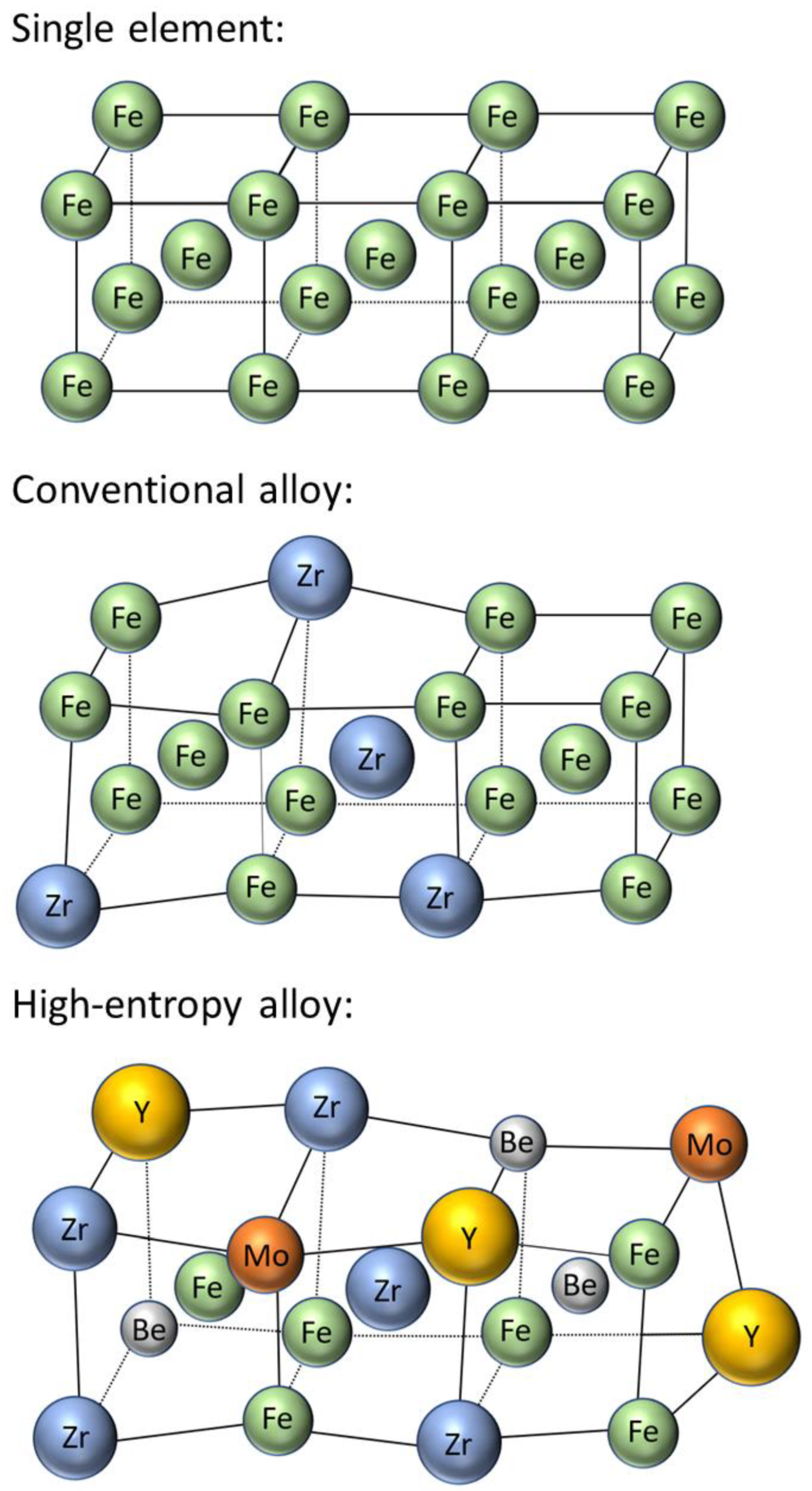
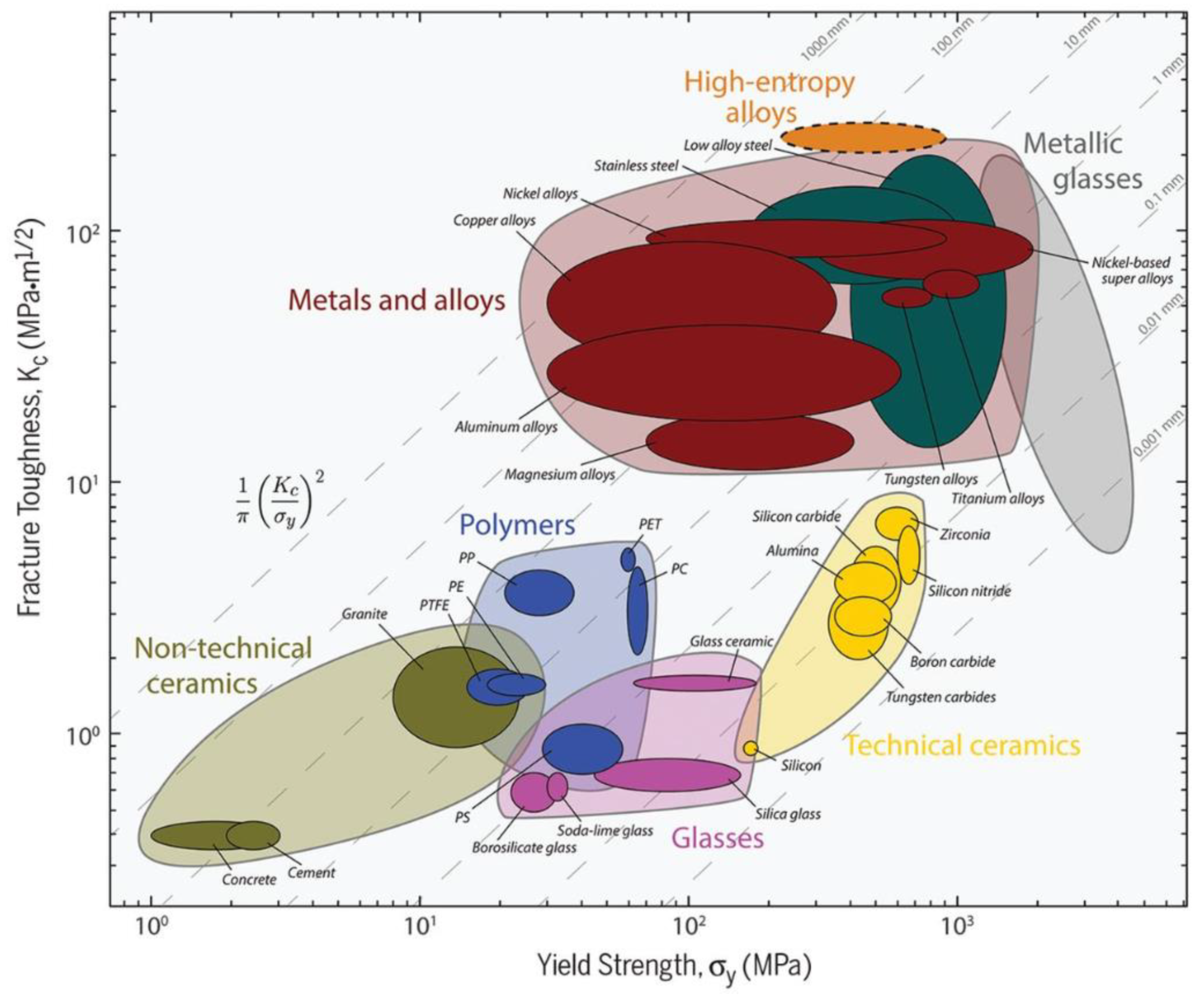

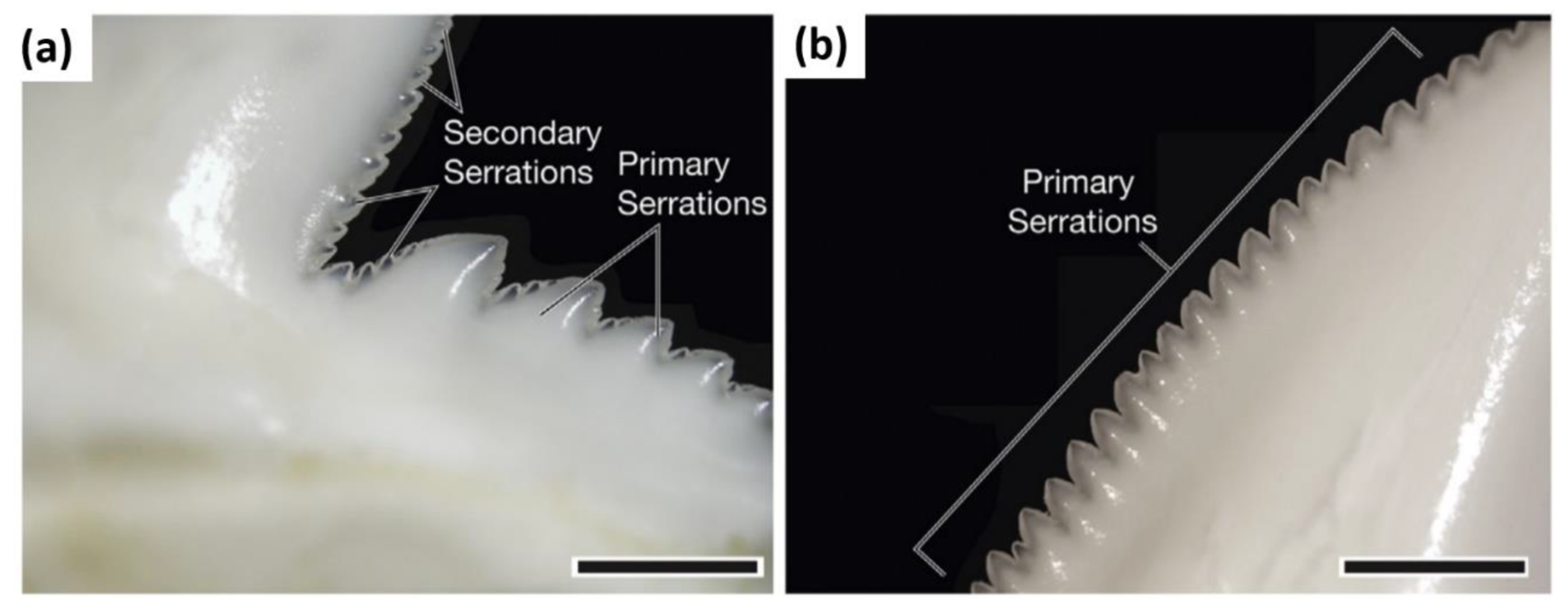

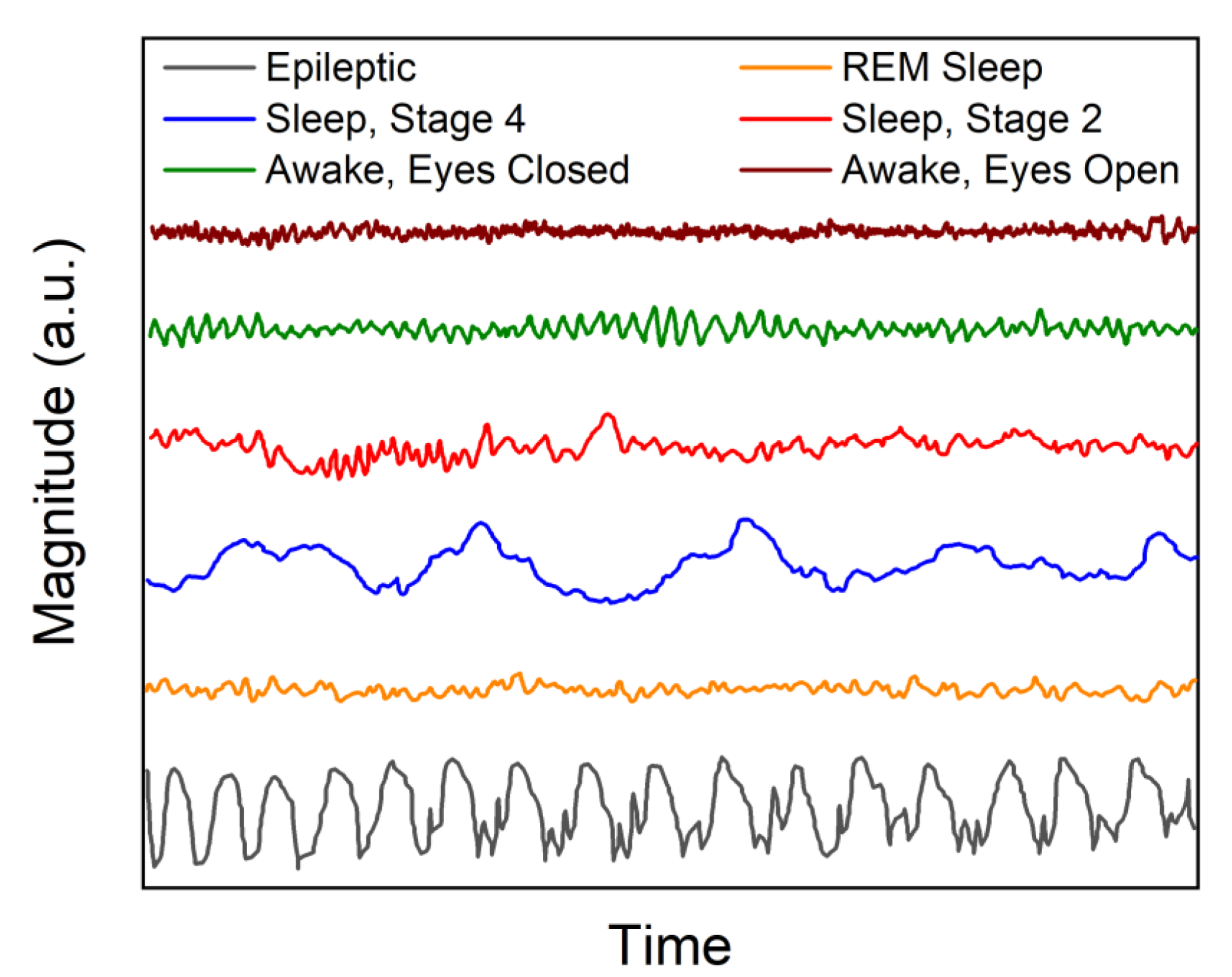
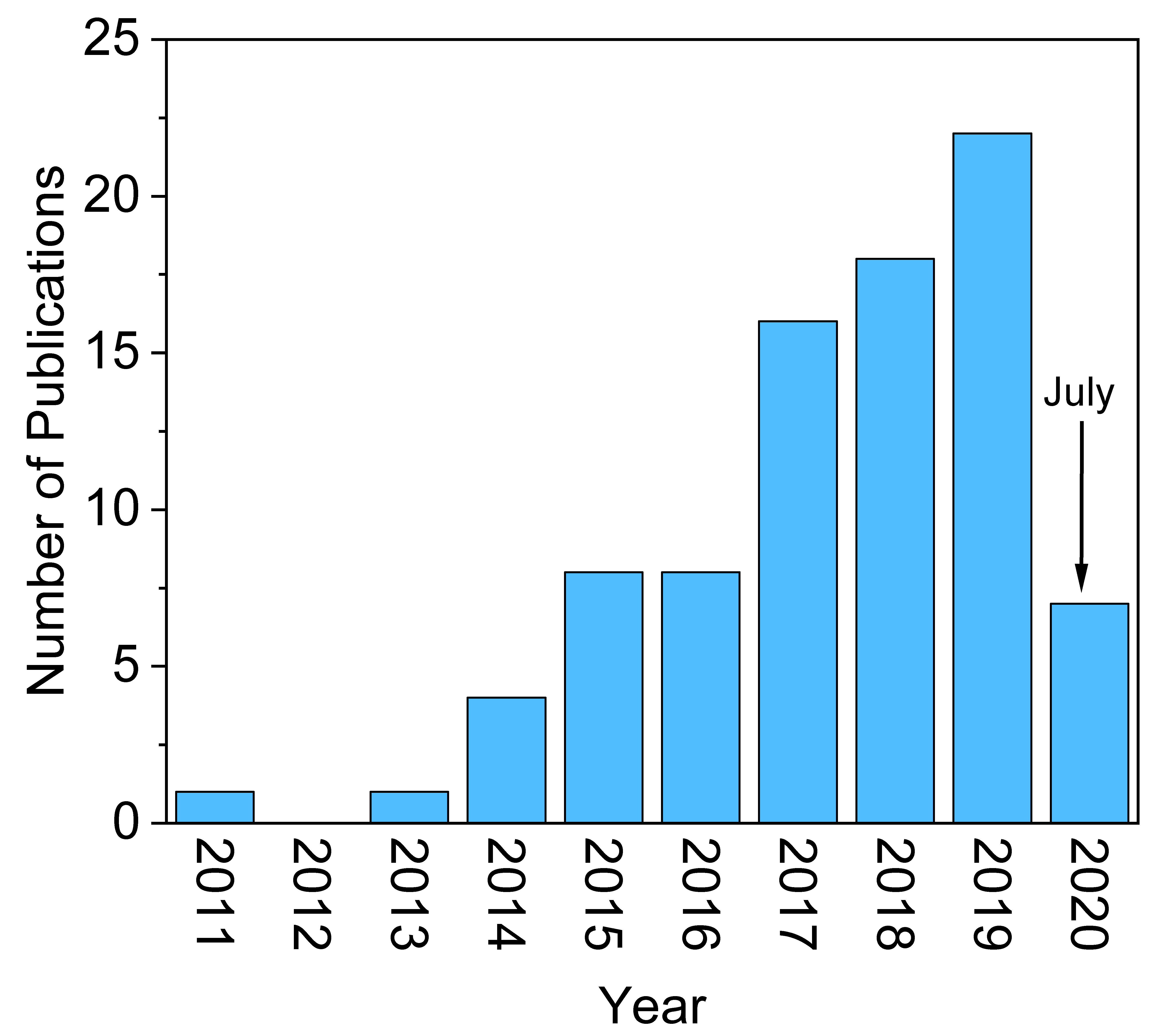
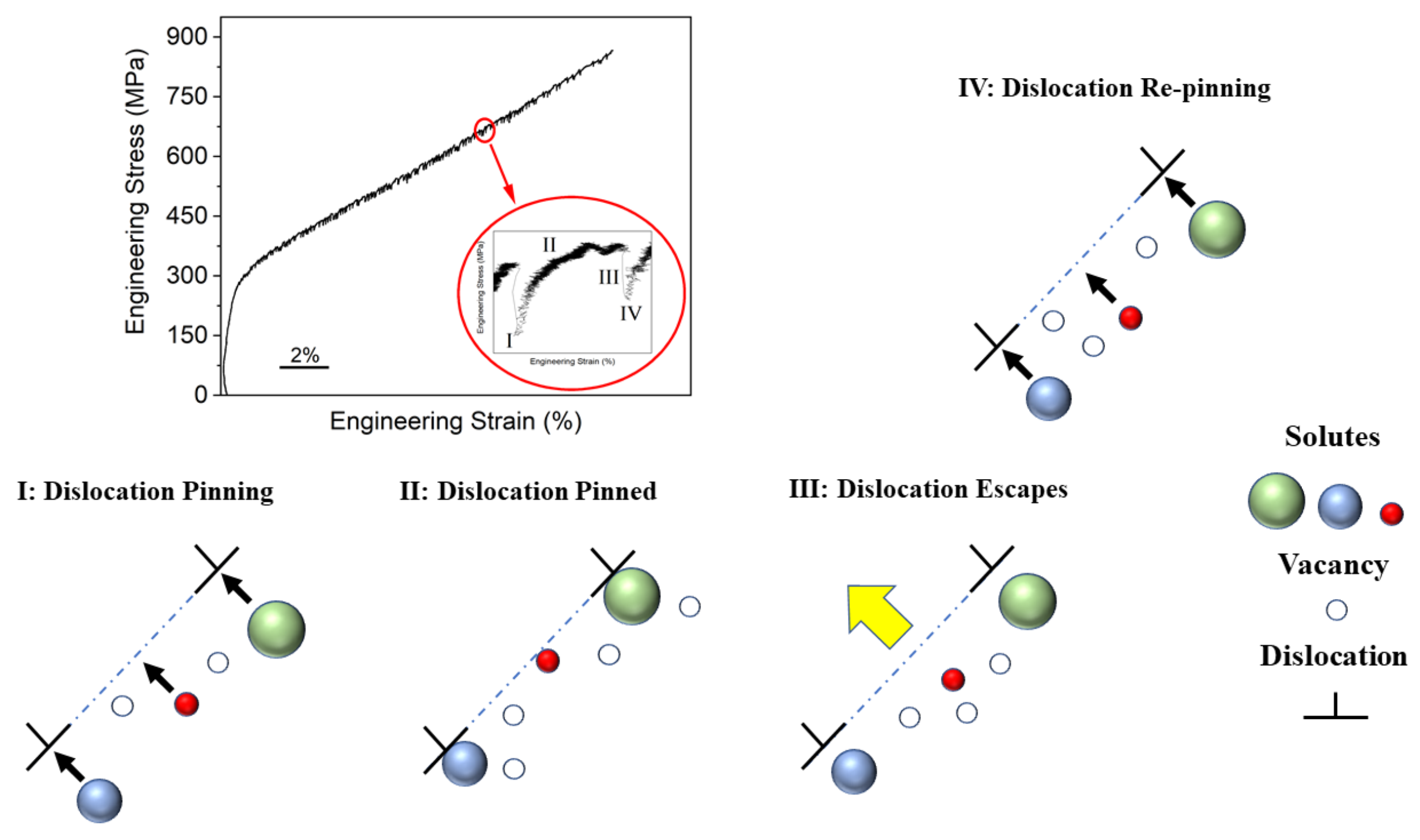



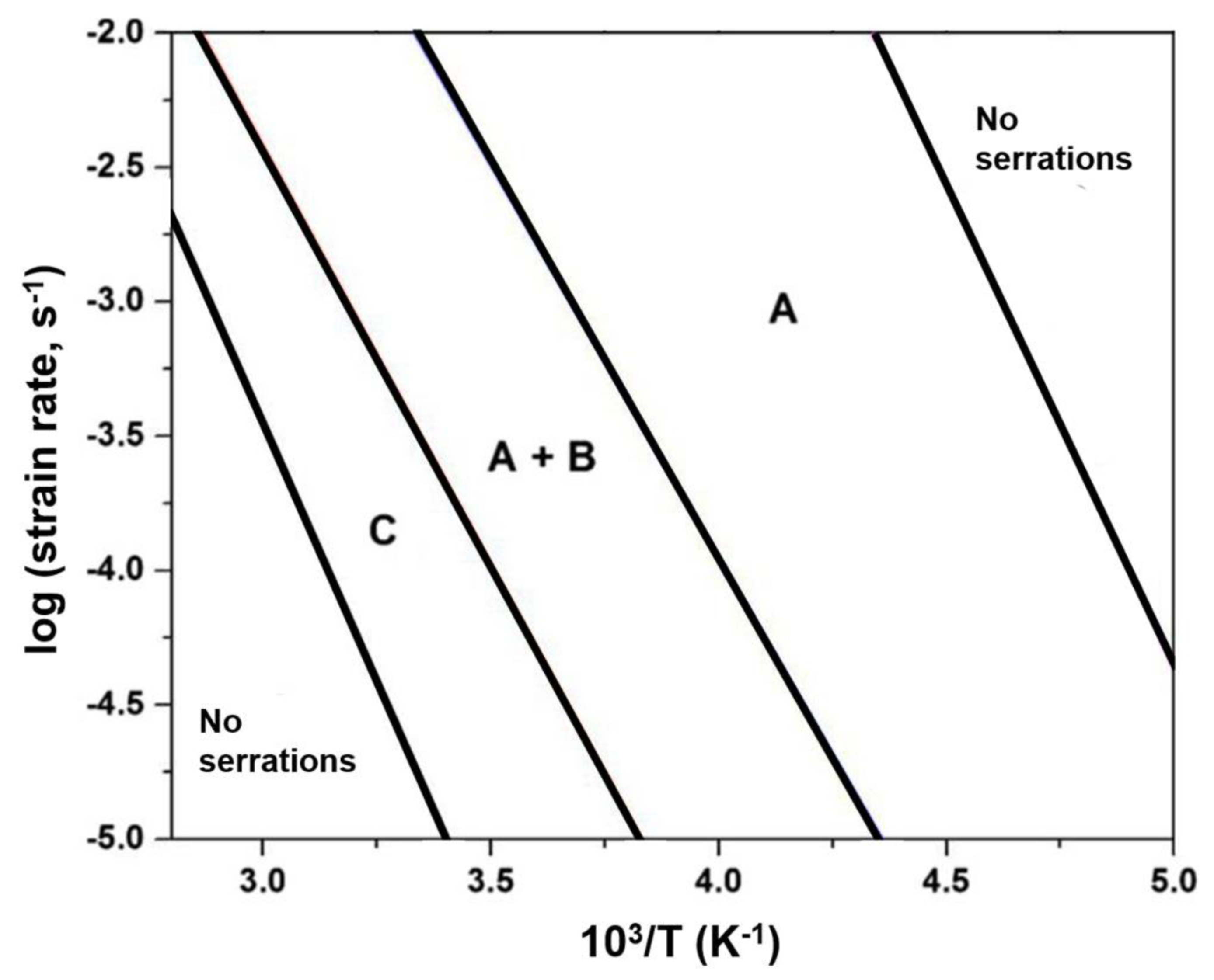
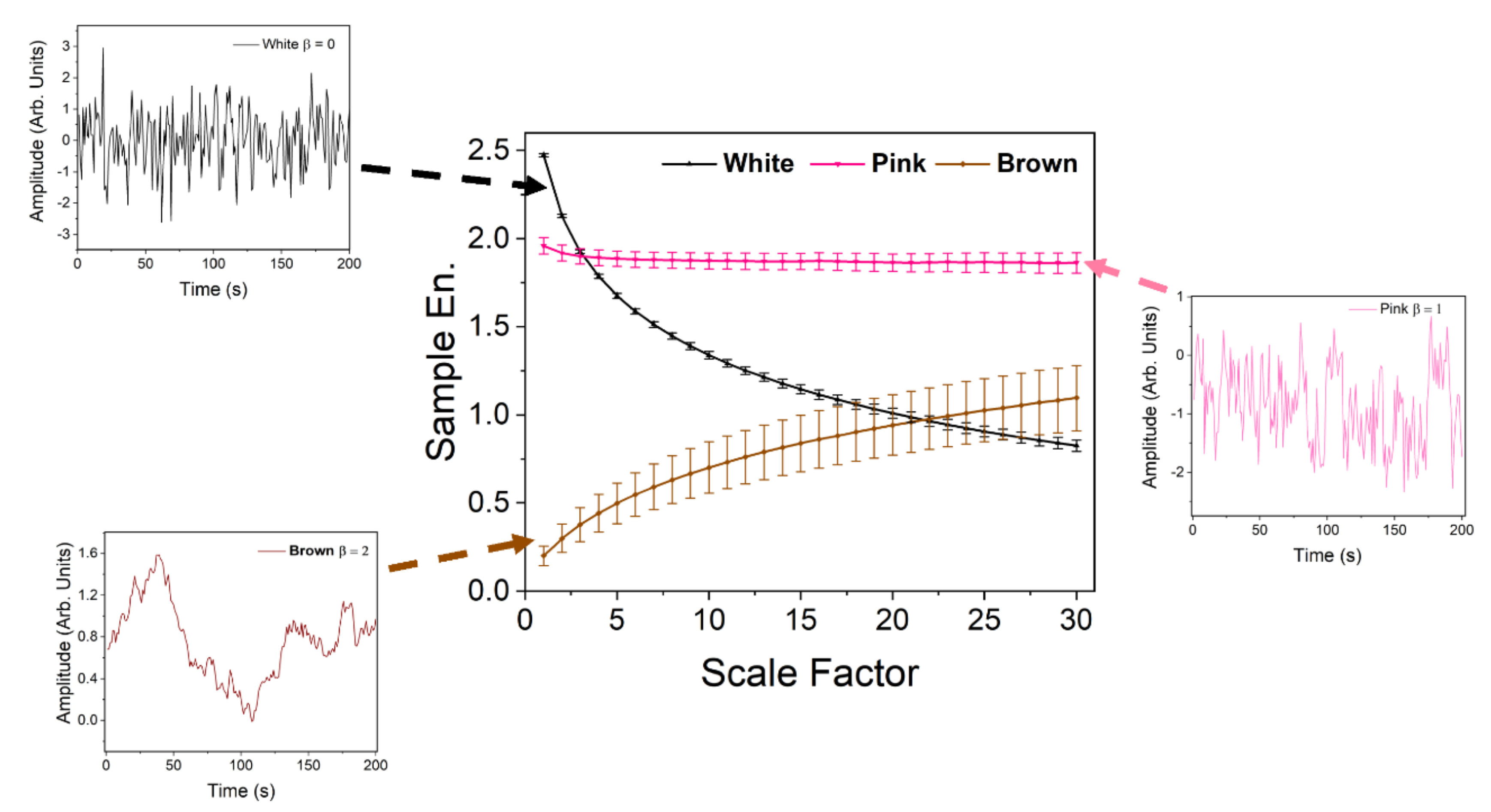
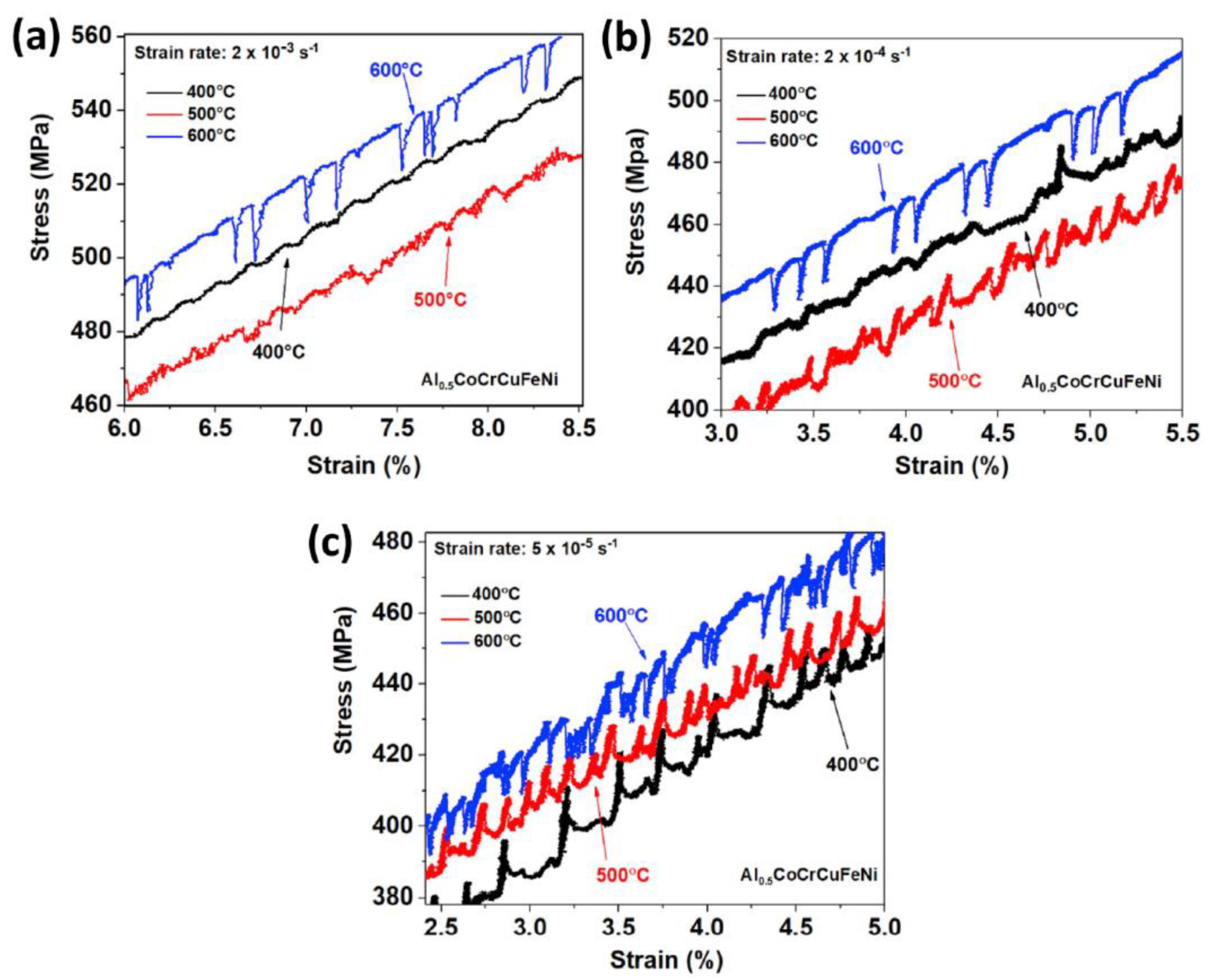
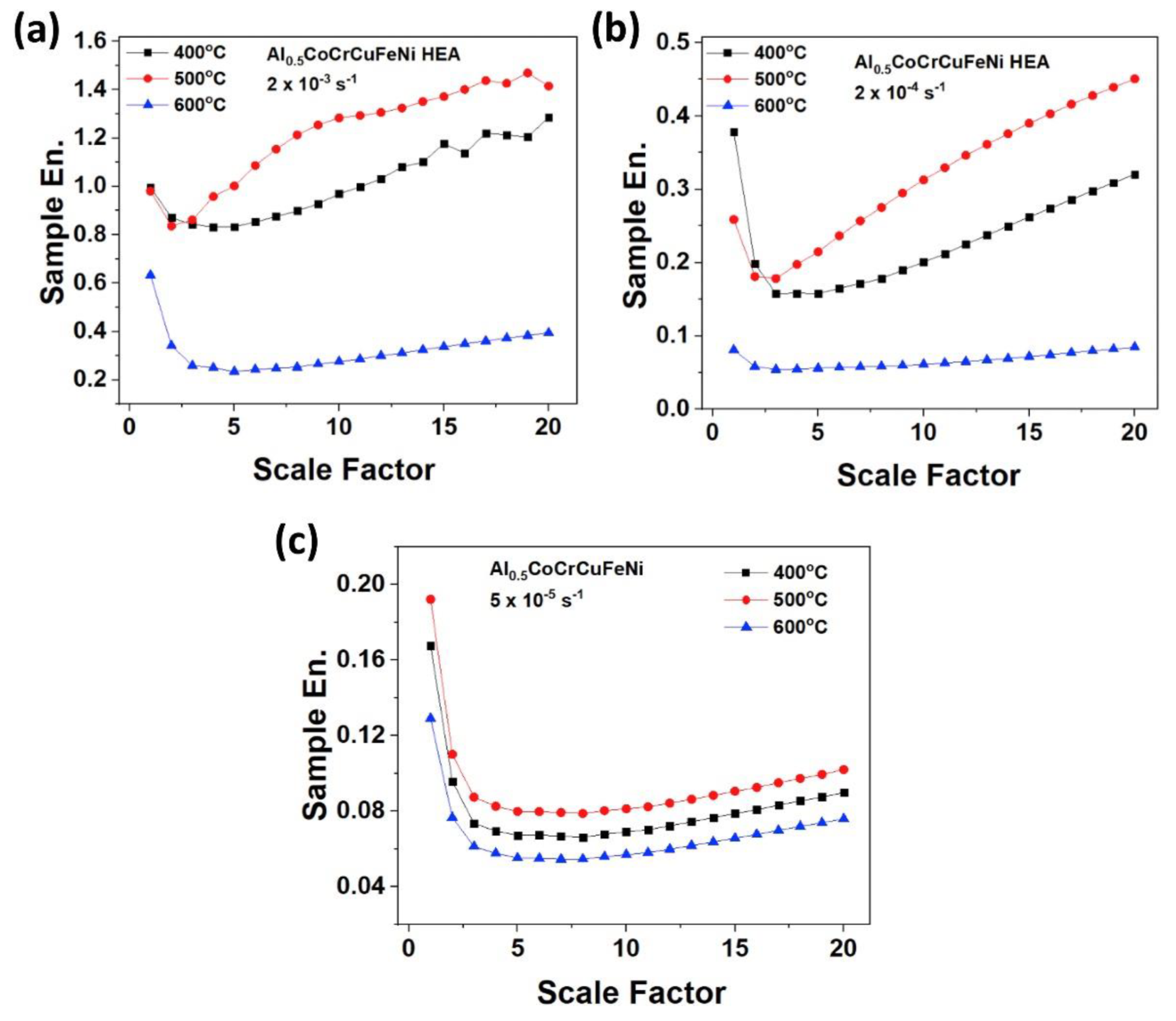
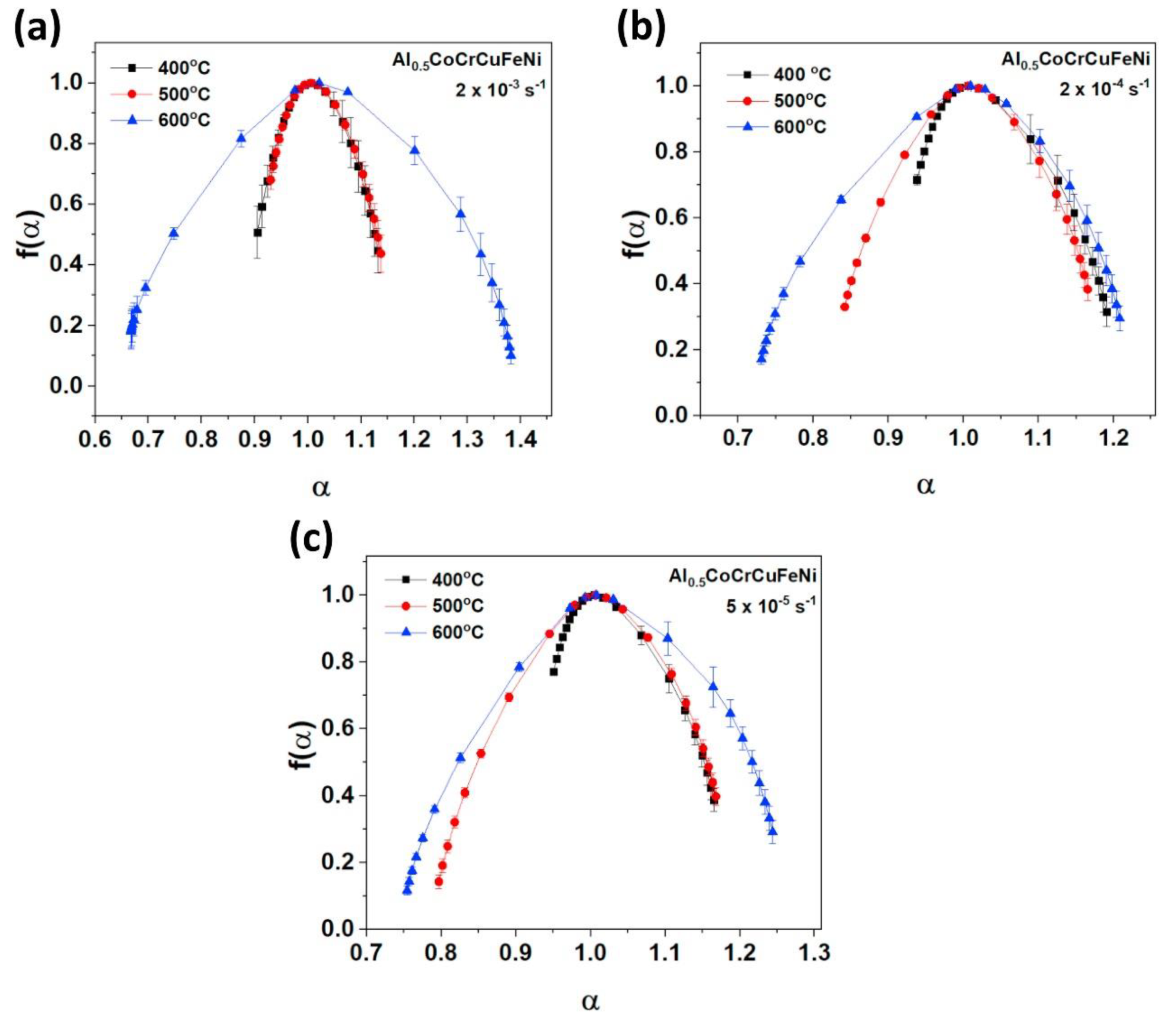
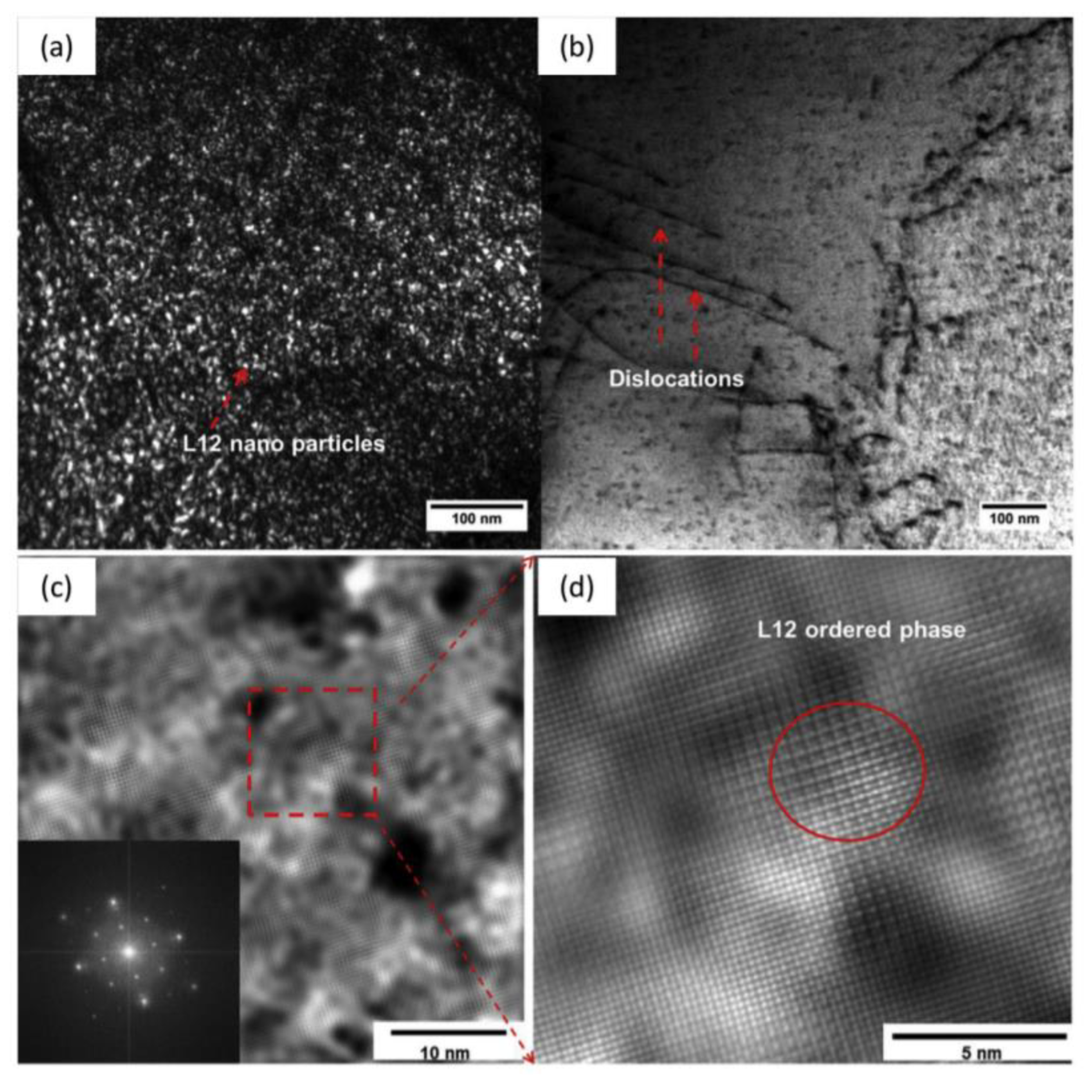
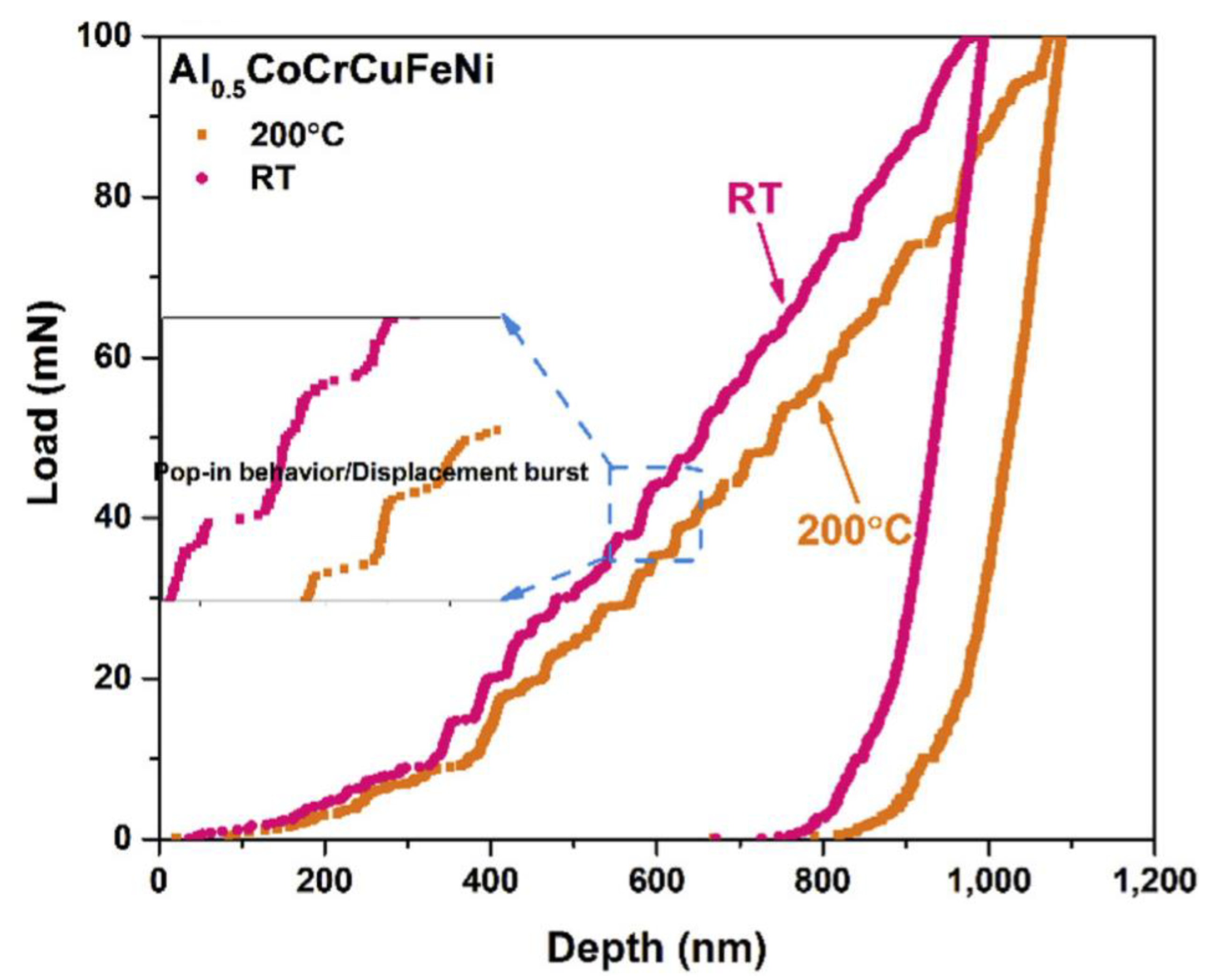
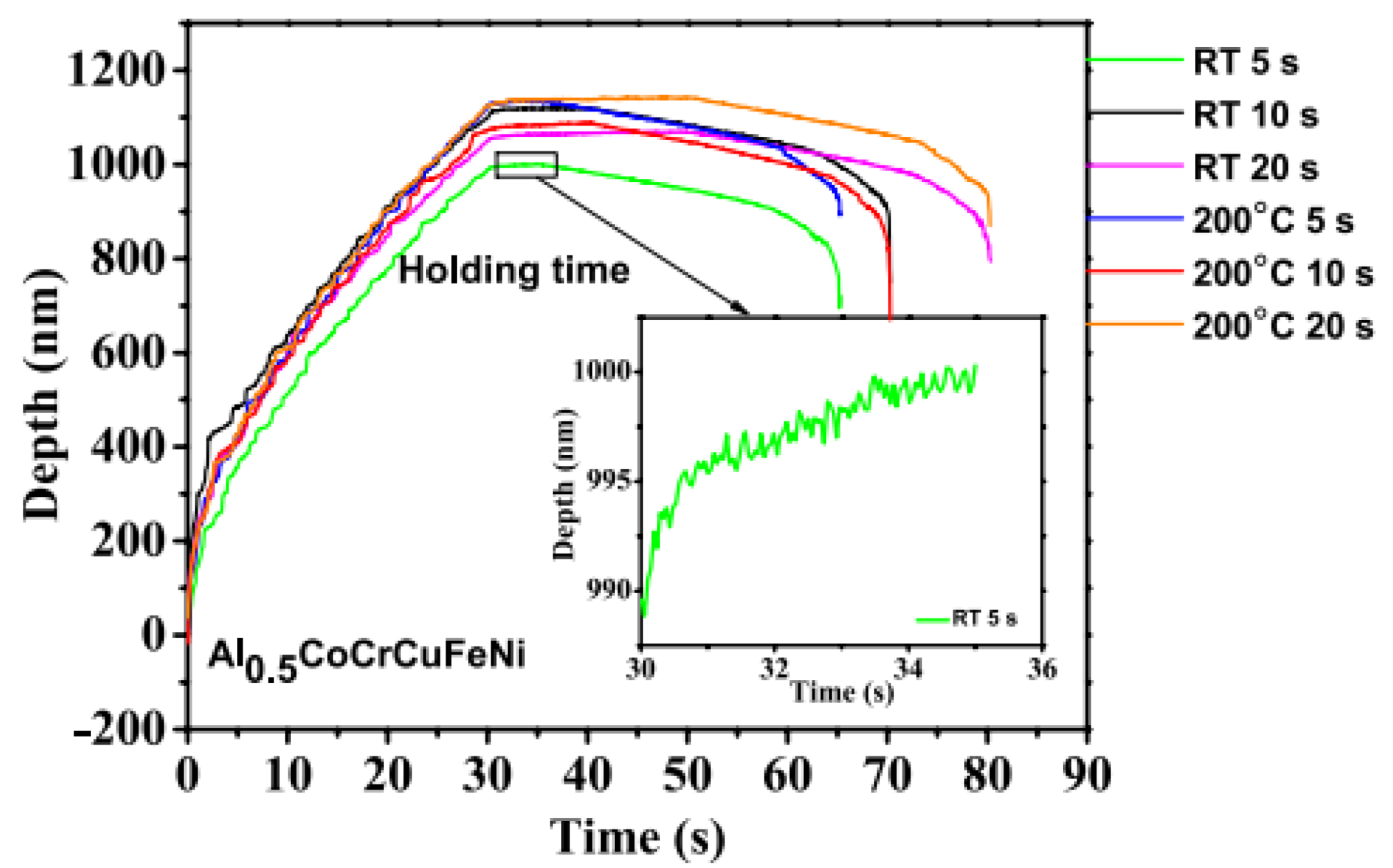
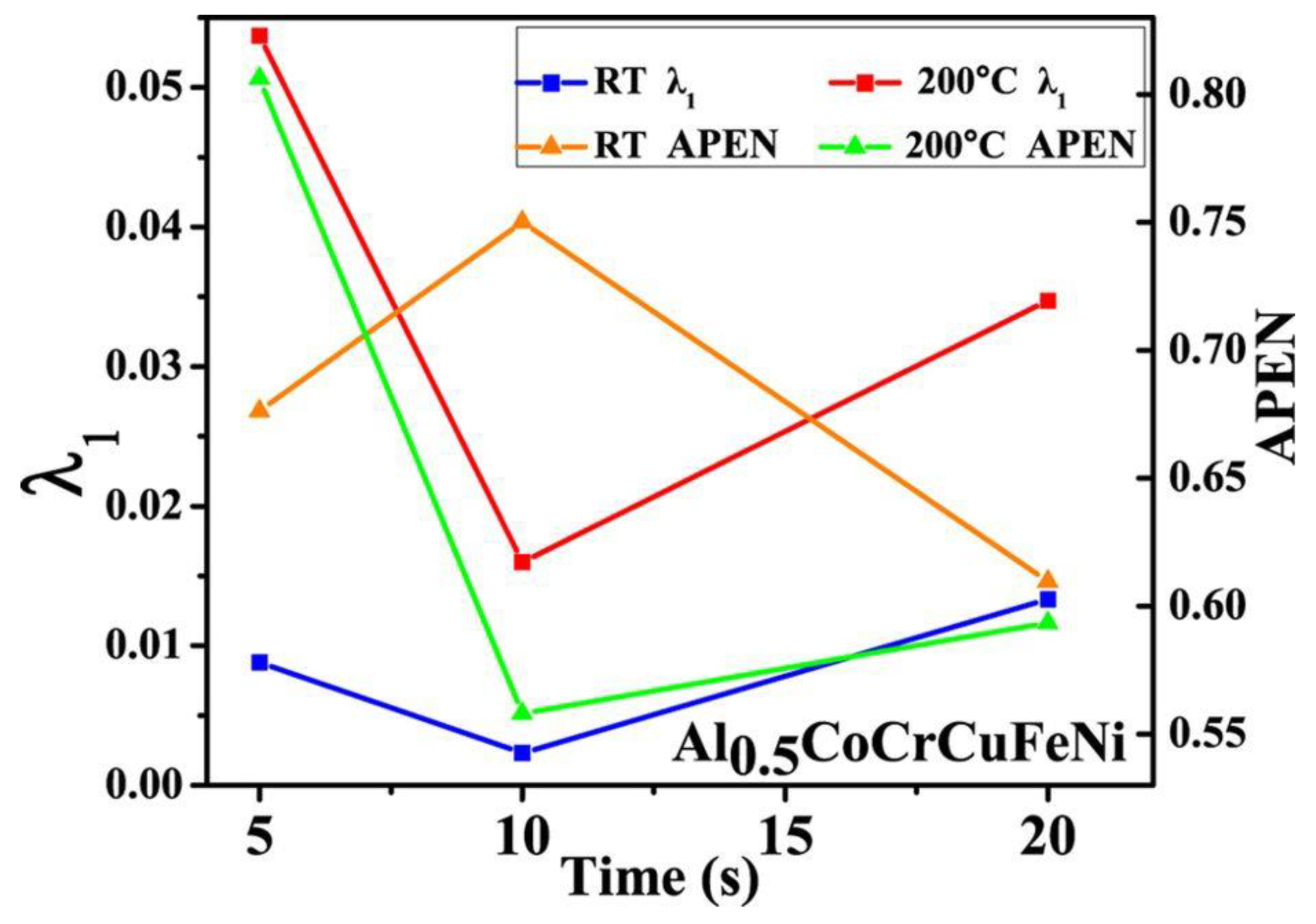
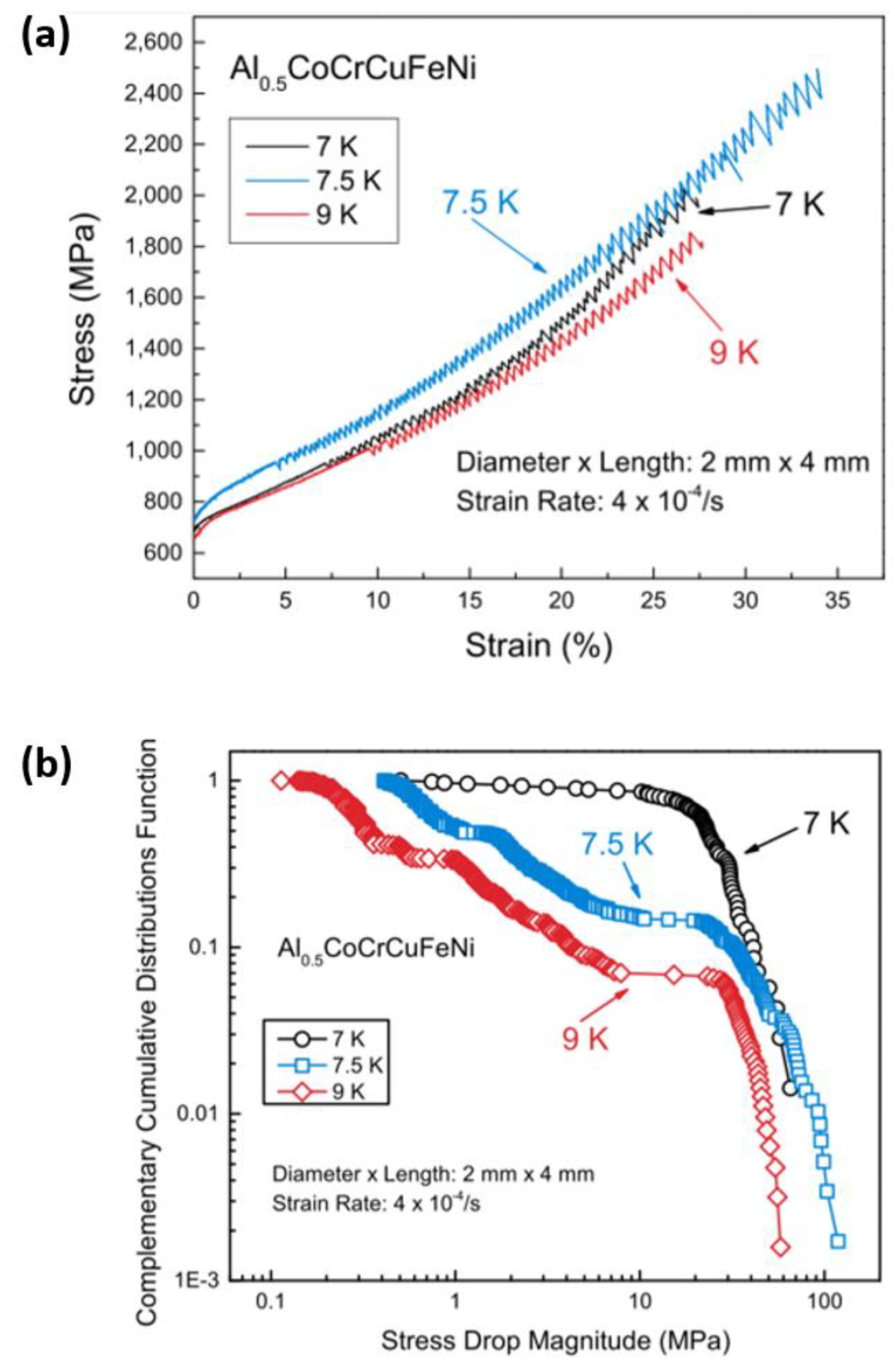


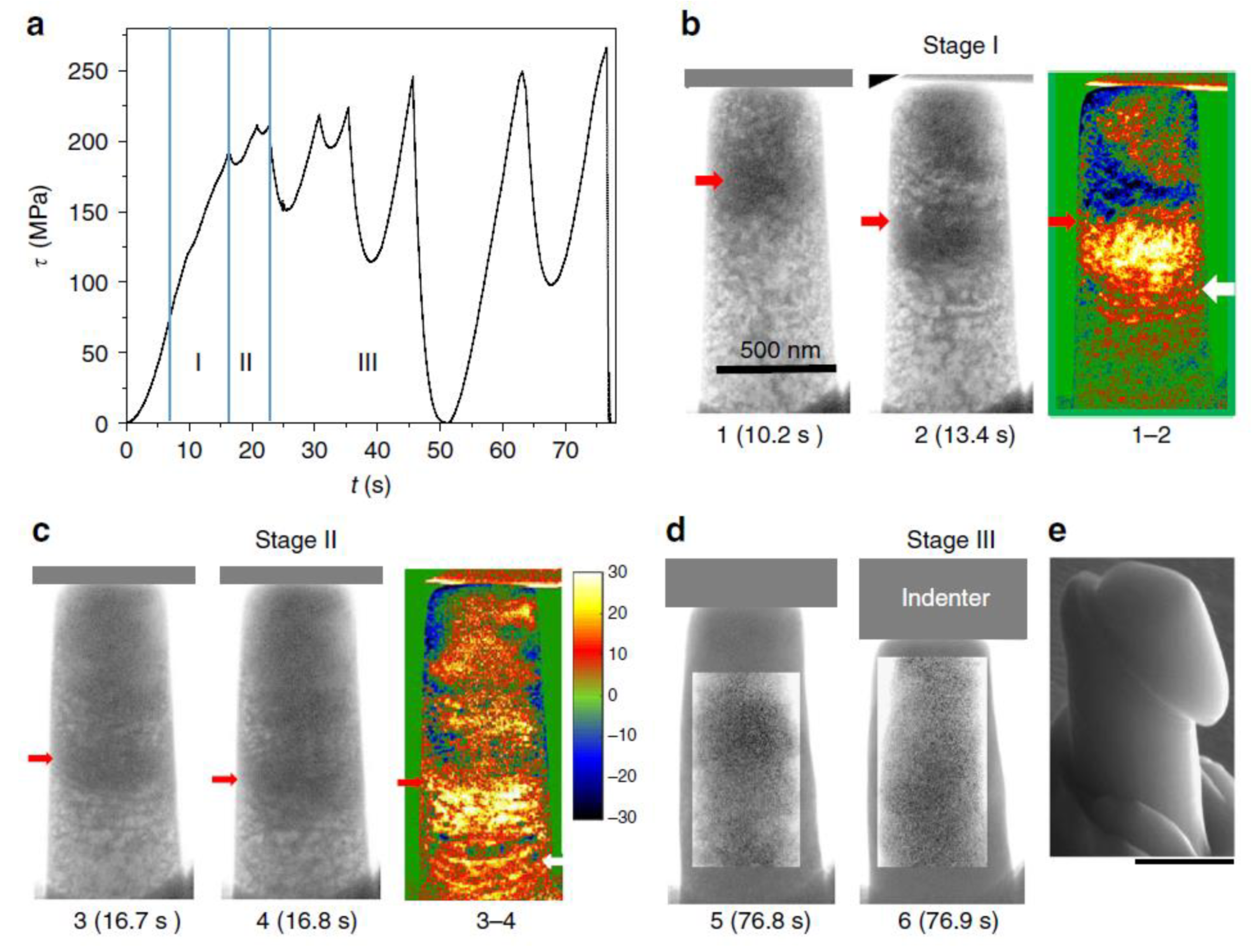

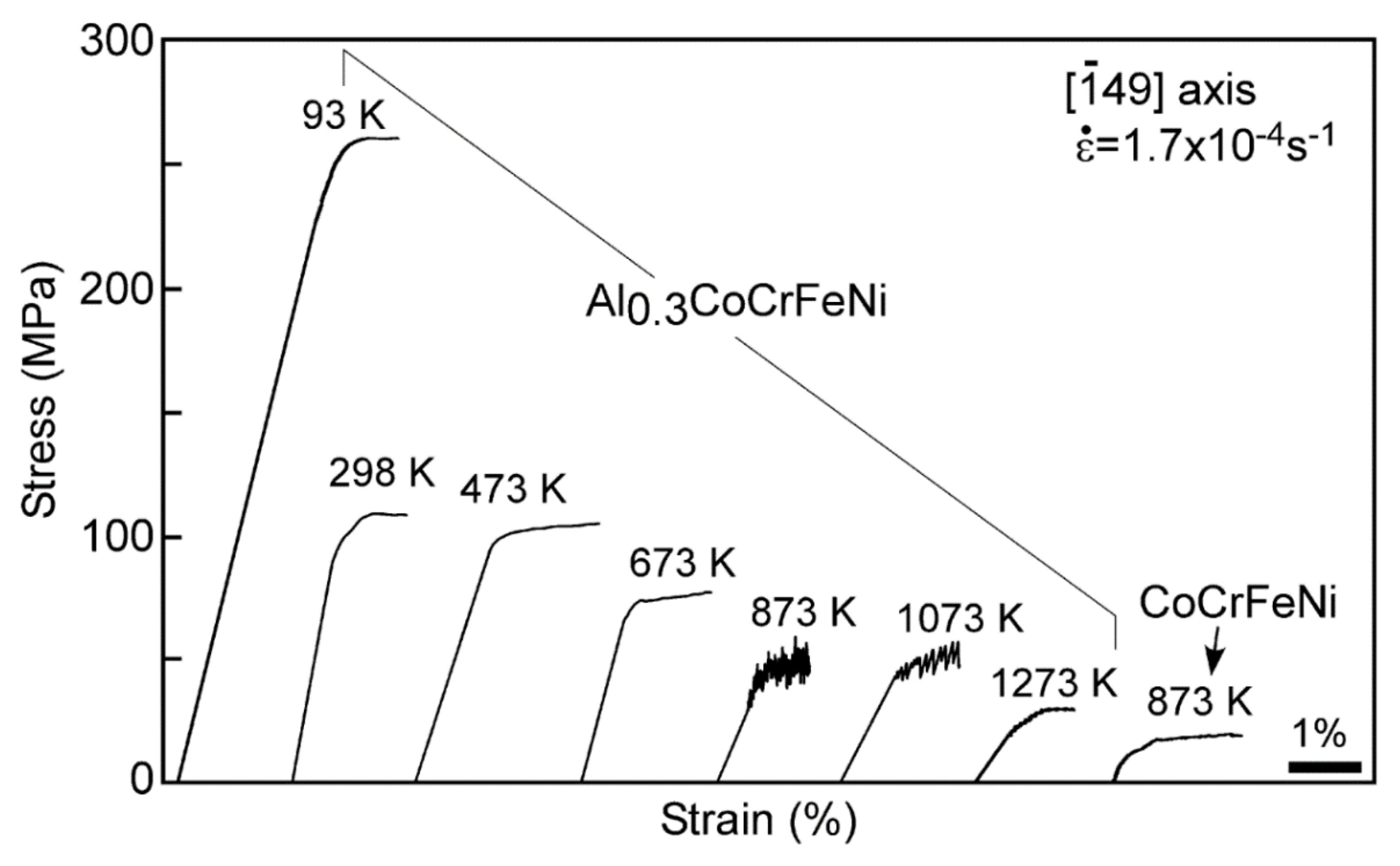
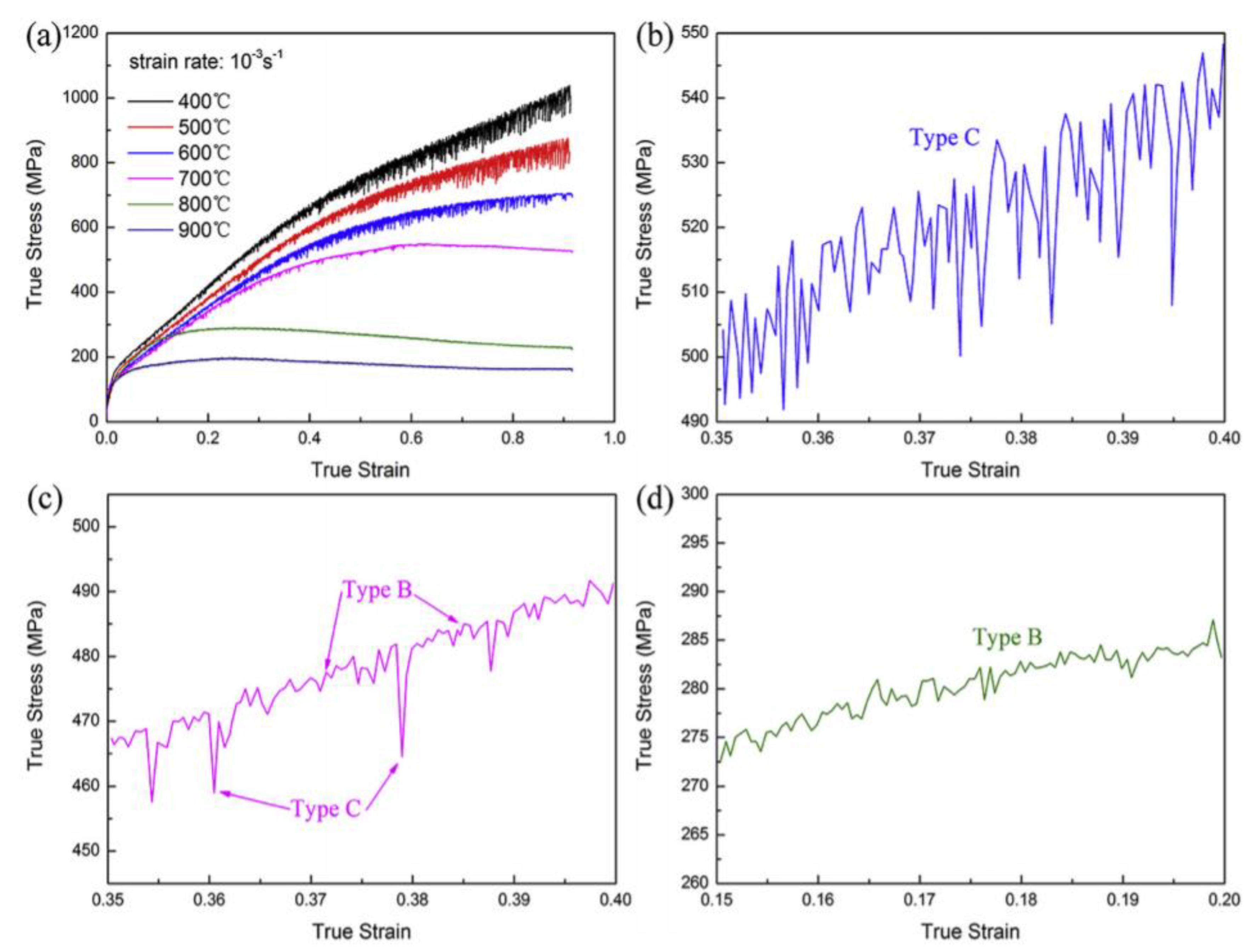

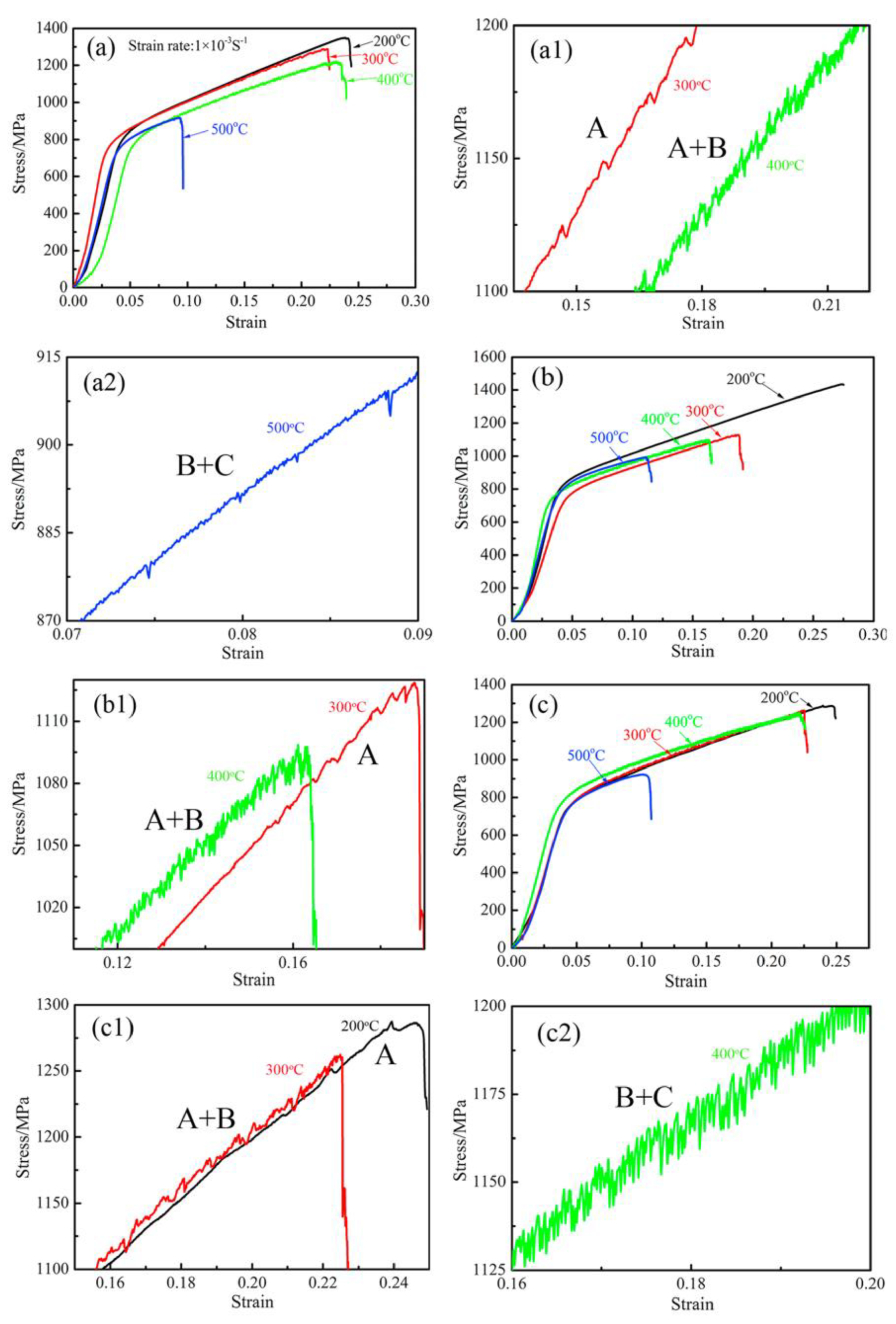
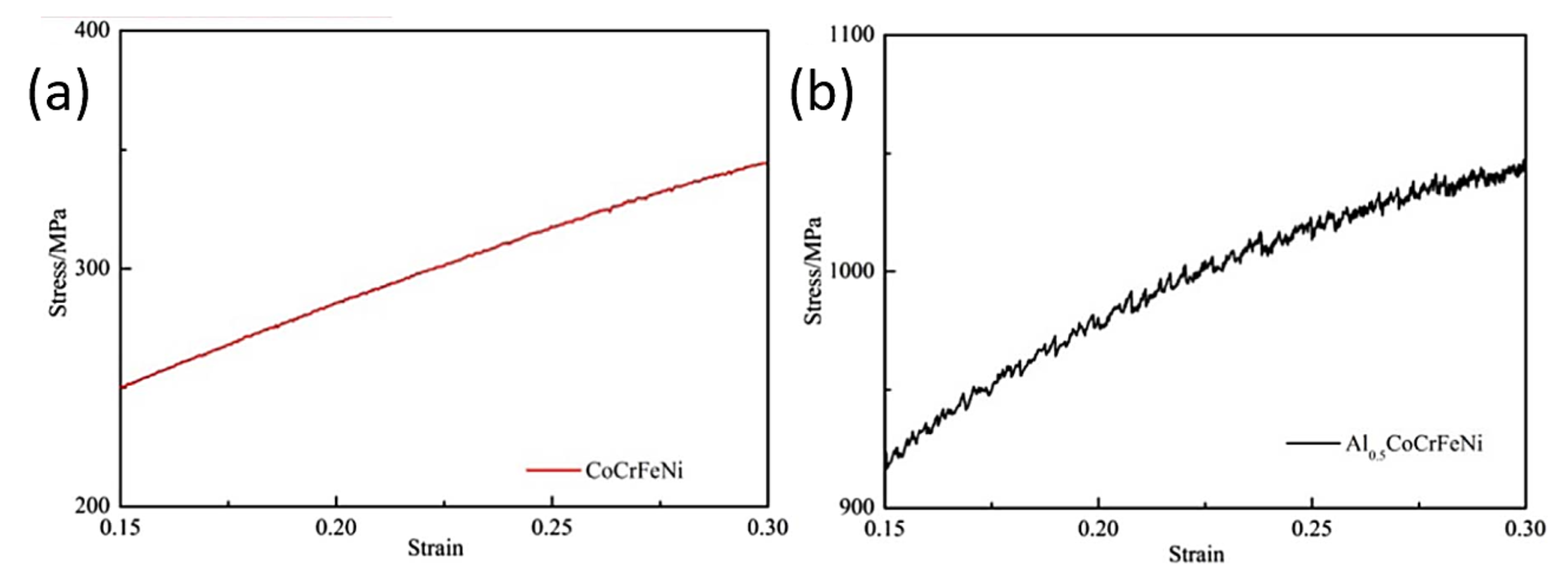
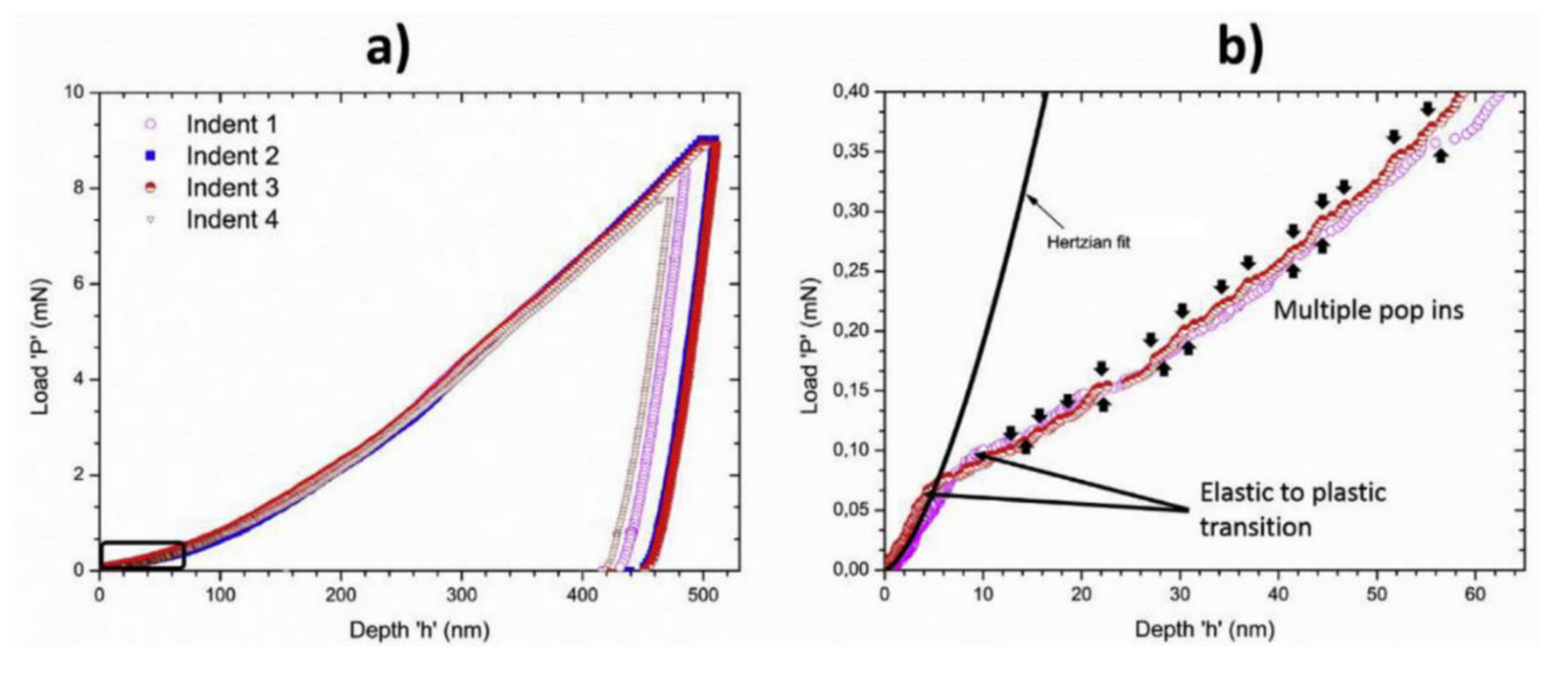
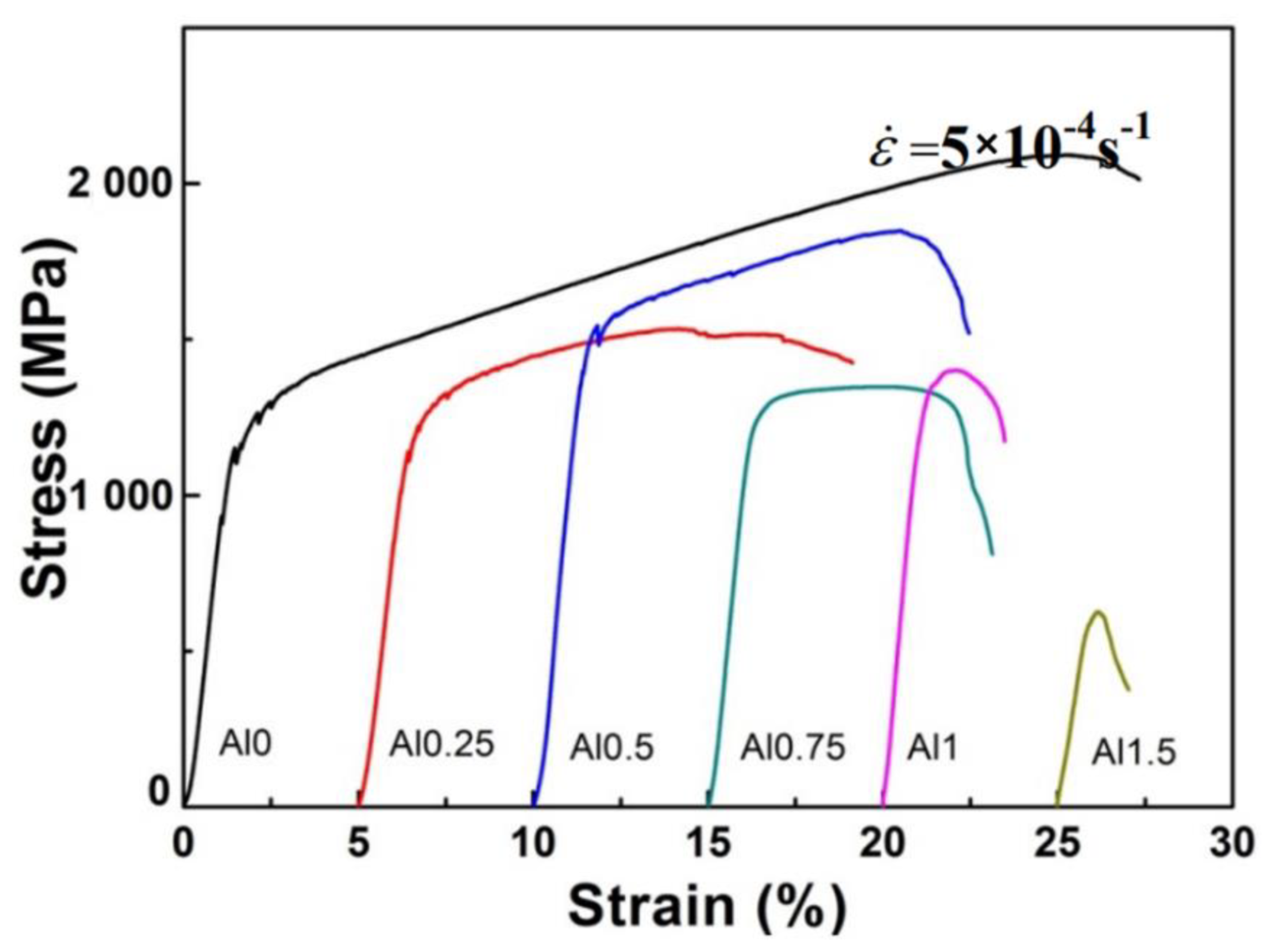
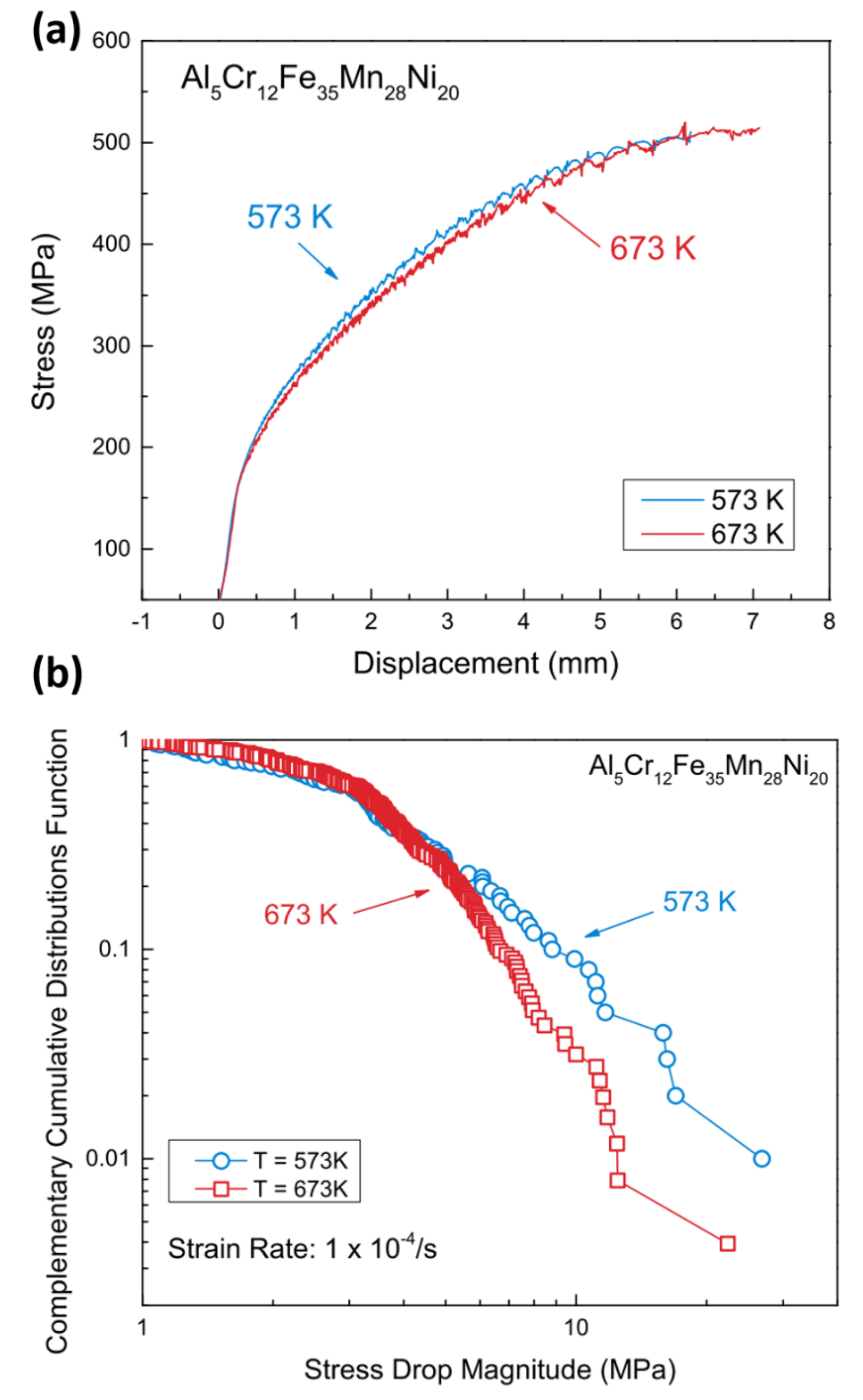
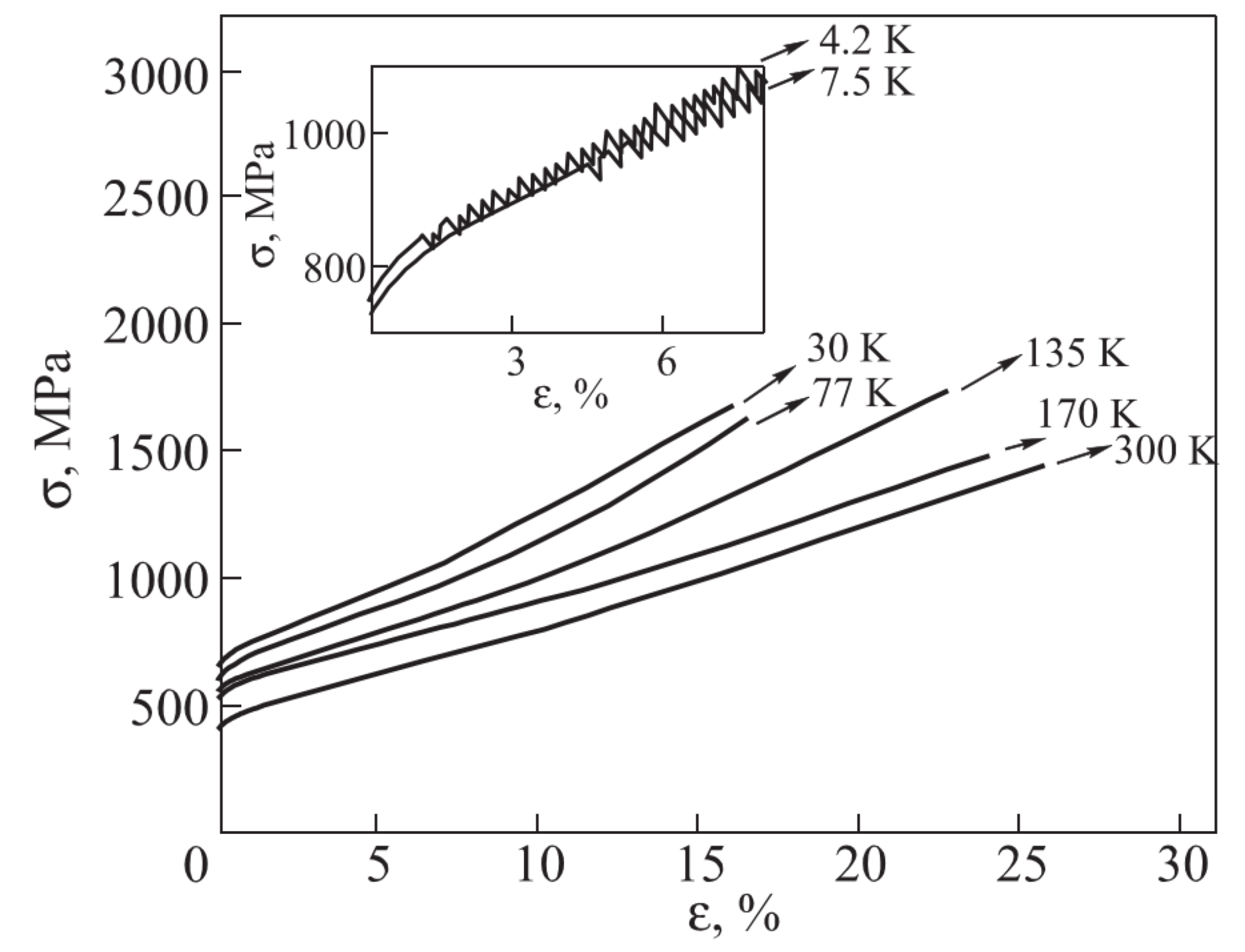
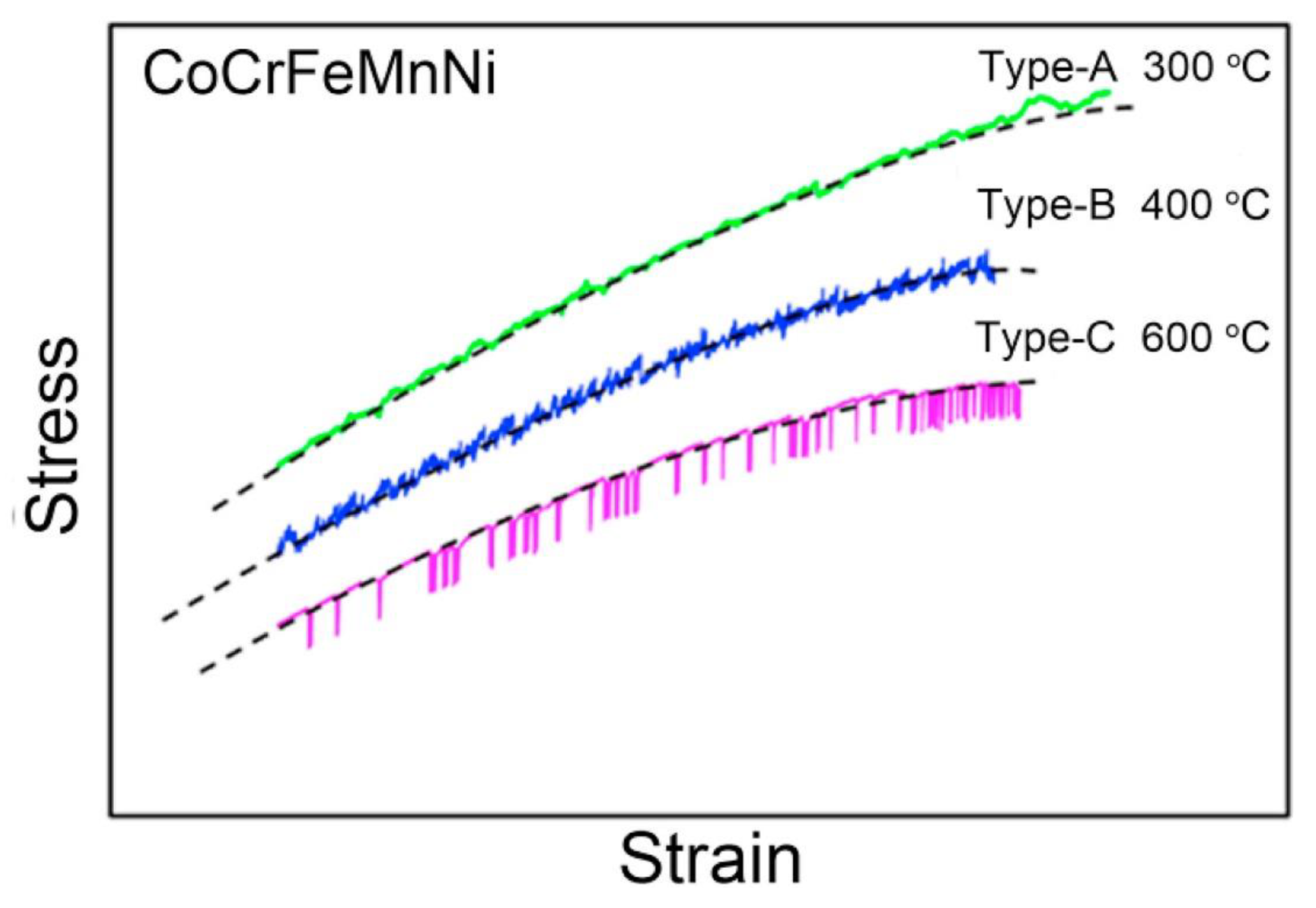
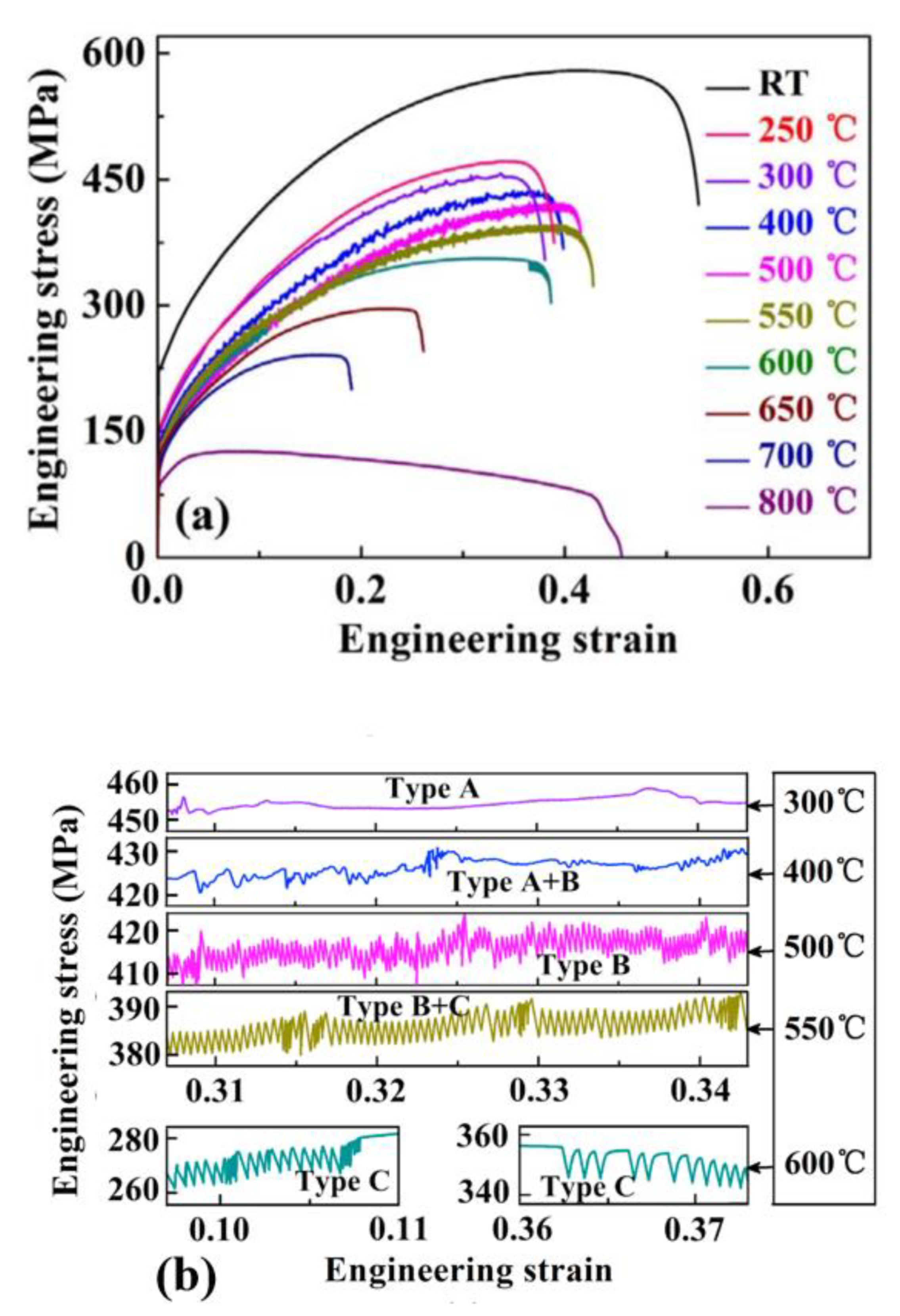
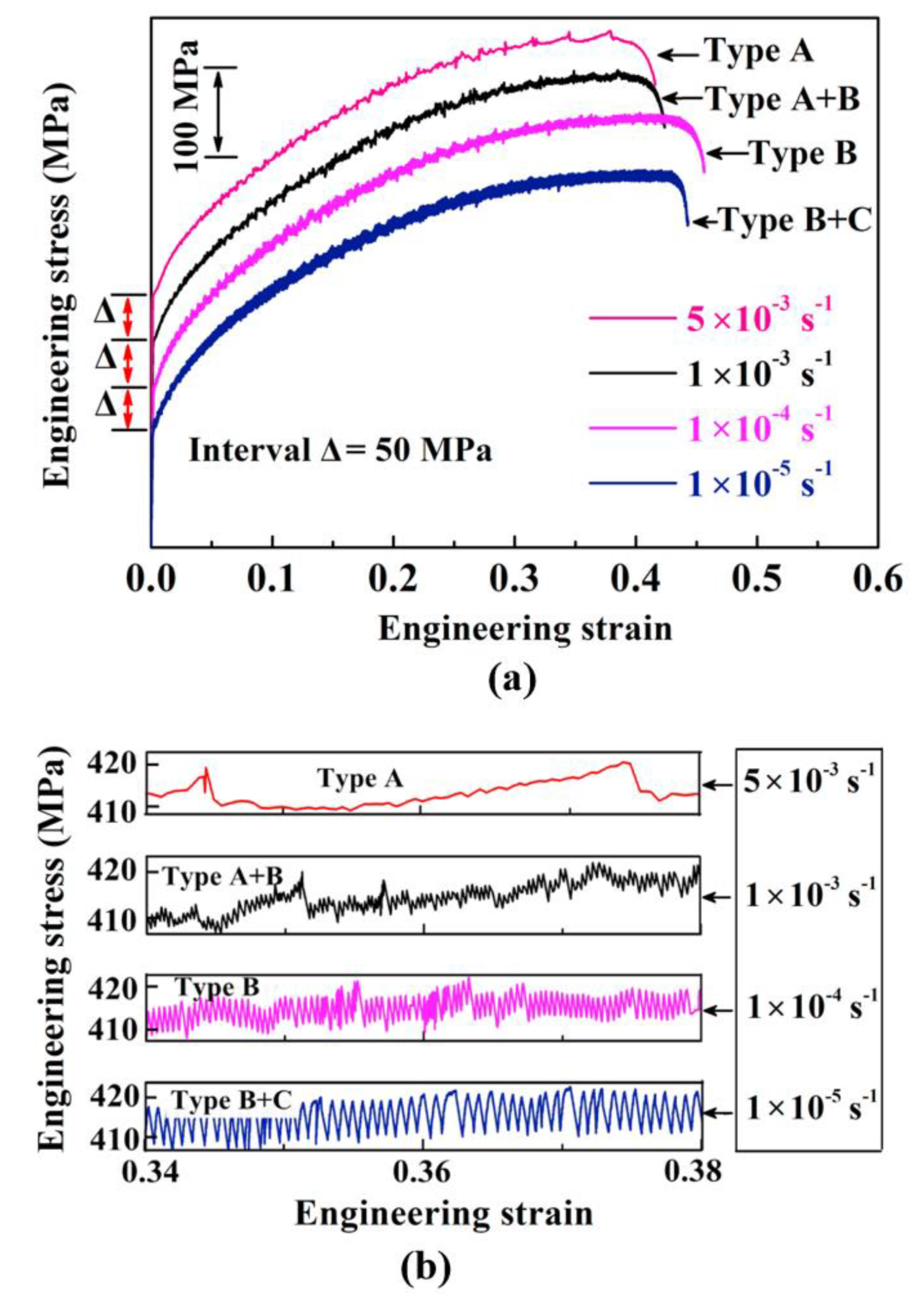

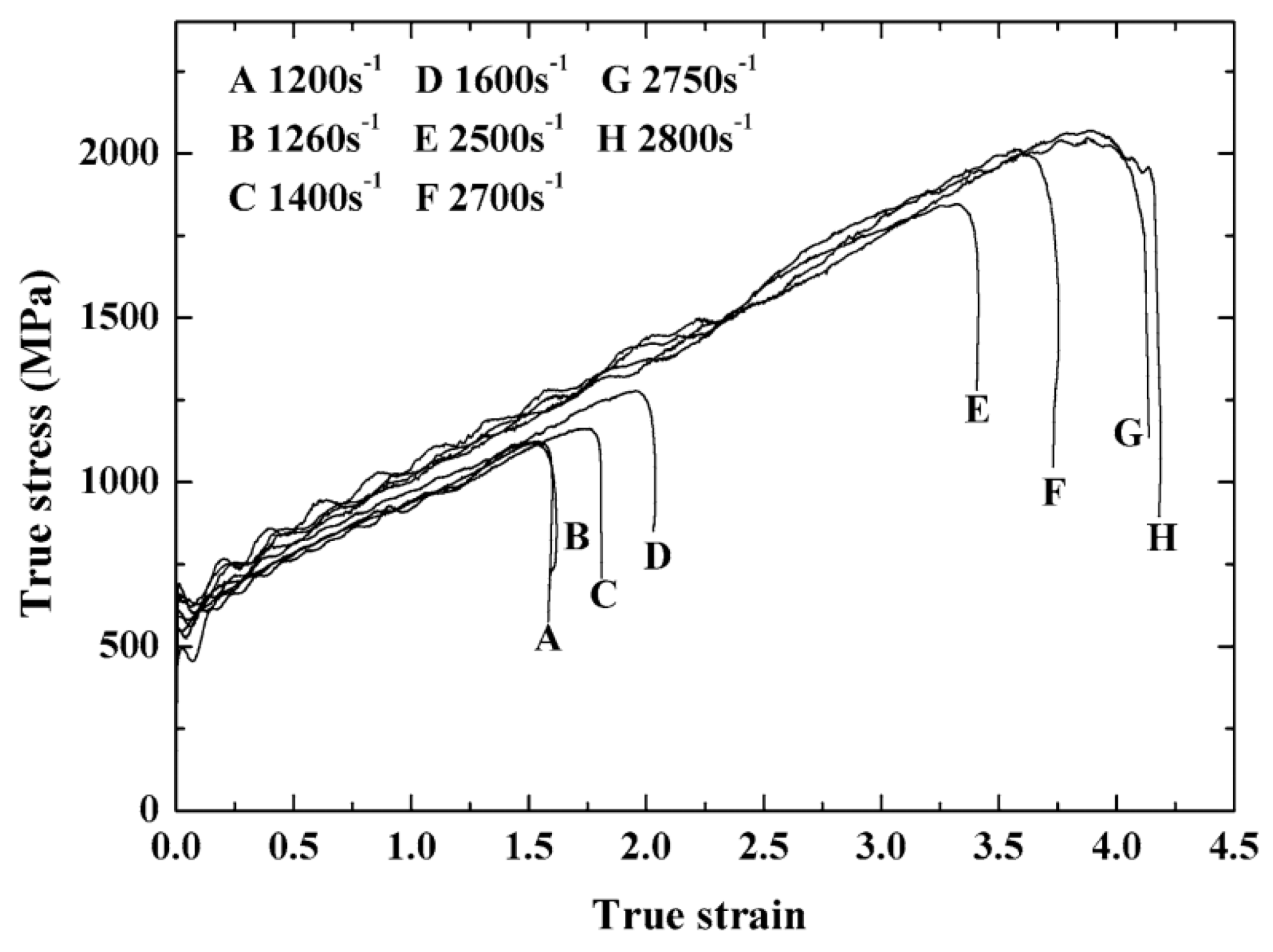


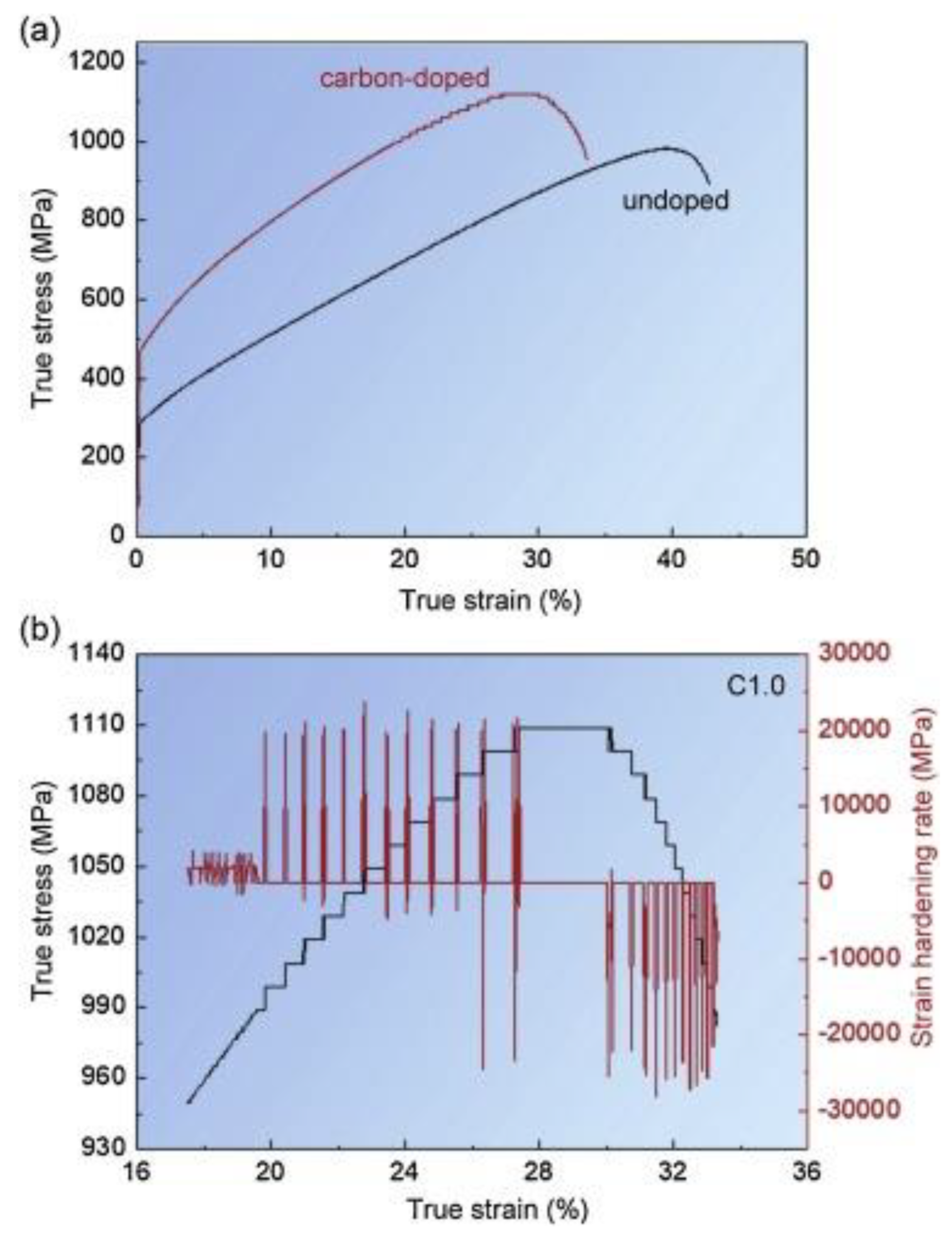
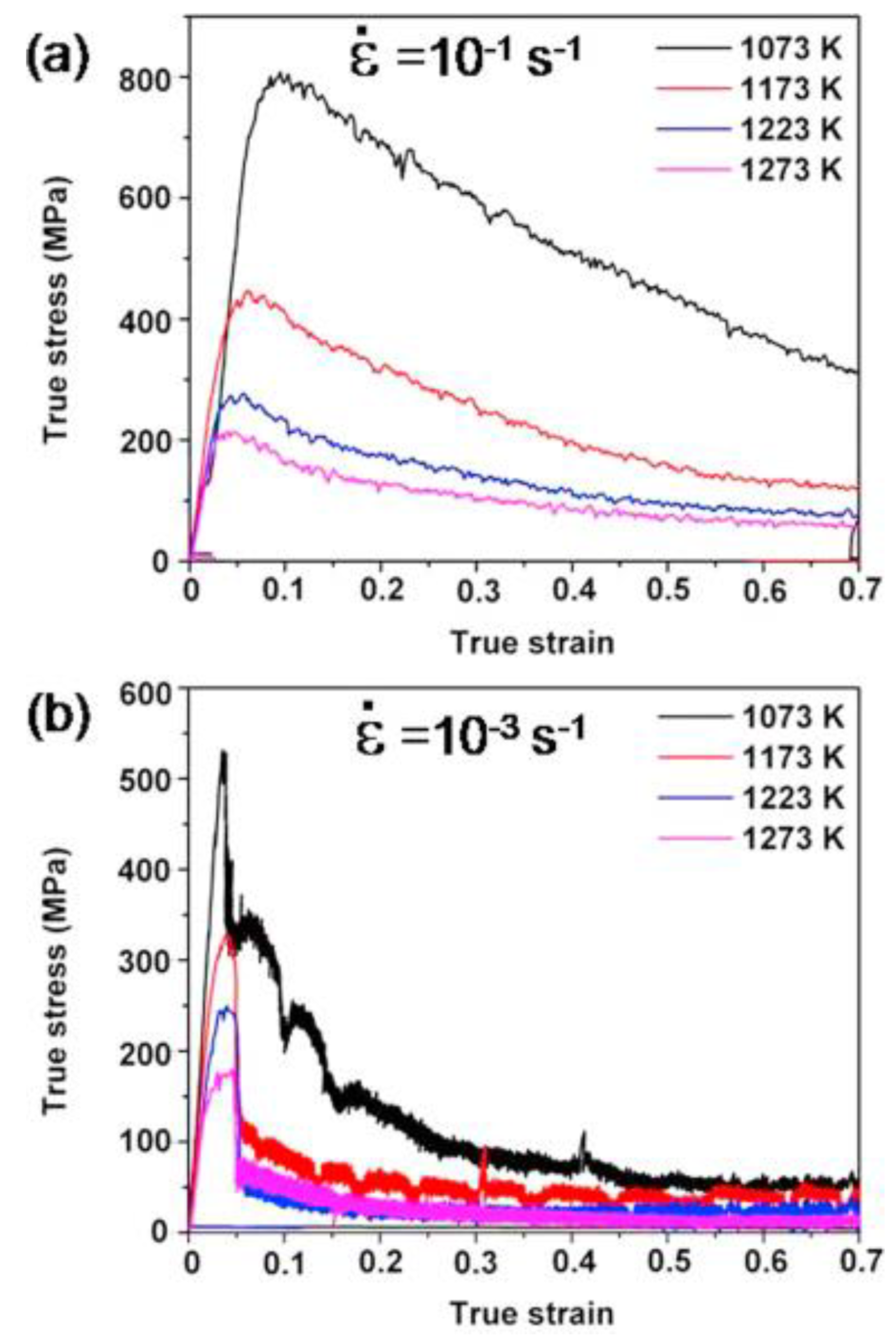
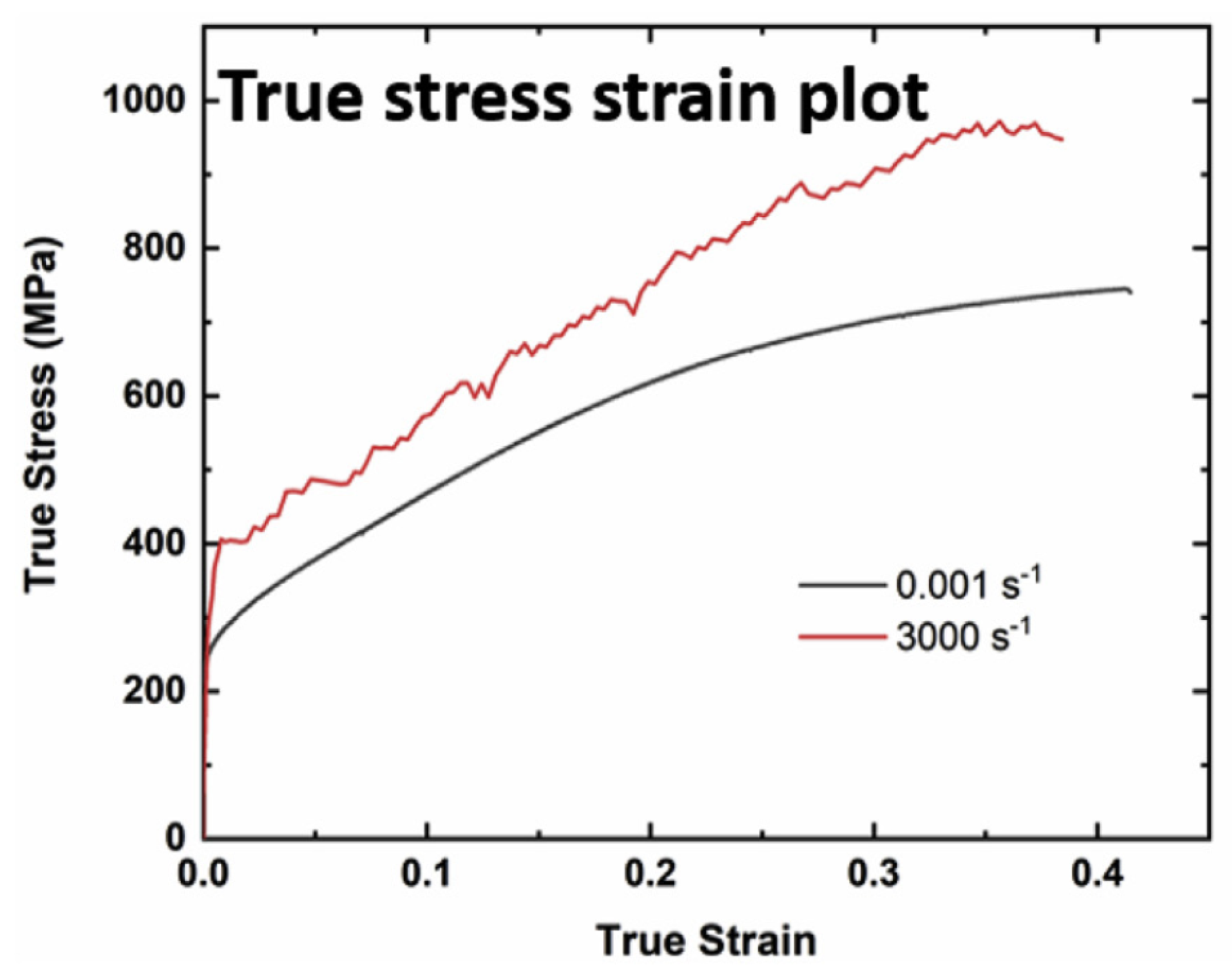
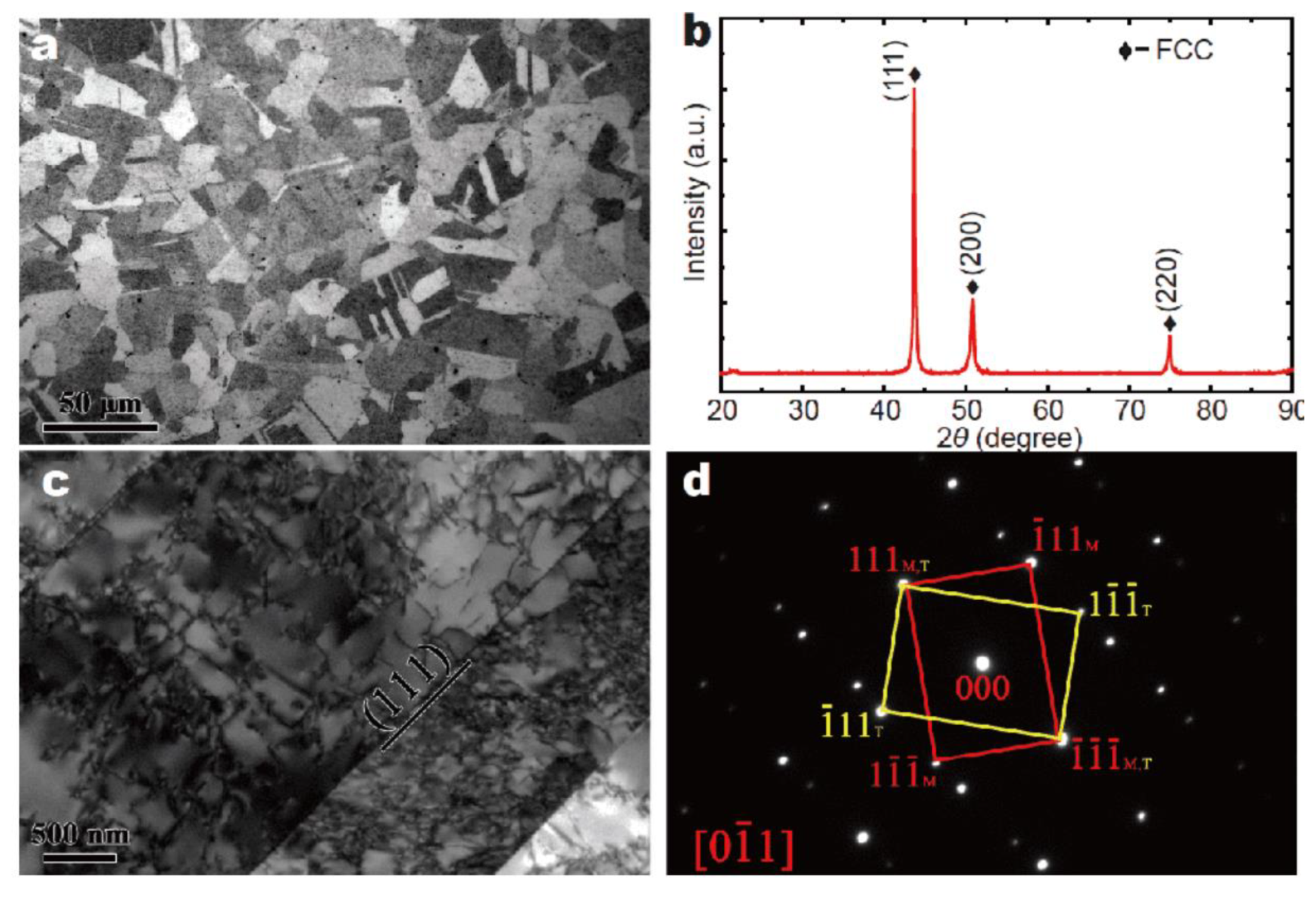
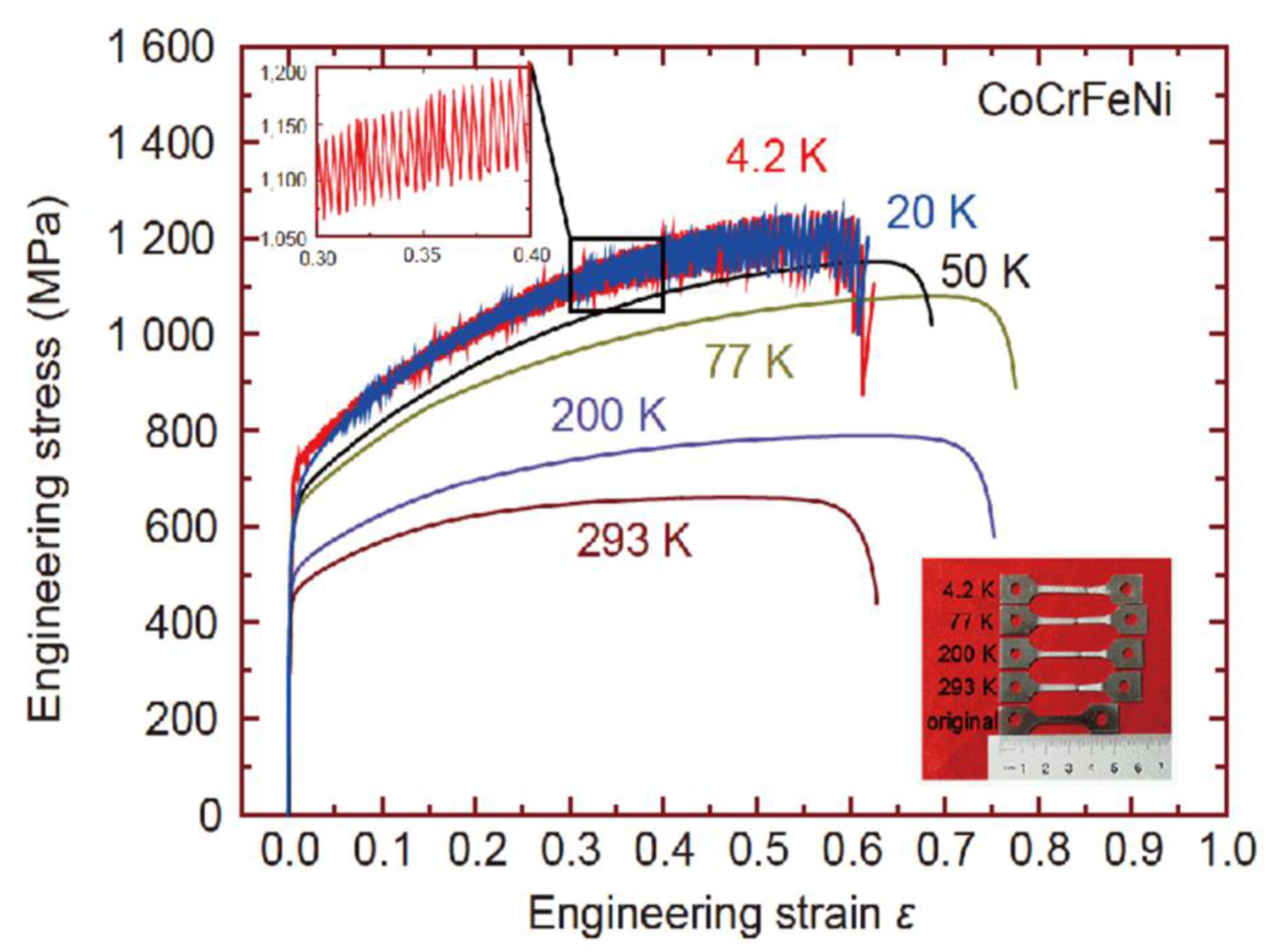
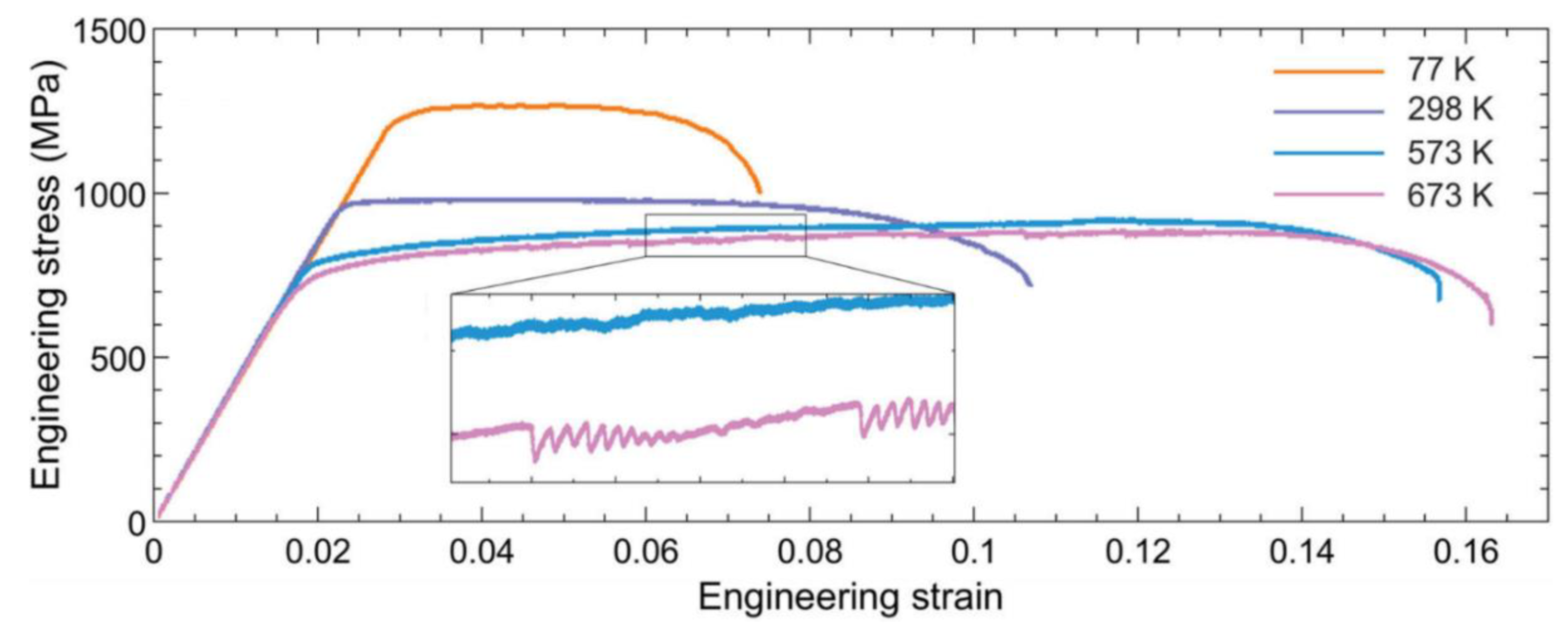

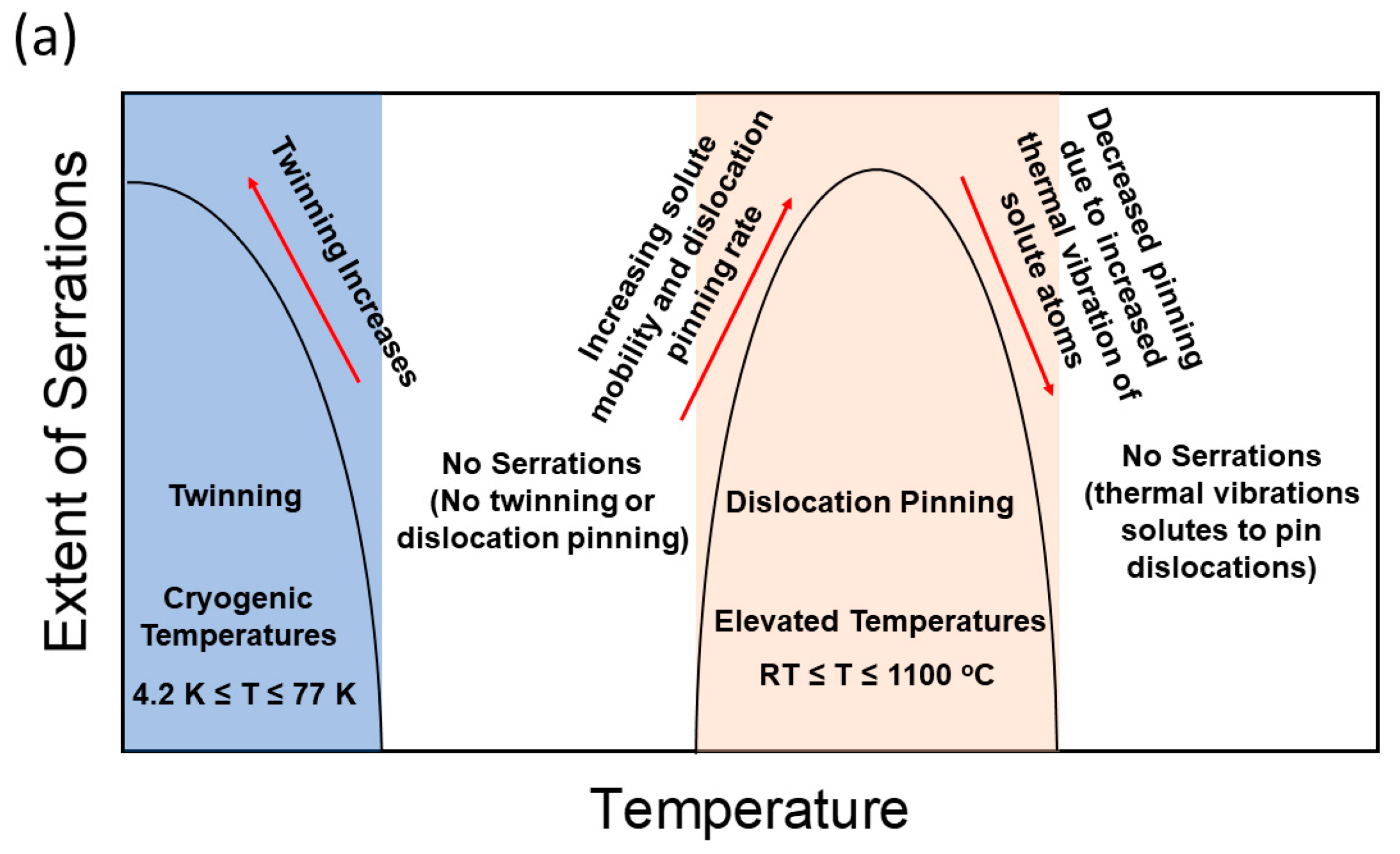
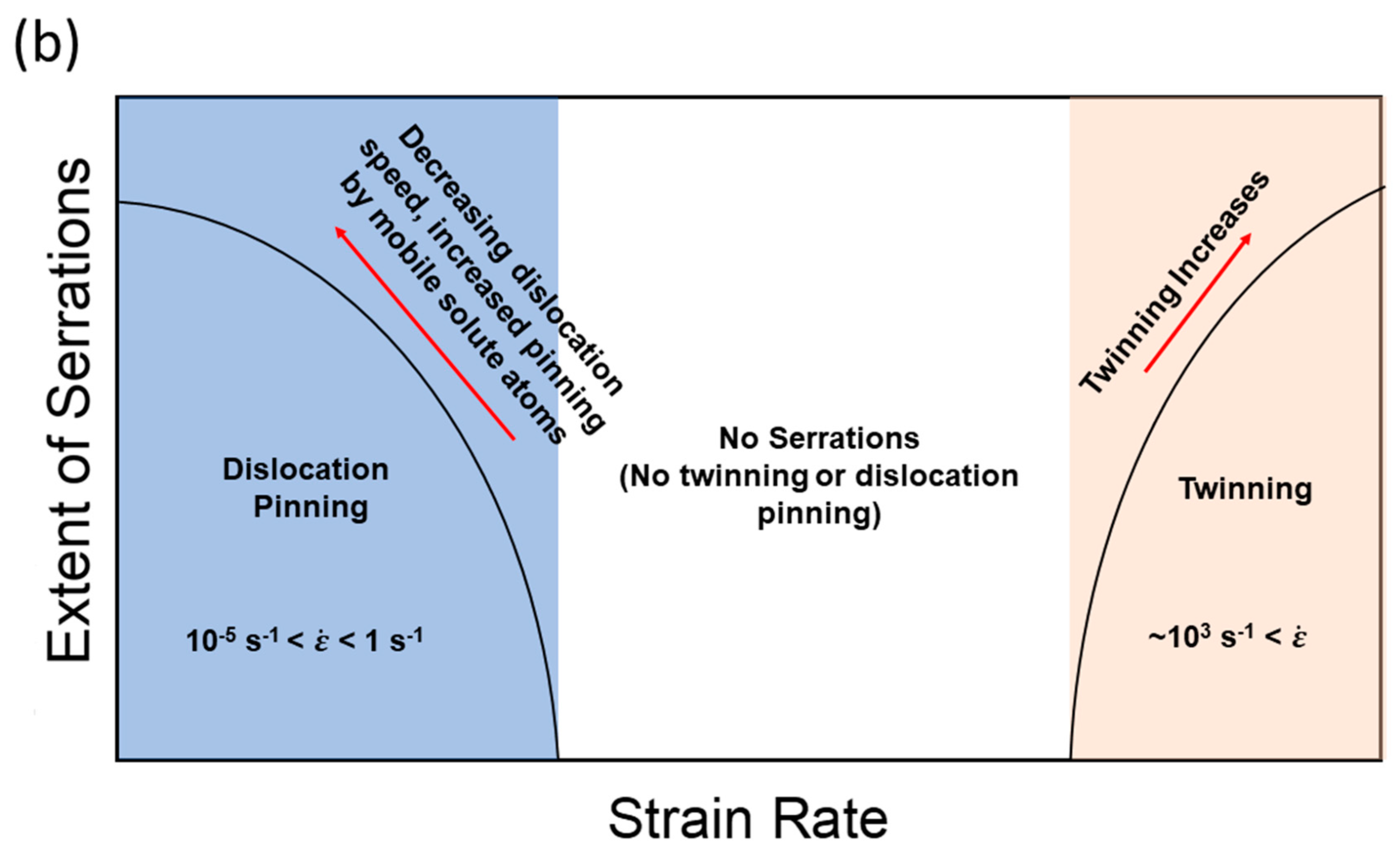
| Material System | Serration Mechanism |
|---|---|
| Crystalline Alloys (including HEAs) | Dislocation pinning by solute atoms or nanoparticles, mechanical twinning, order–disorder transformations, phase transformations, yielding across fracture surfaces. |
| Amorphous Alloys (BMGs) | Excess free volume generation, flow defect and liquid-like site agglomeration, shear band initiation and propagation. |
| Strain Rate (s−1) | Temperature (°C) | Serration Type |
|---|---|---|
| 5 × 10−5 | 400 | A |
| 500 | B | |
| 600 | C | |
| 2 × 10−4 | 400 | A |
| 500 | B | |
| 600 | C | |
| 2 × 10−3 | 400 | A |
| 500 | A | |
| 600 | C |
| Strain Rate (s−1) | Temperature (°C) | Serration Type |
|---|---|---|
| 1 × 10−3 | 400 | C |
| 500 | C | |
| 600 | C | |
| 700 | B + C | |
| 800 | B |
| Strain Rate (s−1) | Temperature (°C) | Serration Type |
|---|---|---|
| 1 × 10−4 | 200 | A |
| 300 | A + B | |
| 400 | B + C | |
| 5 × 10−4 | 300 | A |
| 400 | A + B | |
| 1 × 10−3 | 300 | A |
| 400 | A + B | |
| 500 | B + C |
| Strain Rate (s−1) | Temperature (°C) | Serration Type |
|---|---|---|
| 1 × 10−4 | 300 | A |
| 400 | B | |
| 500 | B | |
| 600 | C | |
| 1 × 10−3 | 300 | A |
| 400 | A | |
| 500 | B | |
| 600 | B | |
| 1 × 10−2 | 400 | A |
| 500 | A | |
| 600 | A |
| Strain Rate (s−1) | Temperature (°C) | Serration Type |
|---|---|---|
| 1 × 10−5 | 500 | B + C |
| 1 × 10−4 | B | |
| 3 × 10−4 | 300 | A |
| 400 | A + B | |
| 500 | B | |
| 550 | B + C | |
| 600 | C | |
| 1 × 10−3 | 500 | A + B |
| 5 × 10−3 | A |
| Strain Rate (s−1) | Temperature (°C) | Serration Type |
|---|---|---|
| 1 × 10−3 | 800 | A + B |
| 900 | A + B | |
| 950 | B | |
| 1000 | B | |
| 1 × 10−1 | 800 | A |
| 900 | A + B | |
| 950 | A + B | |
| 1000 | A + B |
| Alloy | Test Type | Strain Rate (s−1) | Temperature (°C) | Serration Type | Source |
|---|---|---|---|---|---|
| CoCrFeMnNi | Tension | 1 × 10−4 | 300 | A | [153] |
| 400 | B | ||||
| 500 | B | ||||
| 600 | C | ||||
| 1 × 10−3 | 300 | A | |||
| 400 | A | ||||
| 500 | B | ||||
| 600 | B | ||||
| 1 × 10−2 | 400 | A | |||
| 500 | A | ||||
| 600 | A | ||||
| CoCrFeMnNi | Tension | 1 × 10−5 | 500 | B + C | [163] |
| 1 × 10−4 | B | ||||
| 3 × 10−4 | 300 | A | |||
| 400 | A + B | ||||
| 500 | B | ||||
| 550 | B + C | ||||
| 600 | C | ||||
| 1 × 10−3 | 500 | A + B | |||
| 5 × 10−3 | A | ||||
| CoCrFeMnNi (C ~0.9 at.%) | Tension | 1.6 × 10−3 | RT | A | [192] |
| CoCuFeNiTi | Compression | 1 × 10−3 | 800 | A + B | [162] |
| 900 | A + B | ||||
| 950 | B | ||||
| 1000 | B | ||||
| 1 × 10−1 | 800 | A | |||
| 900 | A + B | ||||
| 950 | A + B | ||||
| 1000 | A + B | ||||
| Al0.5CoCrCuFeNi | Compression | 5 × 10−5 | 400 | A | [180] |
| 500 | B | ||||
| 600 | C | ||||
| 2 × 10−4 | 400 | A | |||
| 500 | B | ||||
| 600 | C | ||||
| 2 × 10−3 | 400 | A | |||
| 500 | A | ||||
| 600 | C | ||||
| Al0.3CoCrFeNi | Compression | 1 × 10−3 | 400 | C | [169] |
| 500 | C | ||||
| 600 | C | ||||
| 700 | B + C | ||||
| 800 | B | ||||
| Al0.5CoCrFeNi | Tension | 1 × 10−4 | 200 | A | [94] |
| 300 | A + B | ||||
| 400 | B + C | ||||
| 5 × 10−4 | 300 | A | |||
| 400 | A + B | ||||
| 1 × 10−3 | 300 | A | |||
| 400 | A + B | ||||
| 500 | B + C | ||||
| AlCoCrFeNi | Compression | 1 × 10−3 | 1100 | C | [303] |
| 1 | B | ||||
| Al0.4CrMnFeCoNi | Tension | 3 × 10−4 | 300 | A + B | [304] |
| 400 | B | ||||
| 500 | B + C | ||||
| 600 | C | ||||
| Al0.5CrMnFeCoNi | Tension | 3 × 10−4 | 300 | A + B | [304] |
| 400 | B | ||||
| 500 | B + C | ||||
| Al0.6CrMnFeCoNi | Tension | 3 × 10−4 | 300 | A + B | [304] |
| 400 | B | ||||
| 500 | C |
© 2020 by the authors. Licensee MDPI, Basel, Switzerland. This article is an open access article distributed under the terms and conditions of the Creative Commons Attribution (CC BY) license (http://creativecommons.org/licenses/by/4.0/).
Share and Cite
Brechtl, J.; Chen, S.; Lee, C.; Shi, Y.; Feng, R.; Xie, X.; Hamblin, D.; Coleman, A.M.; Straka, B.; Shortt, H.; et al. A Review of the Serrated-Flow Phenomenon and Its Role in the Deformation Behavior of High-Entropy Alloys. Metals 2020, 10, 1101. https://doi.org/10.3390/met10081101
Brechtl J, Chen S, Lee C, Shi Y, Feng R, Xie X, Hamblin D, Coleman AM, Straka B, Shortt H, et al. A Review of the Serrated-Flow Phenomenon and Its Role in the Deformation Behavior of High-Entropy Alloys. Metals. 2020; 10(8):1101. https://doi.org/10.3390/met10081101
Chicago/Turabian StyleBrechtl, Jamieson, Shuying Chen, Chanho Lee, Yunzhu Shi, Rui Feng, Xie Xie, David Hamblin, Anne M. Coleman, Bradley Straka, Hugh Shortt, and et al. 2020. "A Review of the Serrated-Flow Phenomenon and Its Role in the Deformation Behavior of High-Entropy Alloys" Metals 10, no. 8: 1101. https://doi.org/10.3390/met10081101
APA StyleBrechtl, J., Chen, S., Lee, C., Shi, Y., Feng, R., Xie, X., Hamblin, D., Coleman, A. M., Straka, B., Shortt, H., Spurling, R. J., & Liaw, P. K. (2020). A Review of the Serrated-Flow Phenomenon and Its Role in the Deformation Behavior of High-Entropy Alloys. Metals, 10(8), 1101. https://doi.org/10.3390/met10081101









